Olympus Medical Systems EC-S10 Low Power Transmitter User Manual
Olympus Medical Systems Corp. Low Power Transmitter Users Manual
Users manual
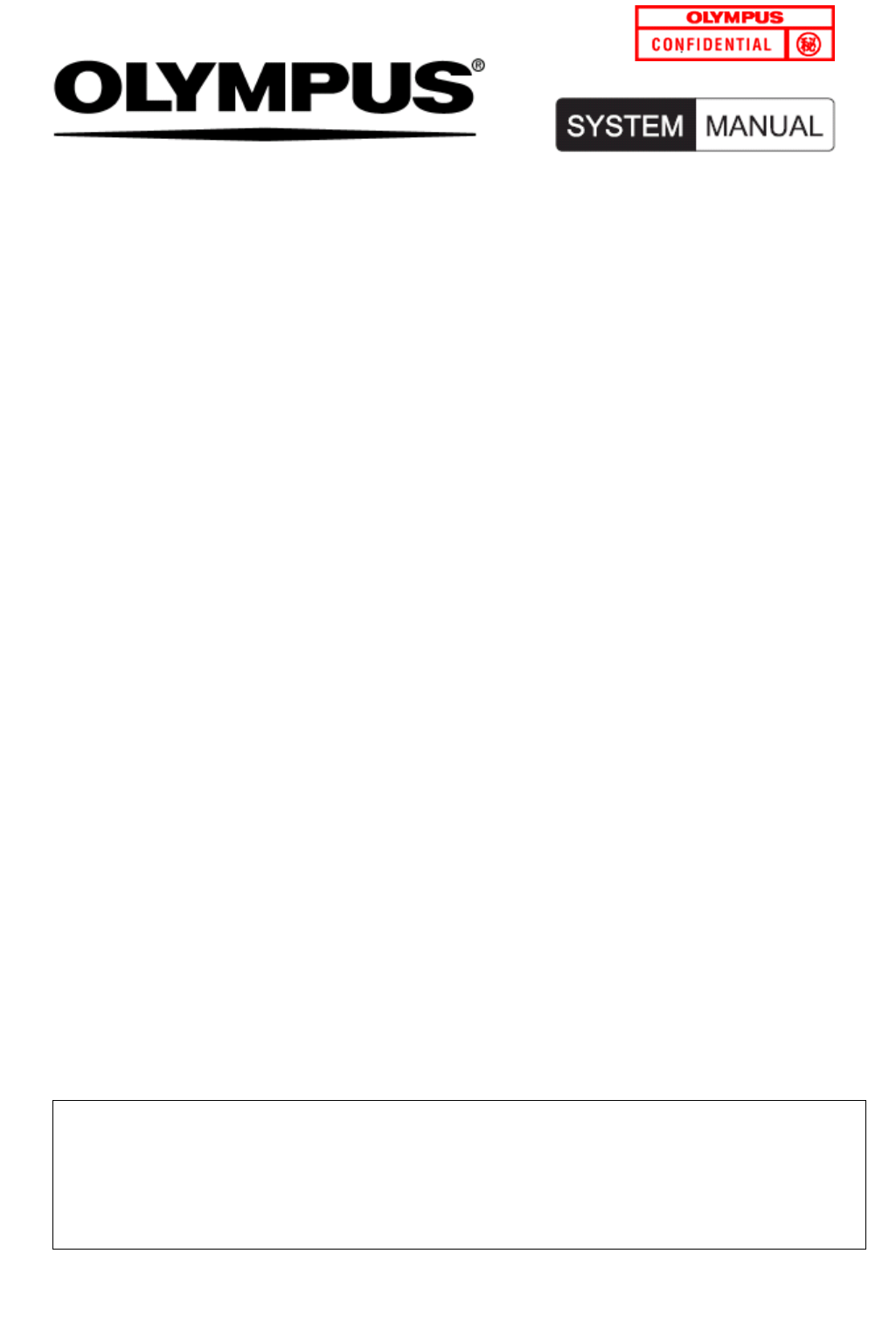
OLYMPUS CAPSULE ENDOSCOPE SYSTEM SYSTEM MANUAL
1
INSTRUCTIONS
OLYMPUS CAPSULE ENDOSCOPE SYSTEM
CAPSULE ENDOSCOPE SYSTEM SET MAJ-Y0136
MAJ-Y0136
CAPSULE ENDOSCOPE
EC-Y0005
Refer to the companion manual, the “WORKSTATION MANUAL” and “Cautions for Capsule
Endoscopy Patient” for operating information of the MAJ-Y0134.
USA:CAUTION:Investigational device. Limited by Federal (or United State) Law to investigational use.

2
OLYMPUS CAPSULE ENDOSCOPE SYSTEM SYSTEM MANUAL
Contents
Labels and Symbols.................................................................................................................................1
Symbols...................................................................................................................................................1
Labels......................................................................................................................................................2
Important Information — Please Read Before Use...............................................................................9
Intended use ...........................................................................................................................................9
Instruction manual...................................................................................................................................9
User qualifications.................................................................................................................................10
Instrument compatibility ........................................................................................................................10
Repair and modification ........................................................................................................................10
Signal words..........................................................................................................................................11
Dangers, warnings and cautions ..........................................................................................................12
Danger, warning and cautions for patients ...........................................................................................21
Expiration date of the capsule endoscope............................................................................................23
Color Tone of the Capsule Endoscope Image......................................................................................24
EMC (Electromagnetic Compatibility)...................................................................................................27
Limits of the technology ........................................................................................................................27
Chapter 1 Checking the Package Contents.........................................................................................28
1.1 Capsule endoscope system MAJ-Y0136 (MAJ-Y0136) .................................................................29
1.2 Capsule endoscope (EC-Y0005)....................................................................................................30
Chapter 2 Nomenclature and Functions ..............................................................................................32
2.1 System components .......................................................................................................................32
2.2 Capsule endoscope (EC-Y0005)....................................................................................................34
2.3 Antenna unit (X432262-21).............................................................................................................35
2.4 Recorder unit (X432262-11) ...........................................................................................................36
2.5 Recorder unit cradle (X432262-31) ................................................................................................38
2.6 Recorder unit harness (X432251-40) .............................................................................................39
2.7 Antenna harness (X432252-51)......................................................................................................40
2.8 Capsule activator (MAJ-1478) ........................................................................................................41
2.9 Battery pack (X432262-11-12)........................................................................................................41
2.10 Workstation (MAJ-Y0134).............................................................................................................41
Chapter 3 Installation and Connection.................................................................................................42
3.1 Preparation......................................................................................................................................42
3.2 Exterior............................................................................................................................................43
3.3 Capsule endoscope ........................................................................................................................43
3.4 Preparation of the recorder unit......................................................................................................44
3.5 Preparation of the recorder unit cradle ...........................................................................................46
Chapter 4 Operation ...............................................................................................................................48
4.1 Preparation and Inspection before examination.............................................................................48
4.2 Attaching the equipment to the patient ...........................................................................................54
4.3 Preparing the capsule endoscope ..................................................................................................62
4.4 Starting the examination .................................................................................................................82
4.5 During the examination...................................................................................................................83
4.6 Ending the examination ..................................................................................................................85
Chapter 5 Care, Storage and Disposal.................................................................................................91
5.1 Care.................................................................................................................................................91
5.2 Storage............................................................................................................................................92
i

Contents
OLYMPUS CAPSULE ENDOSCOPE SYSTEM SYSTEM MANUAL
3
5.3 Disposal ..........................................................................................................................................93
Chapter 6 Troubleshooting....................................................................................................................94
6.1 Troubleshooting ..............................................................................................................................94
6.2 Returning the system for repair ......................................................................................................98
Appendix..................................................................................................................................................99
Transportation, storage, and operation environment ...........................................................................99
Specifications ......................................................................................................................................103
ii

OLYMPUS CAPSULE ENDOSCOPE SYSTEM SYSTEM MANUAL
1
Labels and Symbols
Safety-related labels and symbols are attached at the locations shown below. If
labels or symbols are missing or illegible, contact Olympus.
Symbols
The meaning(s) of the symbol(s) shown on the package, the back cover of this
instruction manual and/or this equipment are as follows:
Caution, refer to instructions.
Refer to instructions.
When this equipment is in the proximity of portable RF (Radio
Frequency) communication devices, electromagnetic
interference that affects cardiac pacemakers may occur. Users
of cardiac pacemakers must maintain a sufficient distance
from the equipment.
Power switch (ON/OFF)
TYPE BF applied part
Single use only
Use by (expiration date)
Sterilized using ethylene oxide
Non-sterile
Manufacturer
Authorized representative in the European Community
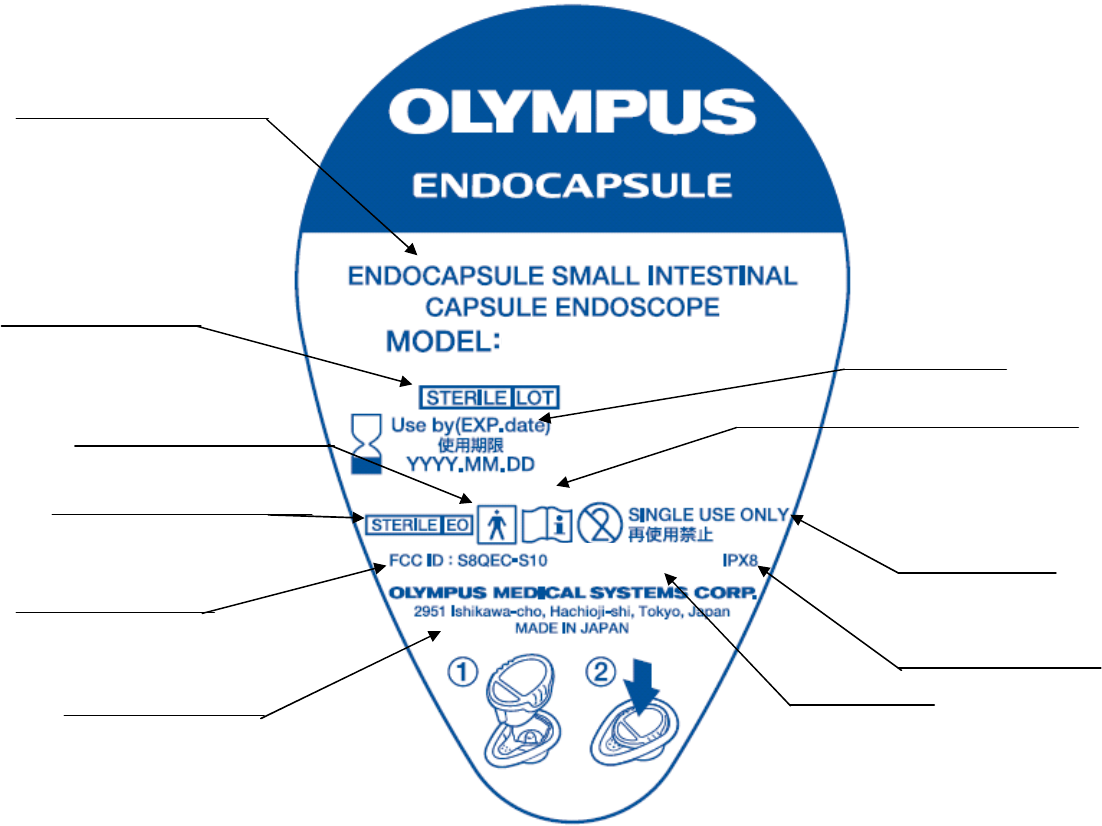
2
OLYMPUS CAPSULE ENDOSCOPE SYSTEM SYSTEM MANUAL
Labels
Capsule endoscope
Capsule endoscope storage case (Label 1)
OLYMPUS EC-Y0005
OLYMPUS EC-Y0005OLYMPUS EC-Y0005
OLYMPUS EC-Y0005
IC : 4763B-ECS10
IC : 4763B-ECS10IC : 4763B-ECS10
IC : 4763B-ECS10
Ster
ilization lot number
Expiration date
TYPE BF applied part marking
Sterilized with ethylene oxide
Product name and model name
Protection against fluid ingress
Refer to instructions
Single use only
Manufacture details
FCC ID number
IC numb
er
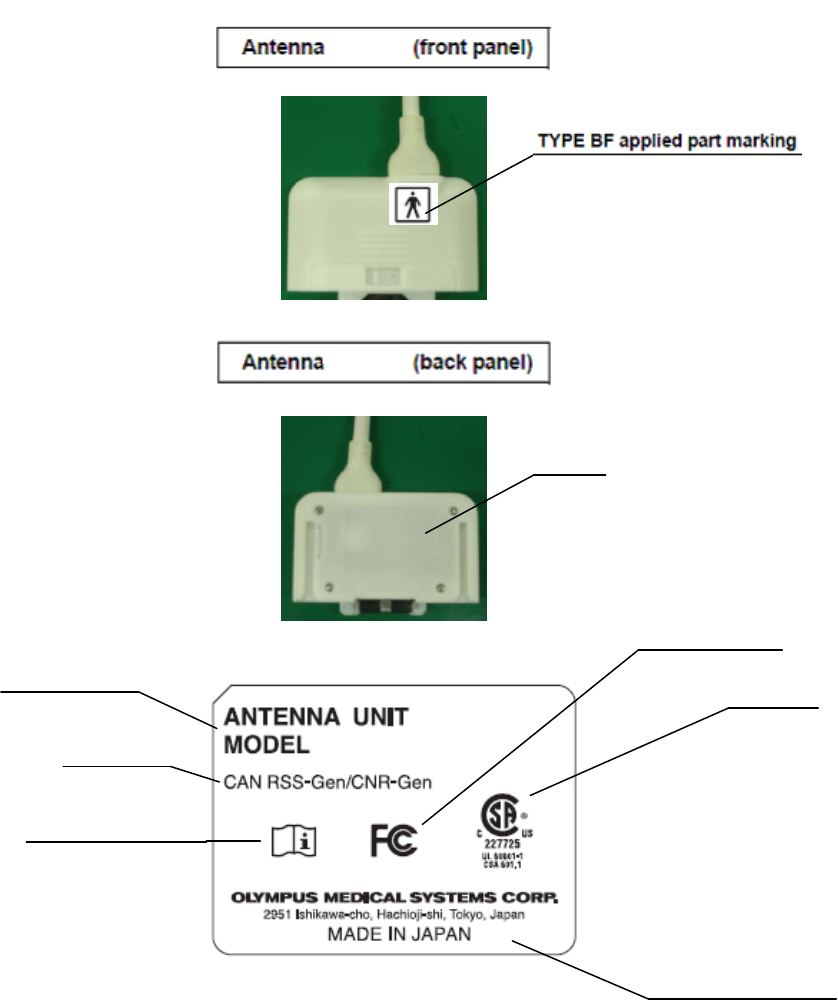
OLYMPUS CAPSULE ENDOSCOPE SYSTEM SYSTEM MANUAL
3
Antenna unit
X432262-21
X432262-21X432262-21
X432262-21
Label
Label
Un
i
t
Unit
Model name
Manufacturer details
IC note
Refer to instructions
FCC marking
CSA marking
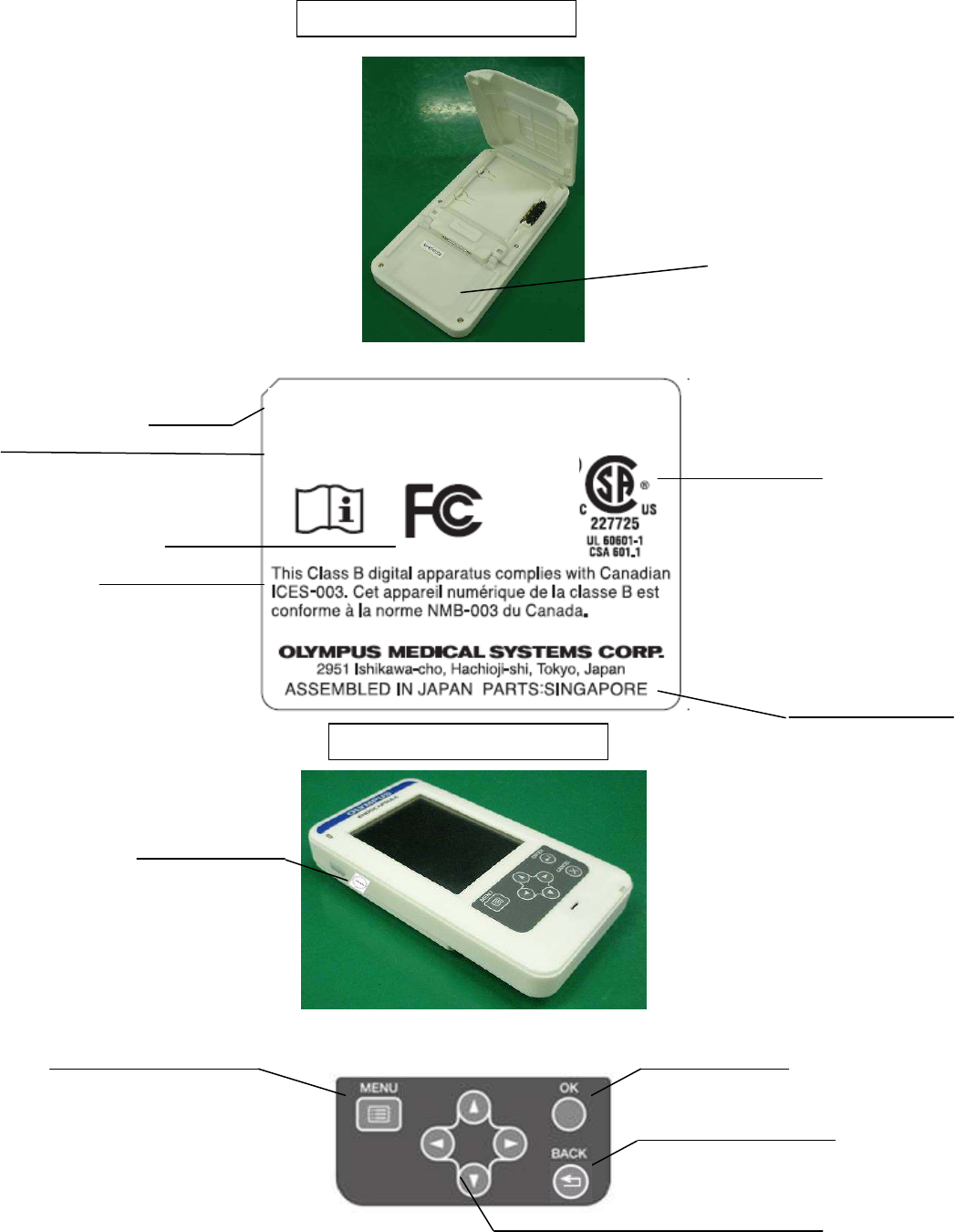
4
OLYMPUS CAPSULE ENDOSCOPE SYSTEM SYSTEM MANUAL
Recorder unit
INPUT 5V-3A(from X432262-31)
INPUT 5V-3A(from X432262-31) INPUT 5V-3A(from X432262-31)
INPUT 5V-3A(from X432262-31)
RECORDER OLYMPUS RE-10
RECORDER OLYMPUS RE-10RECORDER OLYMPUS RE-10
RECORDER OLYMPUS RE-10
MODEL X432262-11
MODEL X432262-11MODEL X432262-11
MODEL X432262-11
INPUT 3.7V-500mA(FromX432262-11-12)
INPUT 3.7V-500mA(FromX432262-11-12)INPUT 3.7V-500mA(FromX432262-11-12)
INPUT 3.7V-500mA(FromX432262-11-12)
Rec
order unit (back panel
)
Recorder unit (
front
panel
)
MENU button
BACK button
OK button
“
”, “”, “⊳” , “” : Cursor button
Model
Manufacturer details
Electrical rating / Input power
Power switch
IC note
FCC marking
CSA marking
Label
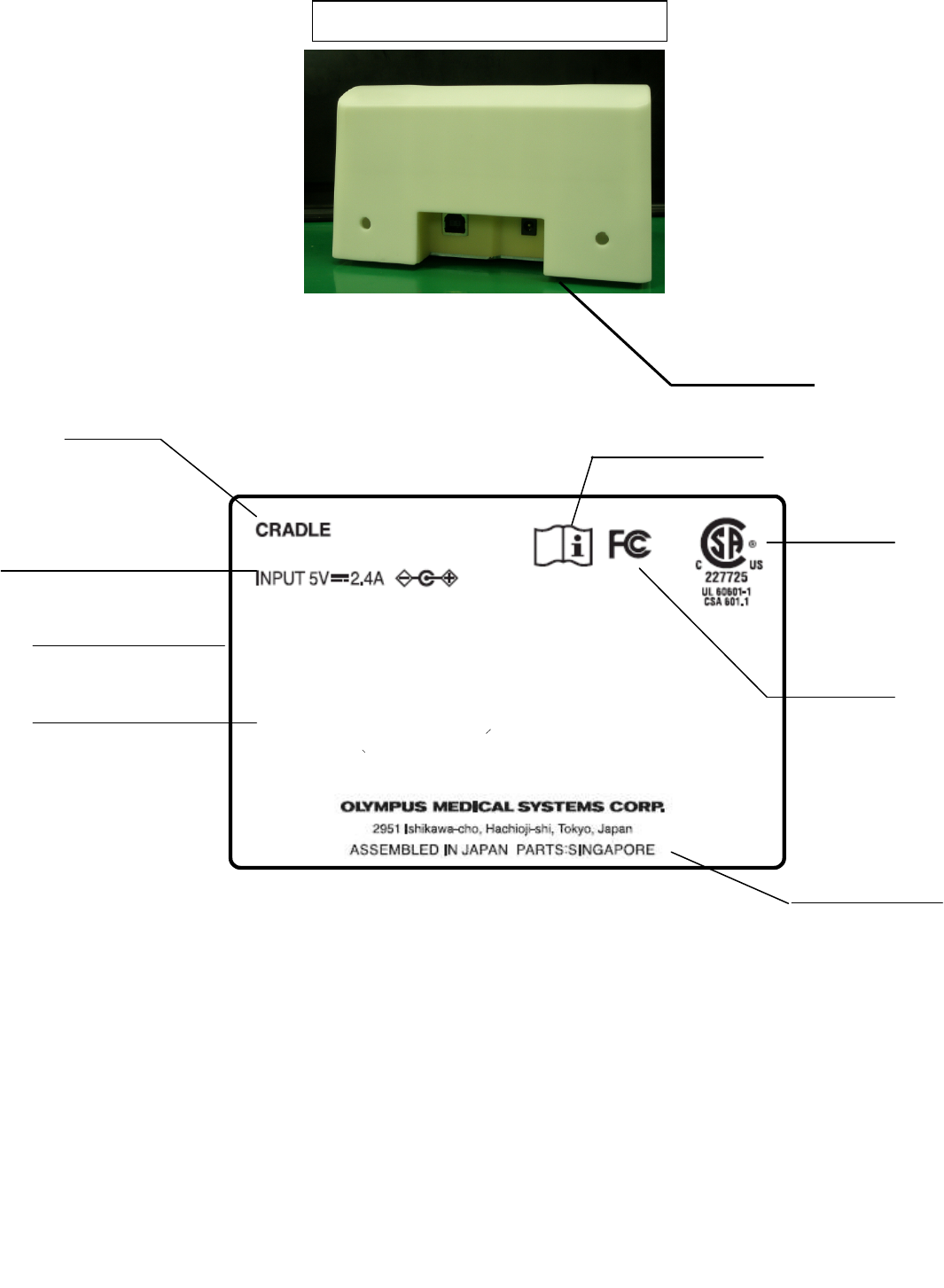
OLYMPUS CAPSULE ENDOSCOPE SYSTEM SYSTEM MANUAL
5
Recorder unit cradle
MODEL X432262-31
MODEL X432262-31MODEL X432262-31
MODEL X432262-31
This device complies with Part 15 of the FCC Rules.
This device complies with Part 15 of the FCC Rules.This device complies with Part 15 of the FCC Rules.
This device complies with Part 15 of the FCC Rules.
Operation is subject to the following two condtions:
Operation is subject to the following two condtions:Operation is subject to the following two condtions:
Operation is subject to the following two condtions:
(1)This device may not cause harmful interference,and
(1)This device may not cause harmful interference,and(1)This device may not cause harmful interference,and
(1)This device may not cause harmful interference,and
(2)this device must accept any interference received,
(2)this device must accept any interference received,(2)this device must accept any interference received,
(2)this device must accept any interference received,
Including interference that may cause undesired operation.
Including interference that may cause undesired operation.Including interference that may cause undesired operation.
Including interference that may cause undesired operation.
This Class B digital apparatus complies with Canadian
This Class B digital apparatus complies with CanadianThis Class B digital apparatus complies with Canadian
This Class B digital apparatus complies with Canadian
ICES-003. Cet appareil numerique de la Classe B est
ICES-003. Cet appareil numerique de la Classe B estICES-003. Cet appareil numerique de la Classe B est
ICES-003. Cet appareil numerique de la Classe B est
conforme a la norme NMB-003 du Canada.
conforme a la norme NMB-003 du Canada.conforme a la norme NMB-003 du Canada.
conforme a la norme NMB-003 du Canada.
Label
Recorder unit cradle (bottom panel)
Refer to instructions
Electrical rating / Input power
FCC note
Manufacturer details
Model name
IC note
CSA marking
FCC marking
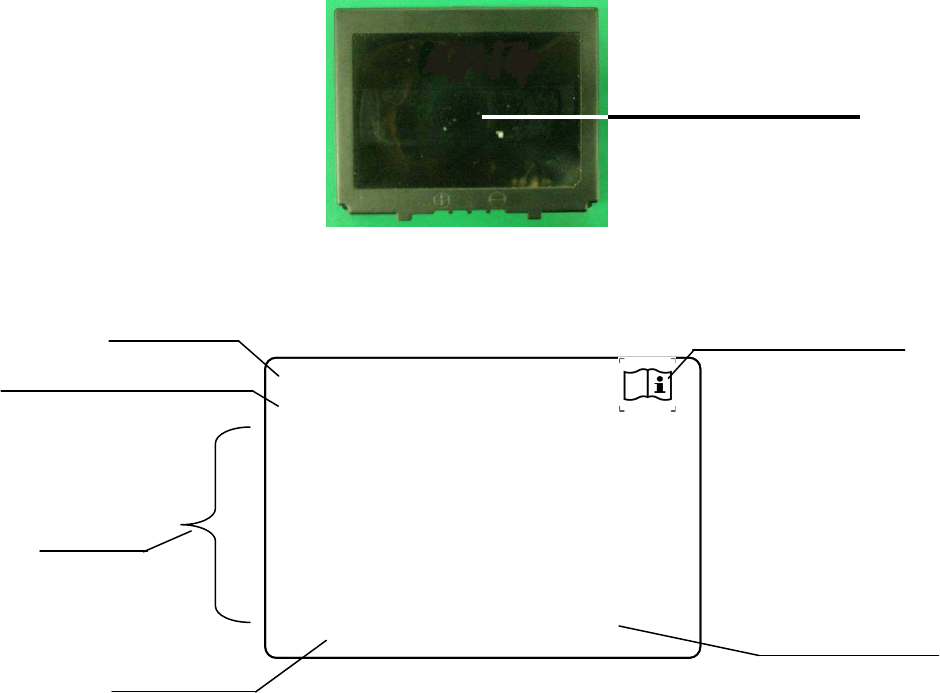
6
OLYMPUS CAPSULE ENDOSCOPE SYSTEM SYSTEM MANUAL
Battery pack
Battery pack MODEL X432262-11-12
OUTPUT 3.7V 2860mAh 10.5Wh
WARNING: Use this Battery pack only X432262-11
Keep away from heat or frame.
Don’t make the battery pack charged, used, or
lift under high temperature conditions.
Don’t short circuit, disassemble or reconstruct.
Don’t drop, avoid physical shock.
Don’t make the Battery pack contacted with
water, chemical or any other liquid.
Keep away from metal objects.
OLYMPUS MEDICAL SYSTEMS CORP
.
S/N 110K001 MADE IN JAPAN
Battery pack MODEL X432262-11-12
OUTPUT 3.7V 2860mAh 10.5Wh
WARNING: Use this Battery pack only X432262-11
Keep away from heat or frame.
Don’t make the battery pack charged, used, or
lift under high temperature conditions.
Don’t short circuit, disassemble or reconstruct.
Don’t drop, avoid physical shock.
Don’t make the Battery pack contacted with
water, chemical or any other liquid.
Keep away from metal objects.
OLYMPUS MEDICAL SYSTEMS CORP
.
S/N 110K001 MADE IN JAPAN
Label
Refer to instructions
Manufacturer details
WARNING
Serial number
Electrical rating / Input power
Model name
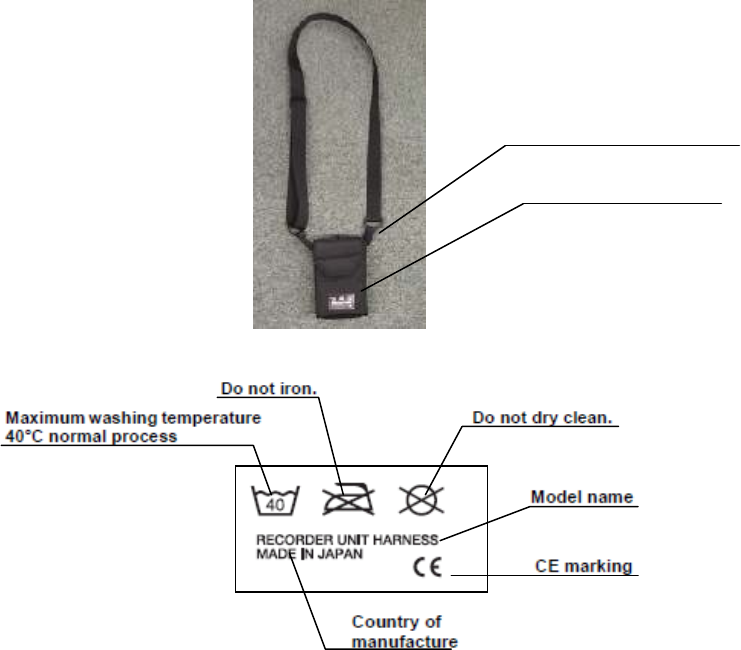
OLYMPUS CAPSULE ENDOSCOPE SYSTEM SYSTEM MANUAL
7
Recorder unit harness
Label
Model No.
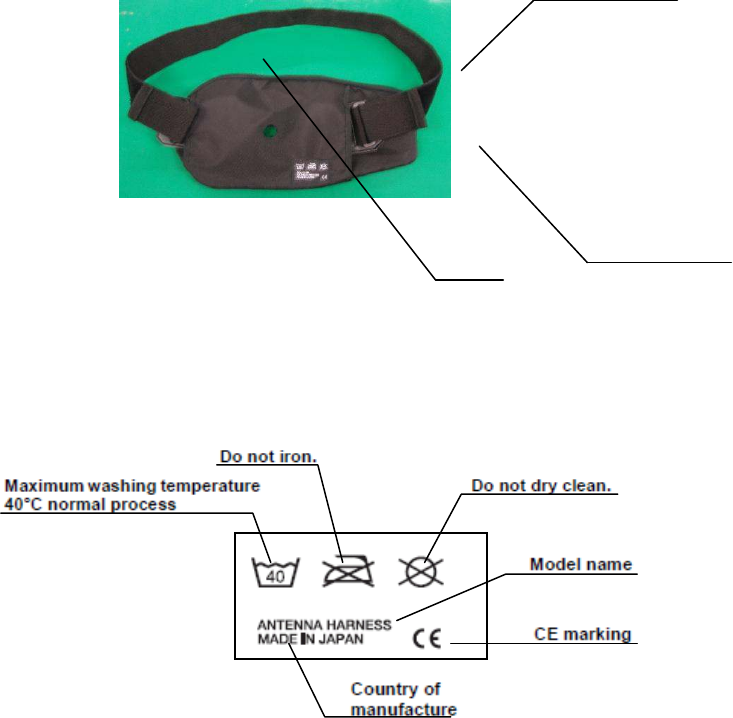
8
OLYMPUS CAPSULE ENDOSCOPE SYSTEM SYSTEM MANUAL
Antenna harness
Manufactur
Model name
Label
OLYMPUS CAPSULE ENDOSCOPE SYSTEM SYSTEM MANUAL
9
Important Information — Please Read
Before Use
Intended use
The OLYMPUS CAPSULE ENDOSCOPE SYSTEM has been designed to be
used for visualization of the small intestine mucosa. The Red Color Detection
Function is intended to mark frames of the video suspected of containing blood
or red areas. Do not use this system for any purpose other than its intended use.
Instruction manual
This instruction manual contains essential information on using the system
safely and effectively. Before use, thoroughly review this manual and the
manuals of all equipment that will be used during the procedures, and use the
equipment as instructed.
Note that the complete instruction manual for this system consists of following
parts: this manual, the “WORKSTATION MANUAL”, and the “Cautions for
Capsule Endoscopy Patient”.
Keep this and all related instruction manuals in a safe, accessible location.
If you have any questions or comments about any information in this manual,
please contact Olympus.
Terms used in this manual
DC magnetic field
Magnetic field formed by permanent magnets or electromagnets that are
used in health devices and audio speakers.
RTC (Real time clock)
Refers to the recorder unit’s internal clock.
10
OLYMPUS CAPSULE ENDOSCOPE SYSTEM SYSTEM MANUAL
User qualifications
The operator of this instrument must be a physician or medical personnel under
the supervision of a physician and must have received sufficient training in
capsule endoscopy procedures. This manual, therefore, does not explain or
discuss capsule endoscopy procedures.
Physicians performing capsule endoscopy should:
− Have completed a formal training program that includes
training in the recognition and management of small
intestinal diseases
− Have competency and privileges to perform
gastrointestinal endoscopy
− Be familiar with the Endo Capsule hardware and software
− Have formal training in capsule endoscopy that includes
hands-on training and supervised review of initial cases
by a competent capsule endoscopist
− Meet pertinent local hospital/clinic requirements and
professional society credentialing guidelines.
Instrument compatibility
Refer to the “System chart” in the Appendix to confirm that the system is
compatible with the ancillary equipment being used. Using incompatible
equipment can result in patient injury and/or equipment damage.
Repair and modification
This system does not contain any user-serviceable parts. Do not disassemble,
modify or attempt to repair it. Doing so may result in patient or user injury and/or
equipment damage.
Some problems that appear to be malfunctions may be correctable by referring
to Chapter 5, “Troubleshooting”. If the problem cannot be resolved using the
information in Chapter 5, contact Olympus.

OLYMPUS CAPSULE ENDOSCOPE SYSTEM SYSTEM MANUAL
11
Signal words
The following signal words are used throughout this manual.
Indicates an imminently hazardous situation which, if not
avoided, will result in death or serious injury.
Indicates a potentially hazardous situation which, if not
avoided, could result in death or serious injury.
Indicates a potentially hazardous situation which, if not
avoided, may result in minor or moderate injury.
It may also be used to alert against unsafe practices or
potential equipment damage.
Indicates additional helpful information.

12
OLYMPUS CAPSULE ENDOSCOPE SYSTEM SYSTEM MANUAL
Dangers, warnings and cautions
Follow the dangers, warnings and cautions given below when handling the
system. This information is to be supplemented by the dangers, warnings and
cautions given in each chapter.
• This system is contraindicated to patients with the following conditions.
− Patients with cardiac pacemakers or other implanted electronic devices
(e.g., defibrillators)
(Cardiac pacemakers or other implanted electronic
devices may malfunction due to the RF (radio frequency)
interference.)
− Patients with known intestinal strictures, adhesions,
diverticulum, obstruction, or fistulas that may block the
passage of the capsule endoscope
(Patients with these physical features risk retention of the
capsule endoscope.)
− Patients with known dysphagia
(Patients with dysphagia may have a risk of aspiration into
the tracheal branches and could have difficulty ingesting
the capsule endoscope.)
− Patients with significant difficulty in swallowing a tablet as
large as capsule endoscope
(Patients that may have difficulty ingesting a capsule as
large as the capsule endoscope risk getting the capsule
lodged in their throat.)
− Patients who are nonsurgical candidates
Open surgery is required if the capsule endoscope is
retained in the patient’s body.
− Patients who are pregnant
Use of the capsule endoscope has not yet been proven to
be safe on pregnant patients.
− Patients with significant gastrointestinal tract delay
Long-term retention of the capsule endoscope may be
observed in patients with known radiation enteritis due to
intestinal strictures or adhesions.
− Patients diagnosed with radiation enteritis
Long-term retention of the capsule endoscope may be
observed in patients with known radiation enteritis due to
intestinal strictures or adhesions.

OLYMPUS CAPSULE ENDOSCOPE SYSTEM SYSTEM MANUAL
13
• Instruct of the patient to stay away from equipment that
generates strong electromagnetic fields (such as MRI
equipment), between ingestion and excretion of the capsule
endoscope. Otherwise, injury within the body cavity may
occur. If the excretion of the capsule endoscope has not
been confirmed, within 2 weeks after ingestion, attempt to
locate the capsule endoscope within the patient’s body by
X-ray examination.
• Safety of the Capsule Endoscope has been confirmed by
durability and biocompatibility testing for a patient retention
period of 30 days. Patient safety has not been verified if the
capsule endoscope remains within the patient’s body for a
period of 30 days or more. If excretion of the capsule
endoscope has not been confirmed within 30 days after
ingestion, conduct an X-ray examination in an attempt to
locate the capsule endoscope. Once found, remove the
capsule endoscope. First of all, perform procedure except for
surgical intervention. For methods to remove the capsule
endoscope, please follow the respective guidelines in your
country.
• This system is contraindicated to patients with the following
conditions.
− Patients who have an obstruction in their digestive tract
as a result of past digestive bypass surgery
A patient who has undergone bypass surgery in the
digestive tract usually has an obstruction that could result
in retention of the capsule endoscope.
− Patients with instruments that could interfere with the
capsule endoscope’s passage in the digestive tract such
as a stent in the digestive tract
A patient with an instrument in their digestive tract (such
as a stent) may have sections that are too narrow for the
capsule endoscope to pass through.
• Prior to the examination, the physician should explain to the
patient the risks of capsule endoscope retention and obtain
the patient’s informed consent.

14
OLYMPUS CAPSULE ENDOSCOPE SYSTEM SYSTEM MANUAL
• Prior to using the capsule endoscope, the physician should
consider performing a contrasted X-ray series in patients with
the following conditions. Patients with suspected intestinal
strictures, adhesions, diverticulum, obstructions, fistulas that
may block the passage of the capsule endoscope, and
patients with suspected gastrointestinal tract delay.
− Patients with a history of ileus or small intestinal strictures
− Patients diagnosed with, or suspected to have, Crohn’s
disease in small intestine
− Patients with any history of abdominal surgery, pelvic
surgery, and/or radiological treatment
• The physician should confirm that the contrast medium
reaches the ileocecal valve and should continuously
observe/trace the entire small-intestine during the contrasted
X-ray series. Do not use the capsule endoscope on the
patient if any of the following conditions is observed during
the contrast X-ray series.
− Patients with known intestinal strictures, adhesions,
diverticulum, obstructions, or fistulas that may block the
passage of the capsule endoscope.
− Patients with significant gastrointestinal tract delay.
• The peristaltic motion in the small intestine varies among
individuals. Therefore, the recording time in the small
intestine may differ among patients. Though this system is
designed to obtain the images for 12 hours, image recording in
a patient with slower peristaltic motion may finish before the
capsule endoscope reaches the patient’s large intestine.
• In order to implement the examination smoothly, the
physician should hand the “Cautions for capsule endoscopy
patient” that comes packed with the capsule endoscope
(EC-Y0005) to the patient at least one day before the
examination and verify that the patient understands it
thoroughly.
• The physician should explain to the patient the risks of
retention in the examination and obtain the patient’s informed
consent before the examination. The capsule endoscope
may cause unexpected intestinal obstruction that may
require surgery.
• Write your emergency contact number in the “Please provide
your emergency contact number” section on the back page of
the “Cautions for capsule endoscopy patient” that is packed
with the capsule endoscope (EC-Y0005), hand it to the
patient and instruct him/her to immediately contact the
number if he/she feels abdominal pain, discomfort, or nausea
after ingesting the capsule endoscope. If treatment is
delayed, patient injury may result.

OLYMPUS CAPSULE ENDOSCOPE SYSTEM SYSTEM MANUAL
15
• A negative or normal result obtained by the imaging capsule
does not exclude the presence of pathology and if symptoms
persist, further evaluation should be performed.
• The capsule endoscope must be ingested under the
supervision of the physician or medical personnel authorized
by the physician.
• Never install and/or operate this system in locations where:
− Concentration of oxygen is high.
− Oxidizing agents (such as nitrous oxide (N
2
O)) are
present in the atmosphere.
− Flammable anesthetics are present in the atmosphere.
Otherwise, explosion or fire may result because this system
Is not explosion-proof.
• The capsule endoscope is a TYPE BF applied part, which
means that application to the heart is prohibited. Do not use it
for the purpose of observing or treating the heart.
• The capsule endoscope is a sterilized single-use product.
Reusing a capsule endoscope may cause infection to the
patient and/or medical personnel and internal injury to the
patient. Also, severe equipment malfunctions may occur.
Never reuse a capsule endoscope.
• Do not use a capsule endoscope that has been dropped,
bitten, or subjected to excessive pressure. Doing so may
result in internal injury to the patient.
• When using the capsule endoscope, avoid using other
medical electrical devices simultaneously. The safety of the
use of the capsule endoscope in combination with other
medical electrical devices has not been verified.
• The capsule endoscope may accidentally enter the trachea.
Before the examination, check whether the patient is able to
swallow the capsule endoscope safely. If accidental entry
occurs, immediately remove the capsule endoscope from the
trachea.
• Do not disassemble or modify the battery pack. The battery
pack is equipped with a safety circuit and a protective circuit.
Disabling either or both of these circuits may result in
excessive heat, release of smoke, explosion, and/or a fire.
• Do not connect the positive (+) and negative (–) terminals of
the battery pack using pieces of metal. In addition, do not
store or transport the battery pack alongside other metallic
objects. The battery pack may be short-circuited, causing an
overflow of current, resulting in excessive heat, release of
smoke, explosion, and/or a fire from the battery, or excessive
heating of the metallic item.

16
OLYMPUS CAPSULE ENDOSCOPE SYSTEM SYSTEM MANUAL
• Do not heat the battery pack or bring it in contact with fire.
The insulating material may melt, gas could be released, the
safety circuit may be damaged, and electrolytic solution may
be ignited, causing excessive heat, release of smoke,
explosion, and/or a fire.
• Do not use or store the battery pack near flames or a source
of high temperature (over 80°C (176°F)) such as a stove. If
the plastic separator is damaged by heat, the battery pack
will be short-circuited internally, causing excessive heat,
release of smoke, explosion, and/or a fire.
• Keep the battery pack away from water or any other liquids. If
the internal protective circuit becomes wet and/or damaged,
it may result in excessive heat, release of smoke, explosion,
and/or a fire.
• Do not recharge the battery pack near an open flame, or
under direct sunlight. The protective circuit is activated under
high heat, and may prevent proper recharging. If the
protection circuit fails, recharging may occur at abnormal
current and/or voltage, causing unexpected chemical
reactions within the battery pack, which may result in
excessive heat, release of smoke, explosion, and/or a fire.
• When recharging the battery pack, use only the provided
Recorder unit cradle (X432262-31) under the specified recharging
conditions. Recharging under conditions other than those
specified (temperature outside the specified range) may
cause abnormalities or overcharging, causing unexpected
chemical reactions within the battery pack, which may result
in excessive heat, release of smoke, explosion, and/or a fire.
• Do not strike, pierce, drop, or step on the battery pack. A
ruptured or damaged battery pack may be short-circuited
internally, which could cause excessive heat, release of
smoke, explosion, and/or a fire.
• Do not apply strong shocks to the battery pack. They could
cause the battery pack to leak, generate excessive heat,
release smoke, explode, or ignite. If the protection circuit
fails, recharging may occur at abnormal current and/or
voltage, causing unexpected chemical reactions within the
battery pack, which may result in excessive heat, release of
smoke, explosion, and/or a fire.
• Do not use a battery pack that is visibly damaged or
deformed. Excessive heat, release of smoke, explosion,
and/or a fire may result.
• Use the battery pack only for this equipment. Using the
battery pack in other equipment could cause its performance
to deteriorate rapidly, or, depending on the equipment, cause
damage from overcurrent, excessive heat, release of smoke,
explosion, and/or a fire.

OLYMPUS CAPSULE ENDOSCOPE SYSTEM SYSTEM MANUAL
17
• If a battery pack is leaking, take care that the liquid does not
come in contact with your skin or eyes. If liquid enters the
eye, do not rub it; immediately rinse with clean water, then
consult a physician. Failure to take appropriate action may
result in injury.
• If recharging is not completed after the given recharging time,
do not continue recharging. Excessive heat, release of
smoke, explosion, and/or a fire may result.
• Do not place the battery pack in a microwave or a
high-pressure cooker. Rapid heating or breaking of the
battery pack’s seal may result in excessive heat, release of
smoke, explosion, and/or a fire. In this case, the battery pack
may be damaged. Do not use this battery pack and replace it
with a new one.
• If the operator notices a leak or an abnormal odor from the
battery pack, immediately remove it from any heat source in
the vicinity. The electrolytic solution may ignite, causing
release of smoke, explosion, and/or a fire. Do not use this
battery pack, and replace it with a new one.
• If the operator notices an abnormal odor, excessive heat,
change of color, deformation, or other abnormalities during
use, recharging, or storage of the battery pack, immediately
remove the battery pack from the recorder unit, and do not use the battery
pack. Continued use of the battery pack may result in excessive heat,
release of smoke, explosion, and/or a fire. Use a new battery pack instead.
• Any ancillary diagnostic tests or examinations (e.g. upper GI
endoscopy and colonoscopy) required prior to or in
conjunction with this device should be performed at the
physician’s discretion.
• Do not use the capsule endoscope after its expiration date
because the life of the battery may be insufficient to perform
the entire exam. The expiration date is placed on the label of
the capsule endoscope storage case (see page 2).
• To prevent the capsule endoscope battery from deteriorating,
store the capsule endoscope within a temperature range of 0
– 25°C (32 – 77°F). Do not store the capsule endoscope in a
refrigerator or a freezer because condensation may occur
inside the cover dome.
•Avoid long term use or storage at temperatures exceeding 40°C (104°F).
Battery pack performance may deteriorate rapidly under these conditions.
•Avoid long term use at temperatures below 0°C (32°F). In case of long
term use at temperatures below 0°C (32°F), you should not start the
examination.

18
OLYMPUS CAPSULE ENDOSCOPE SYSTEM SYSTEM MANUAL
• Keep the capsule endoscope away from permanent magnets
or electromagnets. Magnets can turn the capsule endoscope
ON, resulting in the consumption of battery power.
• Keep the capsule activator away from implant devices, such
as cardiac pacemakers, defibrillators, nerve stimulators, and
other equipment that may be affected by DC magnetic fields.
• Before use, ensure that there are no rough or sharp edges
and/or projections on the surface of the capsule endoscope.
If the surface of the capsule endoscope is not smooth,
patient injury may occur.
•Keep the recorder unit, antenna unit, and recorder unit cradle from water,
alcohol, and any other liquids.Liquids entering these components may damage
them and/or result in the system failure.
• Connect the cables according to the “System chart” on
page 103. Be sure to use only the specified cables for the
proper connection of system components.
• Before using the recorder unit, check that no error icon is
displayed on the recorder unit’s display panel.
If an error icon is displayed, refer to the “Recorder
unit error messages” section in Chapter 5, “Troubleshooting”,
to evaluate and attempt to correct the problem.
• While initializing the recorder unit, do not remove the recorder unit
from the recorder unit cradle or unplug the USB cable and/or
the AC adapter. Doing so may damage the recorder unit’s
internal memory.
• The examination cannot proceed if there is insufficient space
on the recorder unit’s internal memory and “Download” icon is
indicated. Use the workstation to initialize the recorder unit in
advance.
• While initializing the recorder unit, do not turn OFF the
workstation or the recorder unit. Doing so will interrupt initialization.
• Prior to the examination, use the recorder unit cradle to fully
charge the battery pack in the recorder unit. The examination cannot proceed if
the battery pack is not fully charged.
• Do not remove the battery pack while the receiver unit’s
power is ON. Doing so may damage the recorder unit.
• Avoid prolonged use of the system at or below 0°C (32°F). In
such temperatures, the capsule endoscope may not be able
to operate for 12 hours, and the battery packs may not be fully
recharged.
• Do not use an antenna sheet of the antenna unit that has been
completely folded or creased. Its reception performance may be
degraded, causing noise to appear in the transmitted images.
• The capsule endoscope should only be ingested with water.
Use of other liquids may interfere with the examination.
• Do not make a diagnosis using images displayed on the recorder unit.

OLYMPUS CAPSULE ENDOSCOPE SYSTEM SYSTEM MANUAL
19
• If more than one capsule endoscope is ingested at the same
time, image recording may fail because of radio interference.
Before use, the physician has to ensure that the patient has
not swallowed any other capsule endoscope. Do not use the
capsule endoscope with any other swallowable diagnostic
devices because the safety of concomitant use has not been
verified.
• Do not turn ON a capsule endoscope near another
patient already undergoing an examination with an
ingested capsule endoscope. Also do not allow patients
undergoing such examination sit next to each other. It may
cause capsule endoscope images to become distorted.
• While downloading, do not remove either the recorder unit or
the USB cable and/or AC adapter from the recorder unit cradle.
Doing so will result in loss of image data. If you do remove the recorder
or the USB cable and AC adapter, connect the recorder to the workstation
through the recorder unit cradle and the USB cable and restart the workstation
before downloading again.
• Do not drop or strike either product. Equipment damage may occur.
• During the capsule endoscope exam instruct the patient to
stay away from generators of strong electromagnetic fields
(such as MRI equipment, amateur (ham) radio, etc.)
otherwise image recording may not occur due to radio
interference.
• Please advise the patients not to use radio transmitting
devices such as keyless entry devices (frequency range of
possible interference: 306 - 322 MHz) or stay in an area
where other persons may use them frequently, in order to
reduce the possibility of dropped video frames caused by the
use of these devices.
• Since the capsule endoscope is a radio-transmitting device, it
could interfere or experience interference with other
radio-transmitting devices (e.g., telemetry, keyless entry
devices).
• On rare occasions, interference may result in the need to
repeat the capsule endoscope procedure. In this case, the
physician should advise the patient to stay within the
premises of the medical facility during the examination to
prevent this problem from reoccurring.
• The capsule endoscope contains a radio transmitter;
therefore, the patient cannot fly in an airplane until the
examination is over.
• In rare cases, the interference could occur due to the military
use of the frequency band in the USA.
• This device has not been authorized as required by the rules of the
Federal Communications Comission. This device is not, and may not be,
offerd for sale or lease, or sold or leased, until authorization is obtained.

20
OLYMPUS CAPSULE ENDOSCOPE SYSTEM SYSTEM MANUAL
• This system is used to examine the small intestine by the
patient’s ingestion of a capsule endoscope, that continuously
takes pictures as it moves down the gastrointestinal tract by
peristalsis. The captured images are radio transmitted to the
recorder unit, and are observed using the workstation. After
the examination, the capsule endoscope is excreted
naturally.
• Have a spare capsule endoscope ready for use in case the
primary device is determined to be unusable prior to patient
ingestion.
• After turning ON the capsule endoscope, bring it near the
antenna unit on the patient, and confirm that the radio
reception indicator lamp blinks in green. If the indicator does
not blink, the capsule endoscope and/or the recorder unit
may be malfunctioning.
• You can check for proper operation of the equipment by
periodically inspecting the status of the indicator lamp.

OLYMPUS CAPSULE ENDOSCOPE SYSTEM SYSTEM MANUAL
21
Danger, warning and cautions for patients
Provide the following information to the patients at least one day before the
examination, so that the examination may be performed properly.
Failure to follow these instructions may result in injury to the patient and/or may
interfere with the examination. Please provide the patient with the separate
“Caution for Capsule Endoscopy Patient” packed with the capsule endoscope
(EC-Y0005).
•Instruct the patient to stay away from generators of strong
electromagnetic fields (such as MRI equipment), between
ingestion and excretion of the capsule endoscope. Failure to
follow instructions may result in injury to the body cavity.
• Instruct the patient to consult a physician immediately if
abdominal pain, discomfort, or nausea is experienced after
ingesting the capsule endoscope. If treatment for these
symptoms is delayed, it may result in injury to the body
cavity.
• The safety of the patient has not been verified if the capsule
endoscope remains within his/her body for a period of
30 days or more. If the capsule endoscope is not excreted
from the body, it must be collected using an endoscope or by
surgery, within 30 days from the date of ingestion. To
determine the location of the capsule endoscope within the
patient’s body, an X-ray examination may be required. Be
sure to explain this risk of endoscopic or other surgical
operation for collection to the patient.
• Instruct the patient to abstain from eating, beginning 8 hours
before the examination until 4 hours after ingesting the
capsule endoscope. If necessary, small quantities of water
may be consumed. Failure to follow instructions may
interfere with the examination.
• Instruct the patient to handle the external equipment
attached to his/her body with care, and to avoid sudden
movements. Failure to follow instructions may interfere with
the examination.

22
OLYMPUS CAPSULE ENDOSCOPE SYSTEM SYSTEM MANUAL
• Patients who are currently taking medication must not take
any medication during the period beginning two hours before
and ending two hours after the beginning of the examination.
If the medication must be taken on a set schedule, instruct
the patient to consult the prescribing physician about shifting
the schedule. Failure to follow instructions may interfere with
the examination.
• Instruct the patient not to turn the recorder unit’s power OFF,
remove the battery pack from the recorder unit, disconnect
the antenna unit, nor remove the antenna harness during the
examination. Failure to follow instructions may interfere with
the examination.
• During the examination, the patient puts on the antenna harness
from the clothes of the thin nature material. In consideration of
the examination situation, please appoint the clothes of the patient
on the examination day before.
• During the examination of the capsule endoscope, stay away
from generators of strong electromagnetic fields (such as
MRI equipment, amateur-radio, etc.) and avoid pointing
radio-transmitting devices such as keyless entry at the
antenna leads. Otherwise, images may not be taken due to
radio interference. As the capsule endoscope contains a
radio transmitter, you cannot take an airplane until the
examination is completed.
• Instruct the patient to keep the recorder unit, and the antenna unit,
from water, alcohol, and any other liquids. Liquids entering these components may
damage them and/or result in system failure.
• Instruct the patient to avoid using the recorder unit at or
below 0°C (32°F). Failure to follow instructions may cause
the battery pack to deteriorate rapidly, resulting in the
examination ending prematurely.
• Provide the physician’s emergency contact number for the
patient on the “Caution for Capsule Endoscopy Patient”
packed with the capsule endoscope system set MAJ-Y0136 (MAJ-Y0136).

OLYMPUS CAPSULE ENDOSCOPE SYSTEM SYSTEM MANUAL
23
Expiration date of the capsule endoscope
The battery inside the capsule endoscope gradually loses life during long term
storage. A storage environment with temperatures over 25°C (77°F) may cause
the capsule’s battery to deplete rapidly. Loss of battery life may shorten the
operation time (continuously recording and transmitting the images) of the
capsule endoscope. If stored in the recommended storage environment (0 –
25°C (32 – 77°F)) the capsule endoscope is designed to record 12 continuous
hours by the expiration date printed on the package.
• The storage environment of the capsule endoscope is
restricted to between 0 – 25°C (32 – 77°F). Storage of the
capsule endoscope in temperatures over 25°C (77°F) may
cause the battery to lose life. As a result, the capsule
endoscope may not operate for 12 continuous hours.
• Never store the capsule endoscope in a refrigerator or
freezer. The rapid temperature change that occurs when the
capsule endoscope is removed from the refrigerator or
freezer may cause condensation on the inside the capsule
endoscope. Such condensation may cause the battery to
lose life and lead to severe equipment damage.
• Do not use the expired capsule endoscope. The expired
capsule endoscope may not operate for the assured
operation time (12 hours).
• The capsule endoscope typically operates for 12
continuous hours. Its passage to the cecum depends on the
peristalsis movement of the patient. If peristalsis is slower
than normal, the capsule endoscope may not reach the
ileocecal valve before the 12 hours are up. Therefore, not
every case is guaranteed to view the entire small intestine.
• To maximize operation time, the capsule endoscope should
be swallowed by the patient immediately after the capsule
endoscope is turned on.
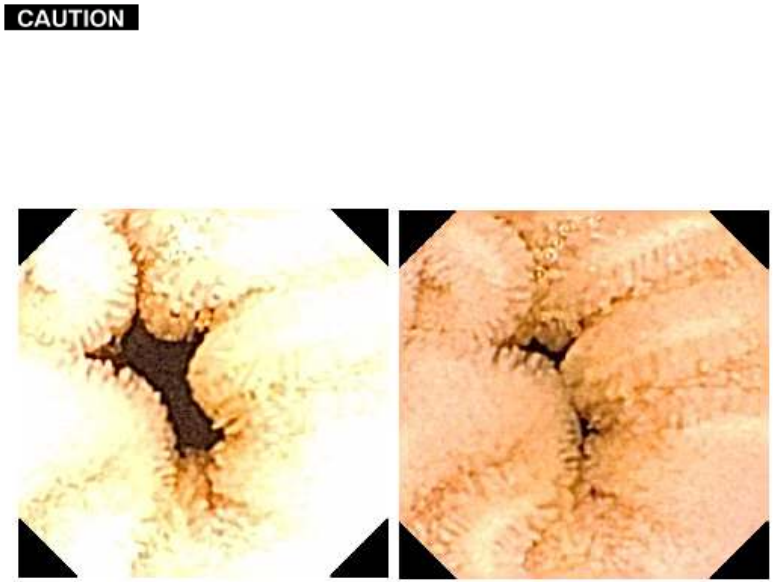
24
OLYMPUS CAPSULE ENDOSCOPE SYSTEM SYSTEM MANUAL
Color Tone of the Capsule Endoscope Image
Images photographed by the CMOS incorporated in the capsule endoscope
(EC-Y0005) are wirelessly transmitted to the antenna harness attached
to the patient and then recorded on the recorder unit . The
images stored in the recorder unit can be played on the workstation
for observation. Once the capsule endoscope is dispensed to
the patient, it cannot be controlled from outside of the patient. The capsule
endoscope’s images may be interfered or unusual with depending on the
operating environment or the settings of the devices used in conjunction with the
capsule endoscope system. The following are foreseeable image interference
cases and unusual image cases and the corresponding preventative methods or
solutions.
• If the capsule endoscope gets close to the object rapidly,
halation will occur. As a result, the image may whiteout. In
this case, refer to the images before and after the whiteout
image. Compare Figure 1 (halation) and Figure 2 (normal).
Figure 1
Figure 2
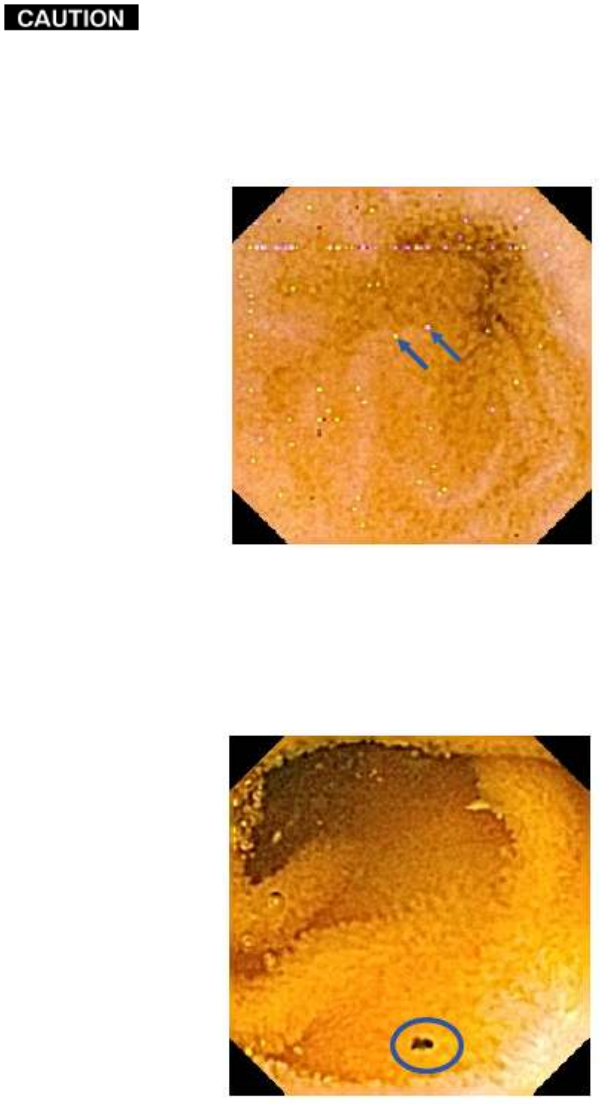
OLYMPUS CAPSULE ENDOSCOPE SYSTEM SYSTEM MANUAL
25
• Since the capsule endoscope transmits images by radio,
noise may appear in the recorded images depending on the
surrounding electromagnetic environment (see Figure 3 (an
example of the noise is indicated by the arrow)). If an image
with noise is displayed, observe the image carefully.
Figure 3
• Some debris in the small intestine may look like bleeding in
color and shape (see Figure 4 (in the circle)). To determine if
the image is debris or bleeding, observe the surrounding
condition and the images before and after the image in
question.
Figure 4
• Avoid touching the top cover of the capsule endoscope. Do
not wipe with gauze or other clothes. Doing so may damage
the top cover and interrupt observation.

26
OLYMPUS CAPSULE ENDOSCOPE SYSTEM SYSTEM MANUAL
• Do not change the color setting of Windows
®
installed in the
workstation. Doing so may change the color tone of the
image.
• Connect the LCD monitor and the workstation hardware
securely. If the connection is loose, the images may not be
displayed properly.
• Use monitors designated by Olympus for observation of the
capsule endoscopic images. Non-designated monitors may
display the images in different color tones.
• Due to the characteristics of an LCD monitor, color tones
may look different depending on the angle of observation.
When observing capsule endoscopic images, look straight in
the LCD monitor.
• Some of the pixels on the LCD monitor display can be lost
due to gradual deterioration of the monitor. The portion of the
monitor that has lost pixels may appear as white or black.
Before starting the observation, make sure that the color tone
of the color bar is appropriate, refer to “Color Settings” in the
Chapter 8 of the workstation MAJ-Y0134 instruction manual.
• Do not observe the image in sunlight whether direct or
indirect since the color tone may look different because of the
LCD monitor.
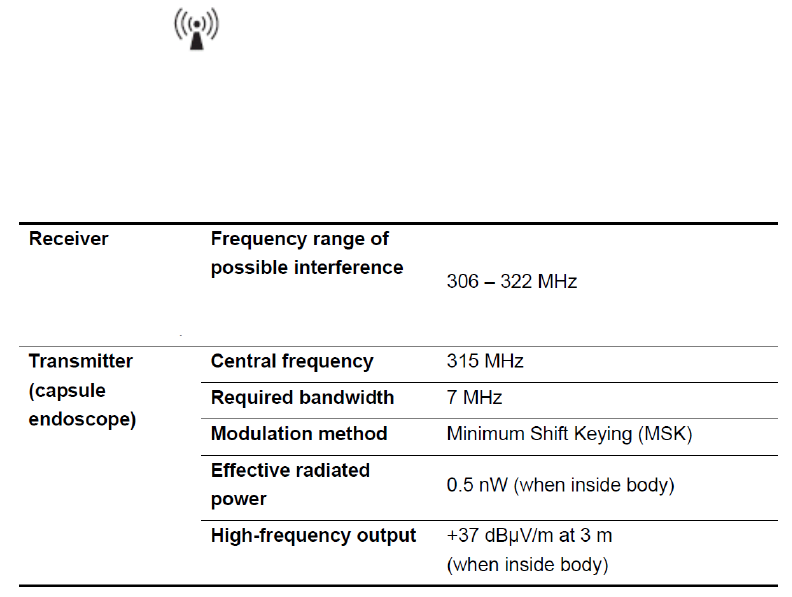
OLYMPUS CAPSULE ENDOSCOPE SYSTEM SYSTEM MANUAL
27
EMC (Electromagnetic Compatibility)
• In order to provide the intended functionality, the system
emits RF (Radio Frequency) energy while in operation. This
may affect electrical devices in the vicinity.
• The system is equipped with a function for device
identification via radio transmission, and is thus subject to
electromagnetic interference from other equipment in the
vicinity.
Limits of the technology
• Effect of the capsule endoscope on the body is unknown
when it remains in the patient for over 30 days.
• Even if a full 12 hours of images are recorded, there is no
guarantee that the whole small intestine is photographed.
• Since the capsule endoscope is a radio-transmitting device, it
could interfere/ or experience interference with other
radio-transmitting devices (e.g., telemetry, keyless entry
devices).
• For some patients, there is a possibility that the capsule
endoscope may remain in the stomach for a longer period of
time. Therefore, Olympus recommends using the real time
viewer to confirm that the capsule endoscope has passed
completely through the stomach.
• A normal diagnosis does not exclude a clinically important
abnormality in the small bowel.
(recorder unit,
antenna unit)
28
OLYMPUS CAPSULE ENDOSCOPE SYSTEM SYSTEM MANUAL
Chapter 1 Checking the Package Contents
Match all items in the package with the components shown in this chapter.
Inspect each item for damage. If the instrument is damaged, a component is
missing or you have any questions, do not use the system; immediately contact
Olympus.
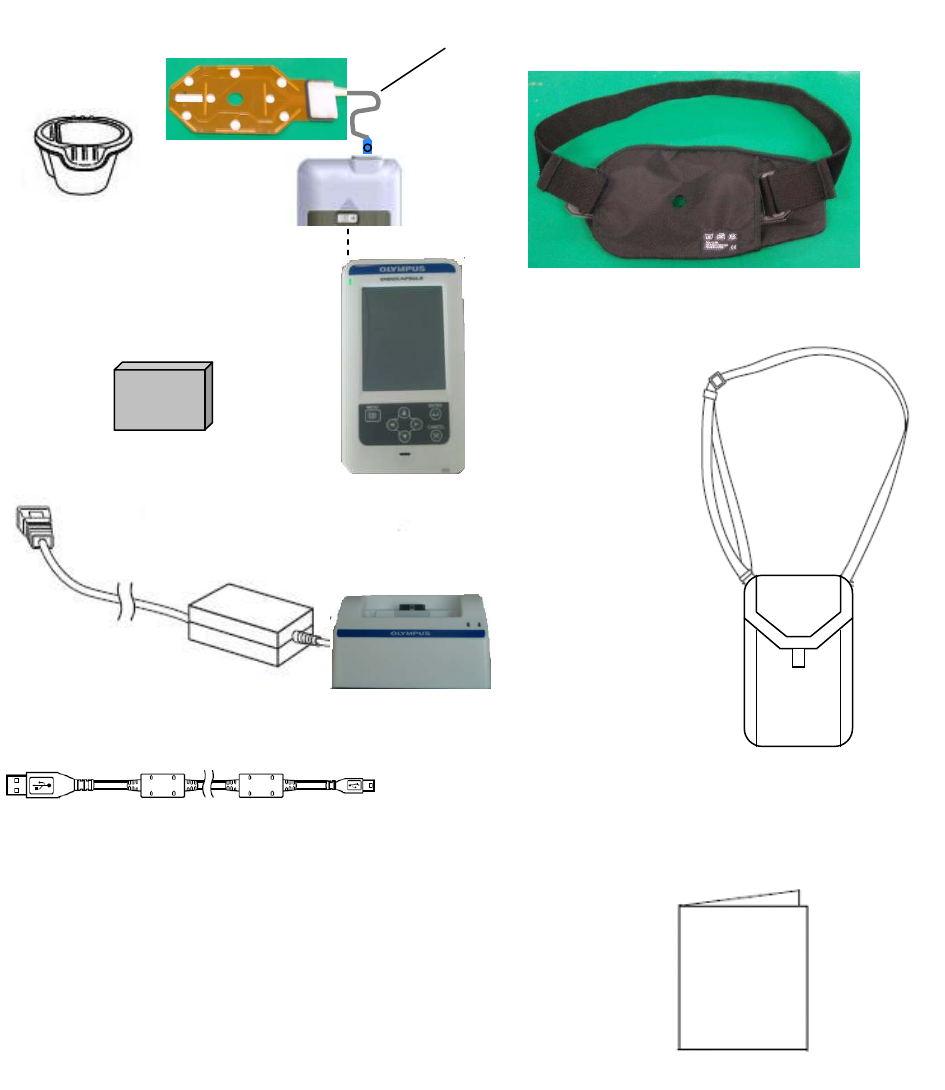
OLYMPUS CAPSULE ENDOSCOPE SYSTEM SYSTEM MANUAL
29
1.1 Capsule endoscope system MAJ-Y0136 (MAJ-Y0136)
I
nstruction manual
Antenna Unit
(
X4322
62
-
2
1
)
Antenna harness (X43225
2
-
5
1
)
Recorder unit harness (X432251-40)
Battery pack
(X432262-11-12)
AC cable
AC adapter
Recorder unit cradle
(X432262-31)
USB cable
Capsule Activator
(MAJ-1478)
Recorder unit
(
X4322
62
-
1
1
)
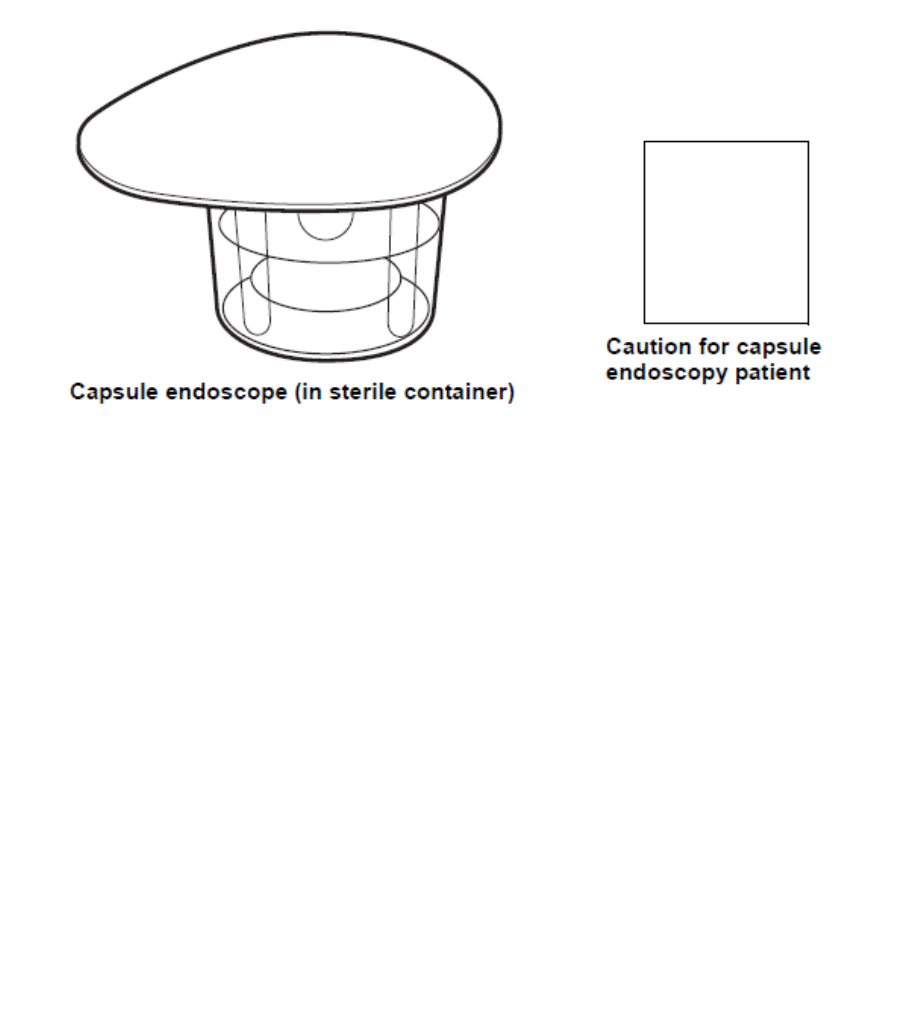
30
OLYMPUS CAPSULE ENDOSCOPE SYSTEM SYSTEM MANUAL
1.2 Capsule endoscope (EC-Y0005)

OLYMPUS CAPSULE ENDOSCOPE SYSTEM SYSTEM MANUAL
31
The product model of each item and its content are as
follows:
Product name Model Comments
Capsule endoscope system
set MAJ-Y0136
MAJ-Y0136 Recorder unit, antenna unit,
battery pack, recorder unit harness,
recorder
unit cradle, antenna
harness, AC adapter, AC cable ,USB
cable, capsule activator
Capsule endoscope EC-Y0005 1 pc.
Capsule activator MAJ-1478 1 pc.
Recorder unit X432262-11 1 pc., with 1 battery pack
Antenna unit X432262-21 1 pc.
Recorder unit cradle X432262-31 1 pc., with 1 AC adapter and 1 AC
cable
Antenna harness X432252-51 1 pc.
Recorder unit harness X432251-40 1 pc.
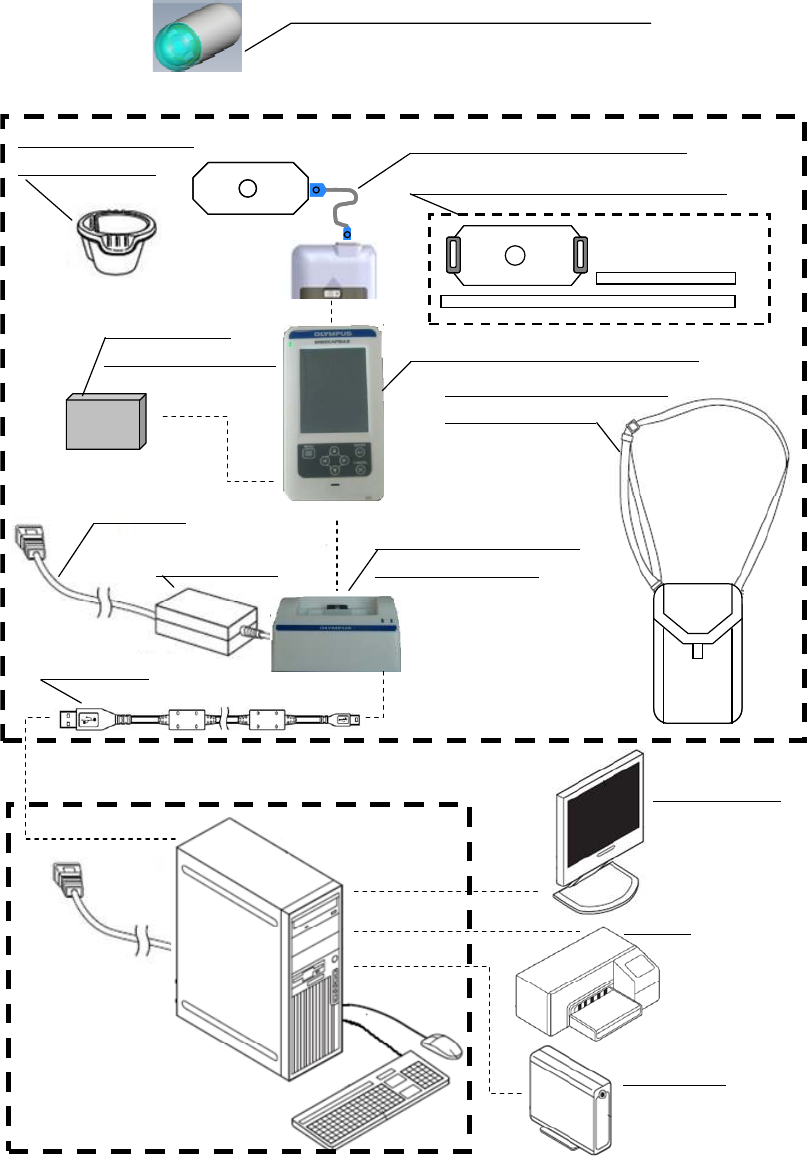
32
OLYMPUS CAPSULE ENDOSCOPE SYSTEM SYSTEM MANUAL
Chapter 2 Nomenclature and Functions
2.1 System components
Capsule endoscope ( EC-Y0005)
Antenna unit (X432262-21)
Recorder unit (X432262-11)
Antenna harness (X432252-51)
Recorder unit harness
(X432251-40)
Battery pack
(X432262-11-12)
AC cable
AC adapter
Recorder unit cradle
(X432262-31)
USB cable
Capsule activator
(MAJ-1478)
Workstation (MAJ-Y0134) LCD monitor
Printer
USB HDD
Capsule endoscope system set MAJ-Y0136 (MAJ-Y0136)
OLYMPUS CAPSULE ENDOSCOPE SYSTEM SYSTEM MANUAL
33
1. Capsule endoscope (EC-Y0005)
Takes endoscopic pictures of the gastrointestinal tract and transmits the
image data by radio transmission.
2. Antenna unit (X432262-21)
Receives transmissions from the capsule endoscope, and transfers the
image data to the recorder unit.
3. Recorder unit (X432262-11)
Records the image data transmitted by the capsule endoscope via the
antenna unit.
4. Battery pack (X432262-11-12)
The power supply for the recorder unit.
5. Recorder unit cradle (X432262-31)
Holds the recorder unit while connecting to the workstation. Used for
initialization of the recorder unit, registration of the patient ID, and
downloading of image data.
6. Antenna harness (X432252-51)
Holds the Antenna unit during the examination.
7. Recorder unit harness (X432251-40)
Holds the recorder unit during the examination.
8. Capsule Activator (MAJ-1478)
Holds the recorder unit during the examination.
9. USB cable
Connects the recorder unit cradle to the workstation for transmission of
patient ID, image data, etc.
10. Workstation (MAJ-Y0134)
Registers patient information and patient IDs onto the recorder unit. Also
used to download the endoscopic images from the recorder unit for
observation, diagnosis, and reporting (refer to the “WORKSTATION
MANUAL”).

34
OLYMPUS CAPSULE ENDOSCOPE SYSTEM SYSTEM MANUAL
2.2 Capsule endoscope (EC-Y0005)
Capsule endoscope (EC-Y0005)
1. Exterior package
Exterior package of the capsule endoscope.
2. Top cover
A transparent observation port covering the objective lens and illumination
light emitting diode (LED).
3. Objective lens
Lens for endoscopic observation.
4. Illumination LED
Illuminates the area being observed.
5. Battery
Internal battery for operating the capsule endoscope.
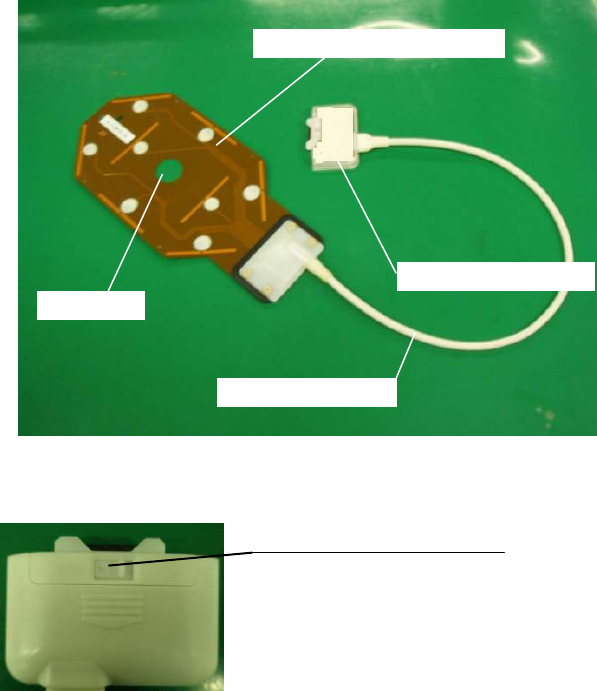
OLYMPUS CAPSULE ENDOSCOPE SYSTEM SYSTEM MANUAL
35
2.3 Antenna unit (X432262-21)
1. Antenna sheet
Receives signals from the capsule endoscope.
2. Antenna cable
Transfers the received signals to the connection unit.
3. Connection unit
Connects to the recorder unit.
4. Hole
Use it for alining the antenna sheet.
5. Antenna unit eject button
Slide the button located on the backside of the recorder unit to disconnect
the antenna unit.
1. Antenna sheet
2
. Antenna
cable
3. Connection unit
5.
Antenna unit eject button
4
.
hole
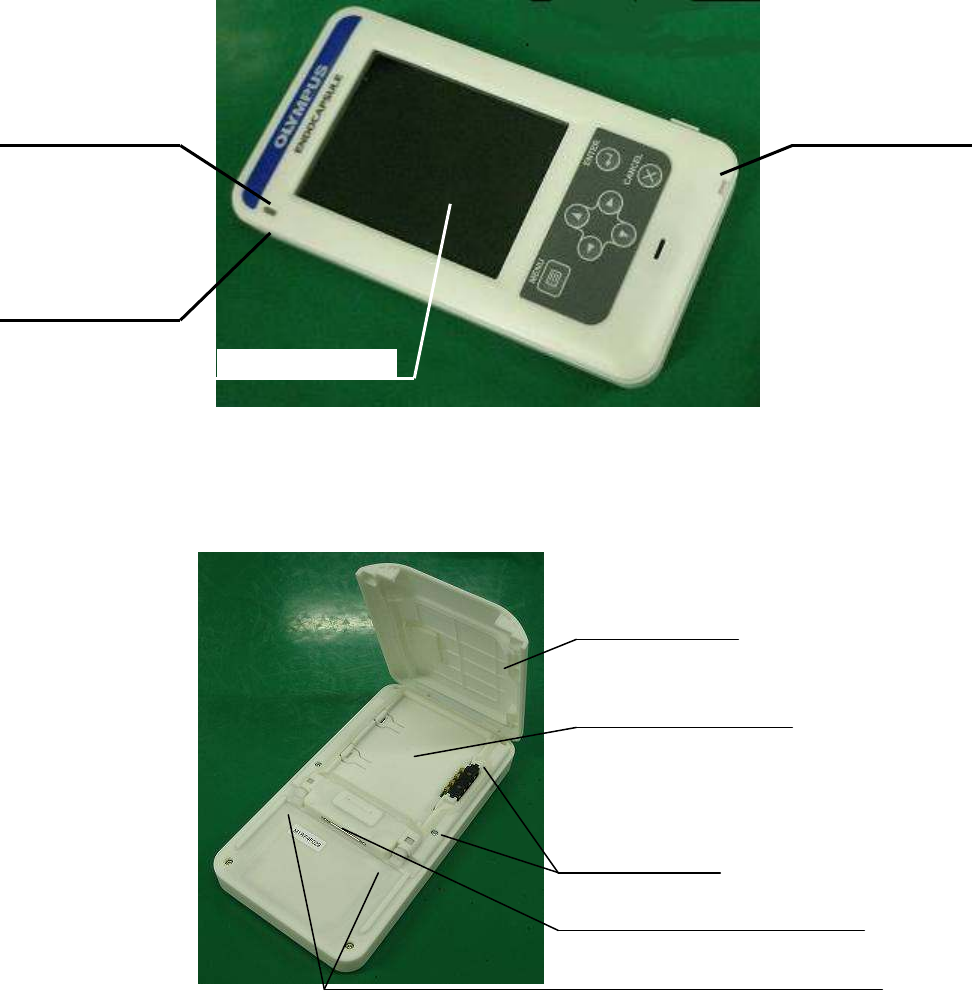
36
OLYMPUS CAPSULE ENDOSCOPE SYSTEM SYSTEM MANUAL
2.4 Recorder unit (X432262-11)
1. Indicator lamp
Indicates the reception/communication status with the capsule endoscope
and the workstation.
2. Power lamp
1.
Indicator lamp
3.
Display panel
2.
Power lamp
7. Power switch
4.
Battery cover
5.
Battery pack
case
6.
Antenna
unit
connector
8
.
Eject button
9
.Hole
OLYMPUS CAPSULE ENDOSCOPE SYSTEM SYSTEM MANUAL
37
Illuminates green when the recorder unit is turned ON.
3. Display panel
Displays patient ID, battery pack level, etc.
4. Battery cover
Covers the battery pack and holds the battery pack in place.
5. Battery pack case
Insert the battery pack here.
6. Antenna unit connector
Attach the antenna unit here.
Connect to the recorder unit cradle.
7. Power switch
Turn the recorder unit ON by holding down the switch for 1 second or more.
Turn the recorder unit OFF by holding down the switch for 2 seconds or more.
8. Battery cover eject button
Push it to remove the battery cover
9. Hole
Insert the nail of the battery pack into this hole when inserting the battery pack
into the battery pack case.
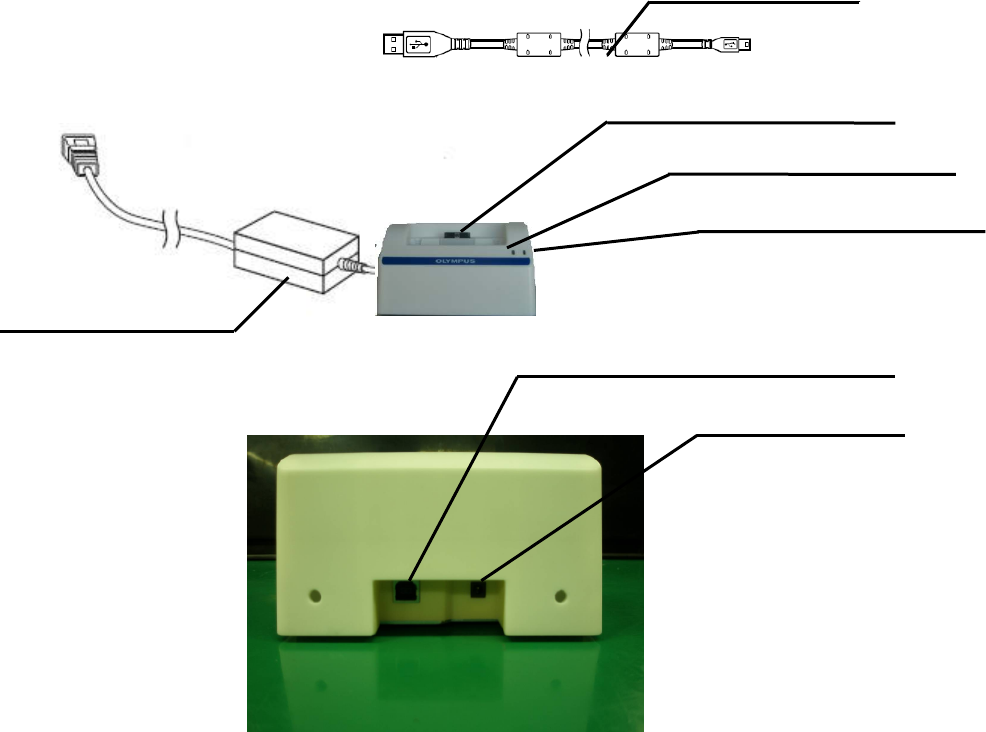
38
OLYMPUS CAPSULE ENDOSCOPE SYSTEM SYSTEM MANUAL
2.5 Recorder unit cradle (X432262-31)
1. AC adapter
Connects to an AC power supply.
2. USB cable
Connects between the USB connector and the workstation.
3. Recorder unit connector
Connect to the recorder unit.
4. Power connector
Connect to the AC adapter.
5. USB connector
Connect to USB cable.
6.Charge completion lamp
Show the status that battery is charged completely..
7. Charge lamp
Show the status that battery is charging.
2. USB cable
3. Recorder unit connector
4. Power connector
5. USB connector
1. AC adapter
6.Charge completion lamp
7.Charge lamp
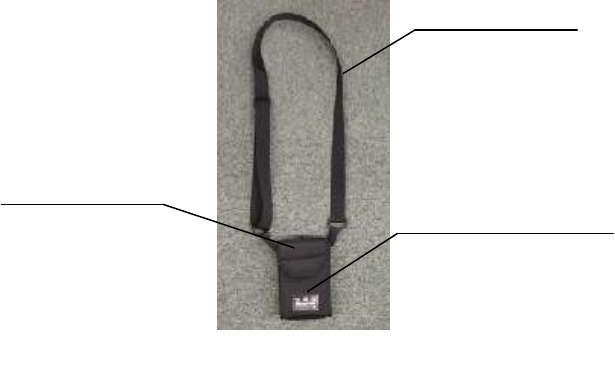
OLYMPUS CAPSULE ENDOSCOPE SYSTEM SYSTEM MANUAL
39
2.6 Recorder unit harness (X432251-40)
1. Suspender
Adjusts the length according to the patient’s physique.
2. Pouch
Stores the recorder unit during the examination.
3. Pouch cover
Secures the recorder unit and the antenna cables to the pouch.
1. Suspender
2. Pouch
3. Pouch cover
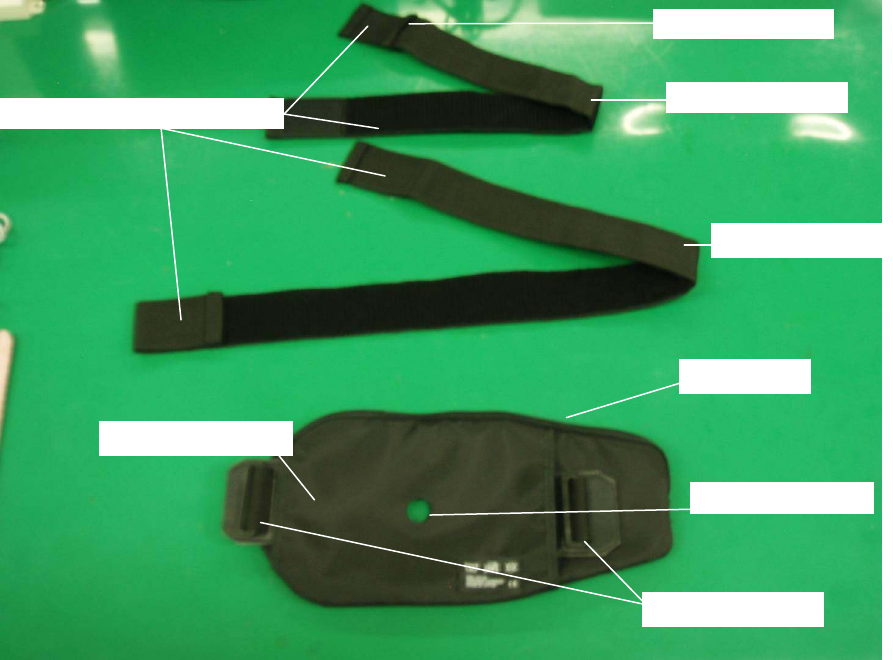
40
OLYMPUS CAPSULE ENDOSCOPE SYSTEM SYSTEM MANUAL
2.7 Antenna harness (X432252-51)
1.Antenna pouch
Housing the antenna sheet..
2. Fastener
Zip up to fix the antenna sheet..
3. Alignment hole
Adjust this hole to the umbilical position.
4. Belt ring
Through a belt, and fix the hook and loop fastener..
5. Hook and loop fastener
Connect the both ends of the belt.
6. Belt coupler
Please use it to connect the long belt and the short belt.
7. Short belt
It fixes the antenna pouch to the patient’s body.
If necessary, connect to the long belt.
8. Long belt
It fixes the antenna pouch to the patient’s body.
If necessary, connect to the short belt.
5. Hook and loop fastener
6.
Belt coupler
7.
Short belt
3.Alignment hole
1. Antenna pouch
4. Belt ring
8. Long belt
2. Fastener
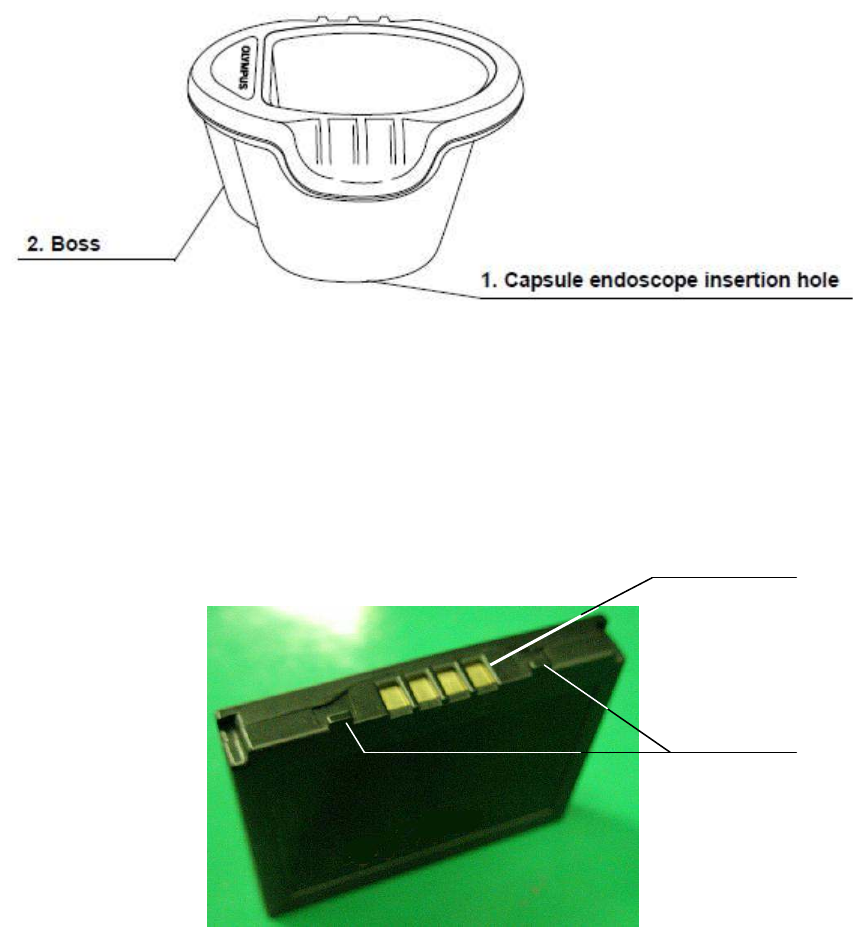
OLYMPUS CAPSULE ENDOSCOPE SYSTEM SYSTEM MANUAL
41
2.8 Capsule activator (MAJ-1478)
1. Capsule endoscope insertion hole
To turn ON the capsule endoscope, insert it into this hole.
2. Boss
Projected portion that indicates direction of the activator.
It is like a guide when inserting the activator.
2.9 Battery pack (X432262-11-12)
1. Terminal
Connects to the connector in the battery case of the recorder unit.
2. Clawe
Insert this nail into the hole of the recorder unit when inserting the
battery pack into the battery pack case.
2.10 Workstation (MAJ-Y0134)
For a diagram of the workstation configuration, please refer to the
“WORKSTATION MANUAL”
1.
Terminal
2.Clawe

42
OLYMPUS CAPSULE ENDOSCOPE SYSTEM SYSTEM MANUAL
Chapter 3 Installation and Connection
3.1 Preparation
The following items are required for the capsule endoscope examination.
Inspect them the day before the examination as described in this chapter.
Table 3.1
Equipment Quantity
Capsule endoscope 2
(Including 1 spare)
Antenna unit 1
Recorder unit 1
Battery pack 1
Recorder unit cradle 1
USB cable 1
Recorder unit
harness
1
Workstation 1
Capsule activator 1
Antenna harness 1
Drinking water As
required
Gauze As
required
Ethyl or isopropyl
alcohol
As
required
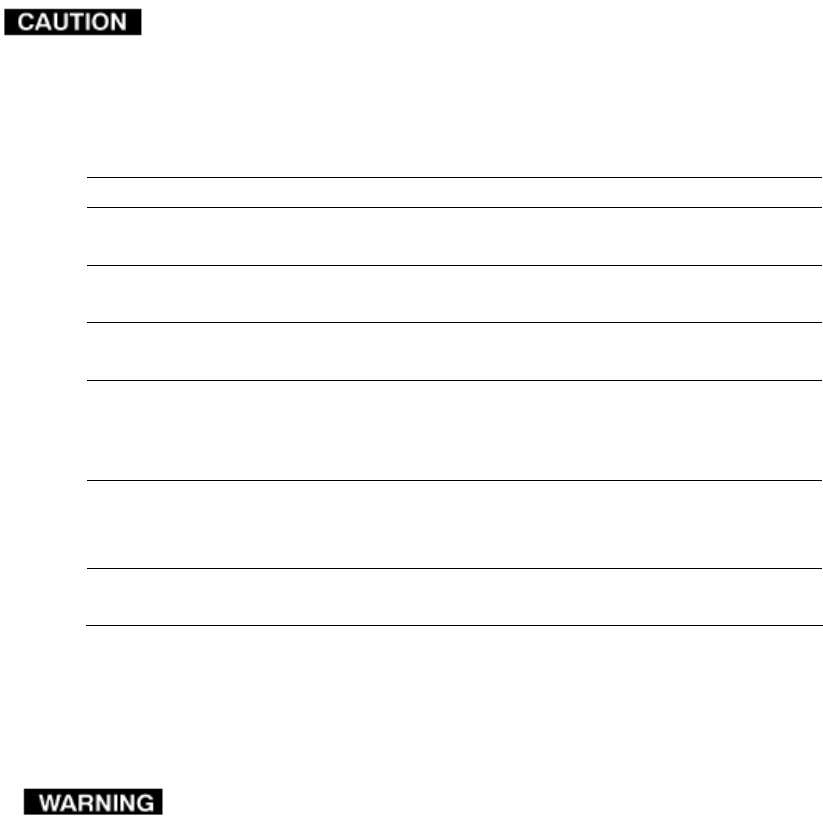
OLYMPUS CAPSULE ENDOSCOPE SYSTEM SYSTEM MANUAL
43
3.2 Exterior
Do not use if the equipment exterior is abnormal.It may result in failure of the
examination.
Inspect the equipment as described in Table 3.2 below.
Table 3.2
3.3 Capsule endoscope
Perform the following inspections before use. Should any
irregularity be observed, do not use this system. Damage to
or irregularity of this system may cause malfunction or patient
injury.
1.
Confirm that the expiration date has not passed.
2.
Check the sterile package for ruptures, damage to the seal or water that
might have entered the sterile package.
3.
Before removing the capsule endoscope from the sterile package, inspect
the capsule’s surface for cracks, deterioration, deformation, and other
damage.
Equipment Description
Antenna unit Check that the unit is free of cracks, deterioration, deformation,
And other damage.
Recorder unit Check that the unit is free of cracks, deterioration, deformation,
And other damage.
Recorder unit cradle Check that the unit is free of cracks, deterioration, deformation,
and other damage.
AC adapter Check that the unit is free of cracks, deterioration, deformation,
And other damage. Check the power supply cable for scratches
and bends,. Check the connectors for cracks, deterioration,
deformation, and other damage.
USB cable Check the cable for scratches and bends. Check the
connectors for cracks, deterioration, deformation, and
otherdamage.
Battery pack Check that the unit is free of cracks, deterioration, deformation,
and other damage.
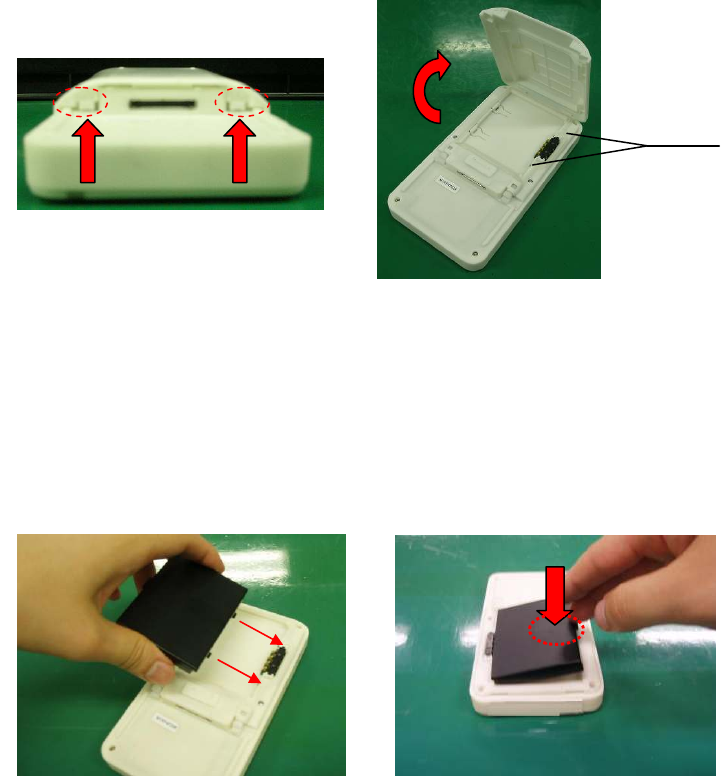
44
OLYMPUS CAPSULE ENDOSCOPE SYSTEM SYSTEM MANUAL
3.4 Preparation of the recorder unit
Attaching the battery pack
1. Open the battery cover by pressing the battery cover eject button.
Figure 3.1 Figure 3.2
2. Align the two claws on the battery pack with the hole in the battery pack case, and
insert the battery pack to the battery pack case.
figure 3.3 Figure 3.4
Hole
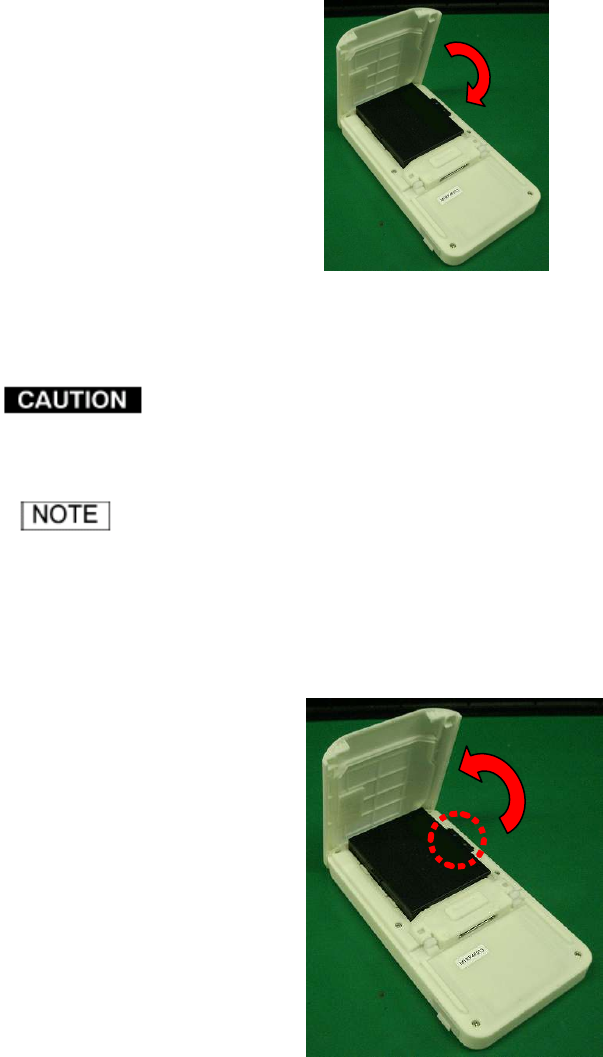
OLYMPUS CAPSULE ENDOSCOPE SYSTEM SYSTEM MANUAL
45
3. Close the battery cover by pressing it down over the battery pack until the battery cover
is locked. (Refer Figure 3.5)
Figure 3.5
Don’t use the recorder unit if there are cracks, deterioration, deformation, and other
damage. It may interfere with the examination.
• The battery pack is not charged when it is shipped. Charge it before use.
• To remove the battery pack, remove the battery cover for reference ‘1’ of
“Attaching the Battery pack” of the previous page. And lift the edge of the battery
pack which is surrounded with the dotted line of the figure below.
Figure 3.6
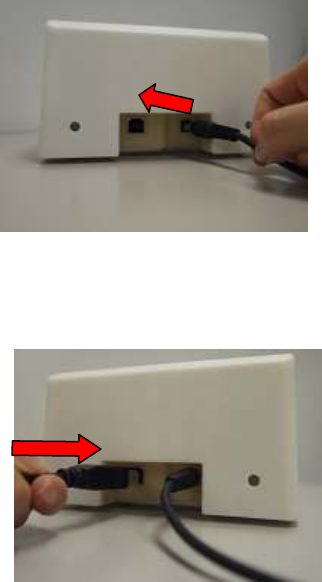
46
OLYMPUS CAPSULE ENDOSCOPE SYSTEM SYSTEM MANUAL
3.5 Preparation of the recorder unit cradle
1.
Connect the AC adapter to the power connector.
Figure 3.7
2.
Connect the USB cable to the USB connector.
Figure 3.8
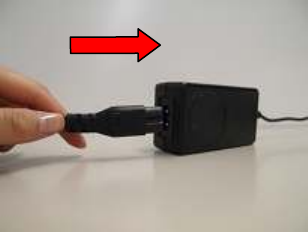
OLYMPUS CAPSULE ENDOSCOPE SYSTEM SYSTEM MANUAL
47
3.
Connect the AC cable to the AC Adapter.
Figure 3.9
4.
Connect the AC cable to the AC power supply.
5.
Connect the USB cable to the USB connector on the workstation. Refer to “Workstation
manual”.

48
OLYMPUS CAPSULE ENDOSCOPE SYSTEM SYSTEM MANUAL
Chapter 4 Operation
4.1 Preparation and Inspection before examination
Before starting an examination, be sure to read and clearly understand the
information in this instruction manual.
Instruct the patient to stay away from equipment that
generates strong electromagnetic fields (such as MRI
equipment), between ingestion and excretion of the capsule
endoscope. Otherwise, injury within the body cavity may
occur. If the excretion of the capsule endoscope has not
been confirmed 30 days after ingestion, attempt to locate the
capsule endoscope within the patient’s body by X-ray
examination.
Instruct the patient to consult their physician immediately if
symptoms such as abdominal pain, discomfort, or nausea
are experienced after ingesting the capsule endoscope.
Injury to the patient may result if treatment for such
symptoms is delayed.
• Instruct the patient not to turn the recorder unit’s power OFF,
push any buttons on the recorder unit, disconnect the
antenna unit, or remove an antenna harness during the examination.
Failure to follow the instructions may interfere with the examination.
• During the capsule endoscope exam instruct the patient to
stay away from generators of strong electromagnetic fields
(such as MRI equipment, amateur (ham) radio, etc.),
otherwise image recording may not occur due to radio
interference.
• Please advise the patients not to use radio transmitting
devices such as keyless entry devices (frequency range of
possible interference: 306 - 322 MHz) or stay in an area
where other persons may use them frequently, in order to
reduce the possibility of dropped video frames caused by the
use of these devices.
• Since the capsule endoscope is a radio-transmitting device, it
could interfere/ or experience interference with other
radio-transmitting devices (e.g., telemetry, keyless entry
devices).

OLYMPUS CAPSULE ENDOSCOPE SYSTEM SYSTEM MANUAL
49
• On rare occasions, interference may result in the need to
repeat the capsule endoscope procedure. In this case, the
physician should advise the patient to stay within the
premises of the medical facility during the examination to
prevent this problem from reoccurring.
• The capsule endoscope contains a radio transmitter;
therefore, the patient cannot fly in an airplane until the
examination is over.
•The life span of a battery pack is approximately 1 year from the date of purchase.
When the battery pack approaches its end-of-life, the recorder unit will prompt
for replacement. Order a new battery pack and replace.
Otherwise the recorder unit may not be able to operate for 12 hours.
Exterior
Inspect the equipment as described in Table 4.1 below.
Equipment Description
Antenna unit Check that the Antenna unit is free of cracks,
deterioration, deformation, and other damage.
Recorder unit Check that the recorder unit is free of cracks,
deterioration, deformation, and other damage.
Recorder unit cradle Check that the recorder unit cradle is free of cracks,
deterioration, deformation, and other damage.
AC adapter Check that the AC adapter is free of cracks,
deterioration, deformation, and other damage. Check
the power supply cable for scratches and bends,.
Check the connectors for cracks, deterioration,
deformation, and other damage.
USB cable Check the cable for scratches and bends. Check the
connectors for cracks, deterioration, deformation, and
other damage.
Antenna harness Check that the Antenna harness is free of rips,
deterioration, and other damage.
Recorder unit harness Check that the recorder unit harness is free of rips,
deterioration, and other damage.
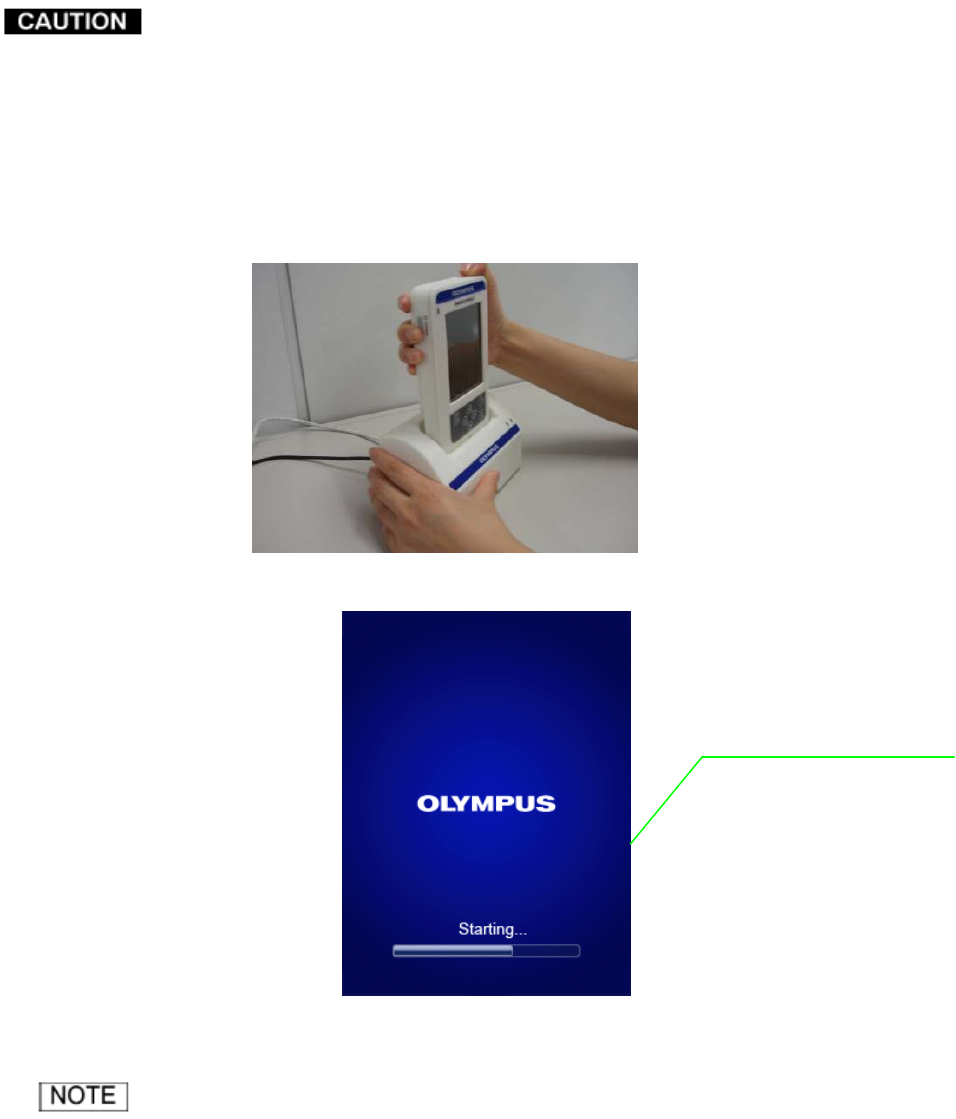
50
OLYMPUS CAPSULE ENDOSCOPE SYSTEM SYSTEM MANUAL
Recharging
Fully recharge the battery packs to prevent low battery charge, which could cause the
examination to end prematurely. In preparation for the examination, recharge the battery
packs on the previous day.
The battery pack can not be recharged at temperatures below 0℃.
1. Check that the recorder unit is off and the display panel is blank.
2. Suppress the recorder unit cradle by hand, and insert the recorder unit to the recorder
unit cradle as shown in Figure 4.1. The recorder unit is turned on, and displays starting
screen as shown in Figure 4.2 on the display panel.
Figure 4.1
Figure 4.2
When the antenna unit is connected to the recorder unit, the recorder unit cannot be
connected to the recorder unit cradle. Remove the antenna unit from the recorder unit to
insert the recorder unit to the recorder unit cradle.
Starting screen
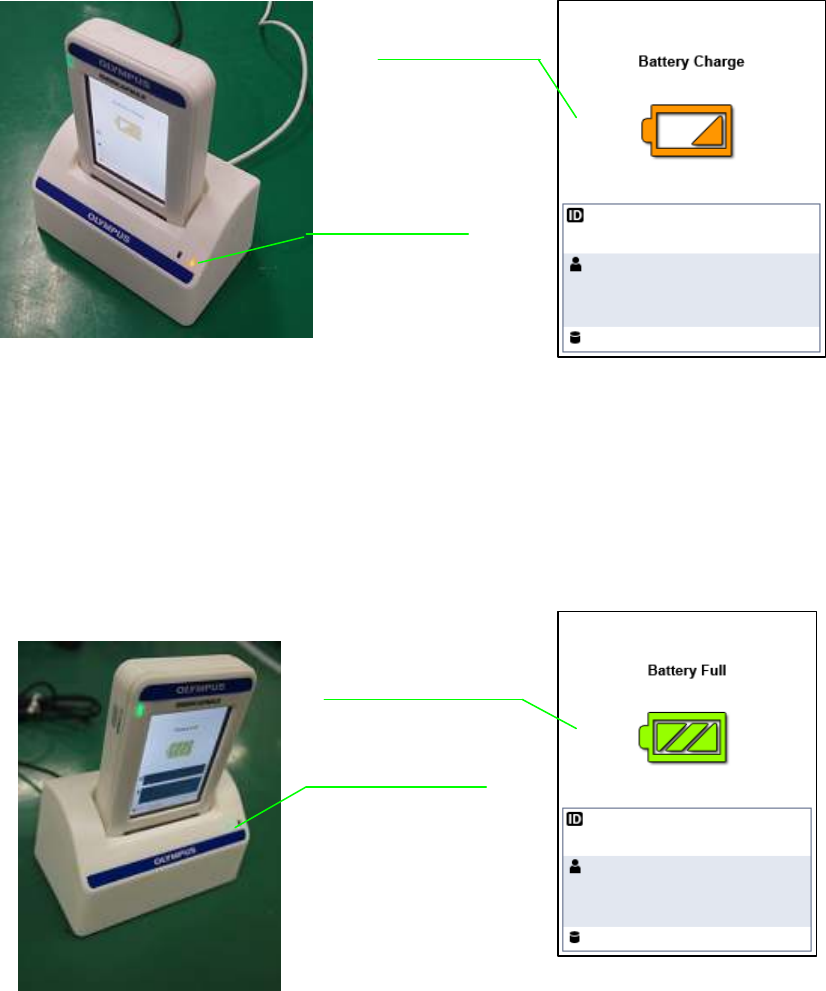
OLYMPUS CAPSULE ENDOSCOPE SYSTEM SYSTEM MANUAL
51
3. Wait a few seconds, and check that the charge lamp illuminates and Battery charge
screen as shown in Figure 4.4 is displayed on the display panel. The recharging time is
approximately 2 hours.
Figure 4.3 Figure 4.4
4. When recharging is complete, the charge lamp goes off, the charge completion lamp
illuminates and Battery full screen as shown in Figure 4.6 is displayed on the display
panel.
Figure 4.5 Figure 4.6
Battery charging
screen
Charge lamp
Charge
completion lamp
Battery full
screen
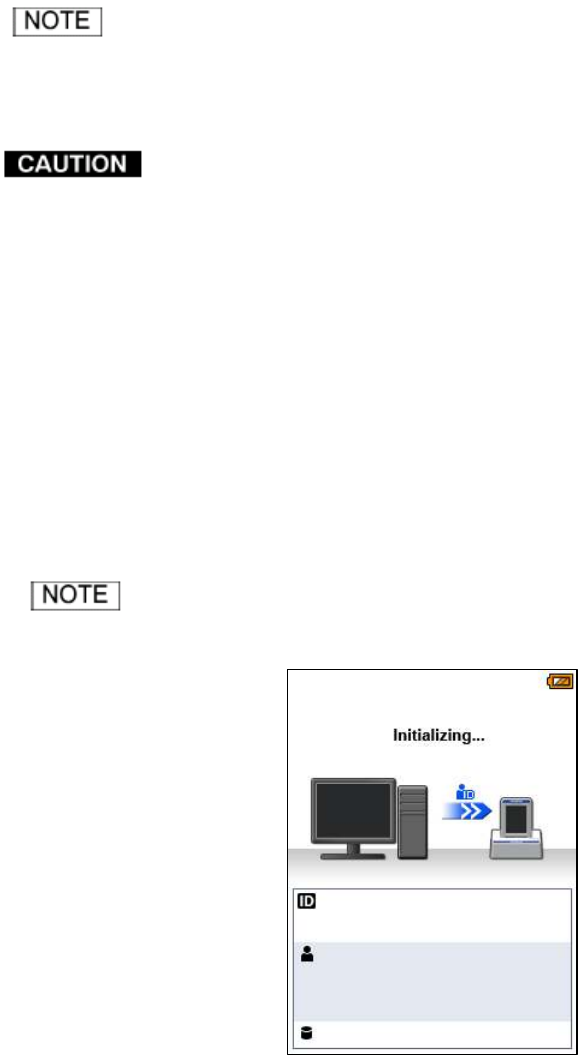
52
OLYMPUS CAPSULE ENDOSCOPE SYSTEM SYSTEM MANUAL
Initial setup of the recorder unit
Before initializing, to complete the connection and setup of the Workstation, refer to
the “WORKSTATION MANUAL”.
The recorder unit is connected to the workstation via the recorder unit cradle.
While setting up the recorder unit, do not remove the recorder unit from the recorder
unit cradle or remove the USB cable and/or AC adapter. Doing so may result in failure
of the examination. If the recorder unit is taken off the recorder unit cradle, or the USB
cable and/or AC adapter is disconnected, reconnect the recorder unit to the
workstation by placing it on the recorder unit cradle or by reattaching the USB cable
and AC adapter. Restart the workstation before setting up the recorder unit again.
1.
The workstation is used to initialize the recorder unit and to enter patient information.
For more information on the initialization procedure and entering patient information,
refer to the “WORKSTATION MANUAL”.
During the initial setup, recorder unit is displayed Initializing screen as shown in Figure
4.7 on the display panel, and the recorder unit’s indicator lamp illuminates orange.
Figure 4.7
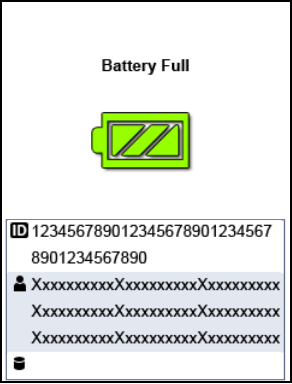
OLYMPUS CAPSULE ENDOSCOPE SYSTEM SYSTEM MANUAL
53
2.
When initialization is completed, patient ID and the patient’s name are displayed on the
Battery full screen as shown in Figure 4.8 on the display panel and the recorder unit’s
indicator lamp change green.
Figure 4.8
3.
While holding the recorder unit cradle with one hand, lift the recorder unit up with your
other hand to remove it from the recorder unit cradle. The recorder unit is turned OFF
automatically.
None
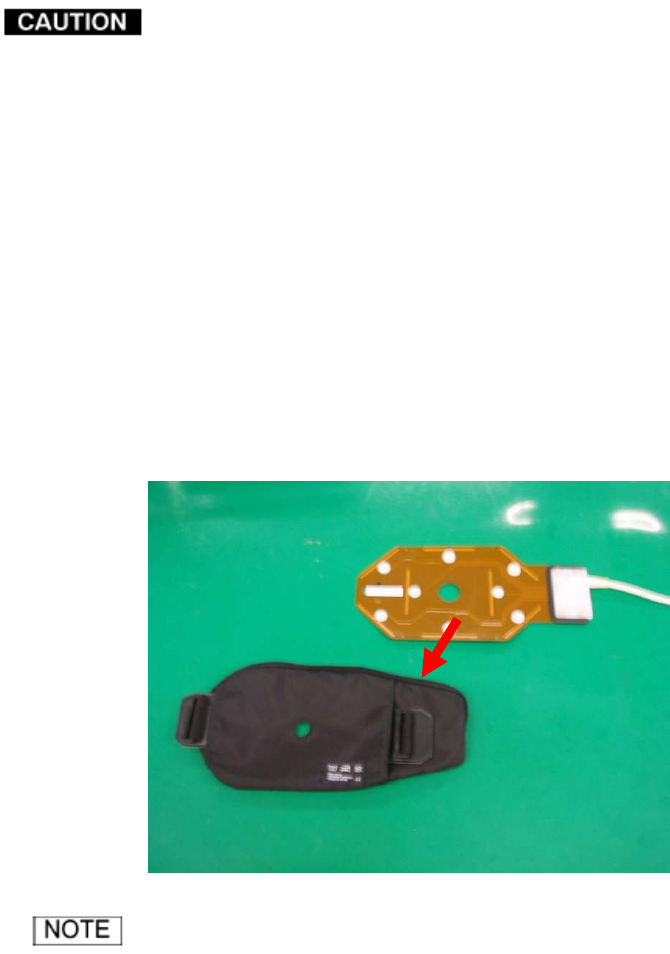
54
OLYMPUS CAPSULE ENDOSCOPE SYSTEM SYSTEM MANUAL
4.2 Attaching the equipment to the patient
Patient confirmation
Before attaching the antenna unit to the patient, confirm the patient’s identity. Also confirm that
the patient has not eaten or drunk for at least 8 hours before the examination.
Inserting the antenna sheet
•When inserting the antenna sheet to the antenna harness, take care not to bend the
antenna sheet. Otherwise, receiving sensitivity of the antenna sheet may decrease so
that noise may appear in the images or the images may not be transmitted properly.
• Do not reverse the antenna sheet upside down, left to right, and inside out when
inserting it to the antenna harness. If antenna sheet is inserted to antenna harness
improperly, the recorder unit may not be able to receive accurate data from the capsule
endoscope.
• In case of accidental drop of the recorder unit, push the power button to restart the
recorder unit, and confirm if the error message is displayed or not. The examination
can be continued unless the error message is displayed.
1. Open the fastener of the antenna harness and insert the antenna sheet in the antenna
harness as shown in the figure 4.9.
2. Zip up the fastener of the antenna harness.
Figure 4.9
Please insert the antenna unit in the antenna harness so that the brown aspect of the
antenna unit and the label of the antenna harness are the same side.
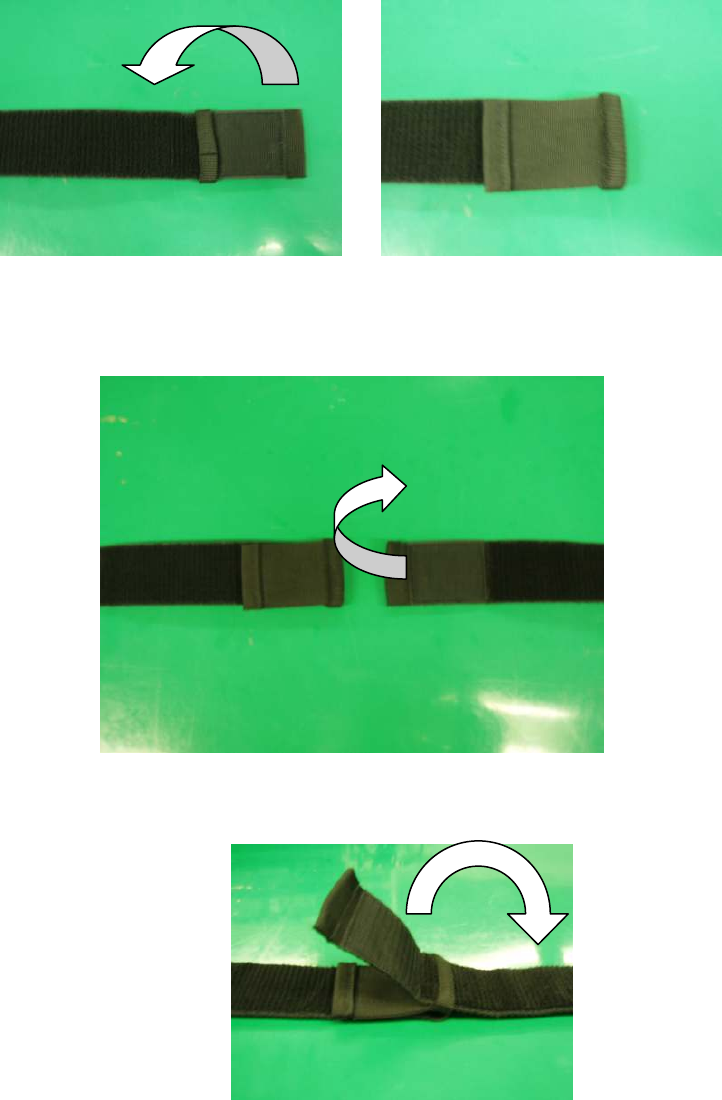
OLYMPUS CAPSULE ENDOSCOPE SYSTEM SYSTEM MANUAL
55
Preparation of antenna unit harness
Select the appropriate belt to fit the body form of the patient.
If it is necessary, connect two belts in the following procedures. (Refer to figure 4.10,
figure 4.11)
1. Turn down a belt in a belt coupler of the short belt. And close a hook and loop
fastener.
Figure 4.10 Figure 4.11
2. Put the end of the long belt through the belt coupler of the short belt like figure
4.12.
Figure 4.12
3. Close the hook and loop fastener of the long belt. (Refer to figure 4.13)
Figure 4.13
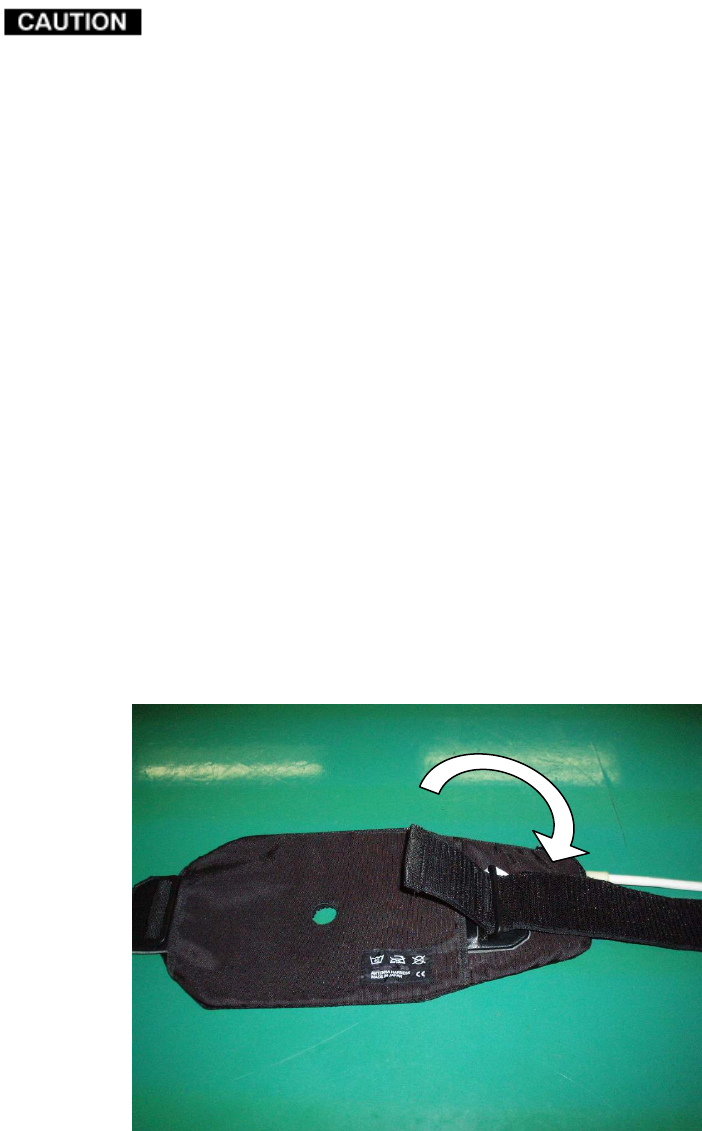
56
OLYMPUS CAPSULE ENDOSCOPE SYSTEM SYSTEM MANUAL
Attaching the antenna unit
• Refer to the following information to attach the antenna unit to the patent’s body.
Otherwise, noise may appear in the images or the images may not be transmitted
properly.
• Allow only a thin clothing of natural materials to be placed between the body and the
antenna harness.
• Do not tuck metals, such as buckle of belt, between the antenna unit and surfaces of
the body. Otherwise, noise may appear in the images or the images may not be
transmitted properly.
• Attach the antenna unit and the recorder unit so that antenna cable is not caught on
things such as a knob of a door. Otherwise it may damage the antenna unit and/or the
recorder unit and may result in failure of the examination.
• Attach the antenna unit and the recorder unit so that antenna cable is not laid on or
near the antenna sheet. It may prevent the reception of images so that noise may
appear in the images or the images may not be transmitted properly.
1. Instruct the patient to wear only a thin piece of clothing around abdominal area.
2. Put the belt through the belt ring. And fix the belt to the belt ring of the porch with a
hook and loop fastener. Set a porch to the abdomen so that a mesh side becomes the
patient side and so that an antenna cable comes to the left side of the patient’s body.
Figure 4.14
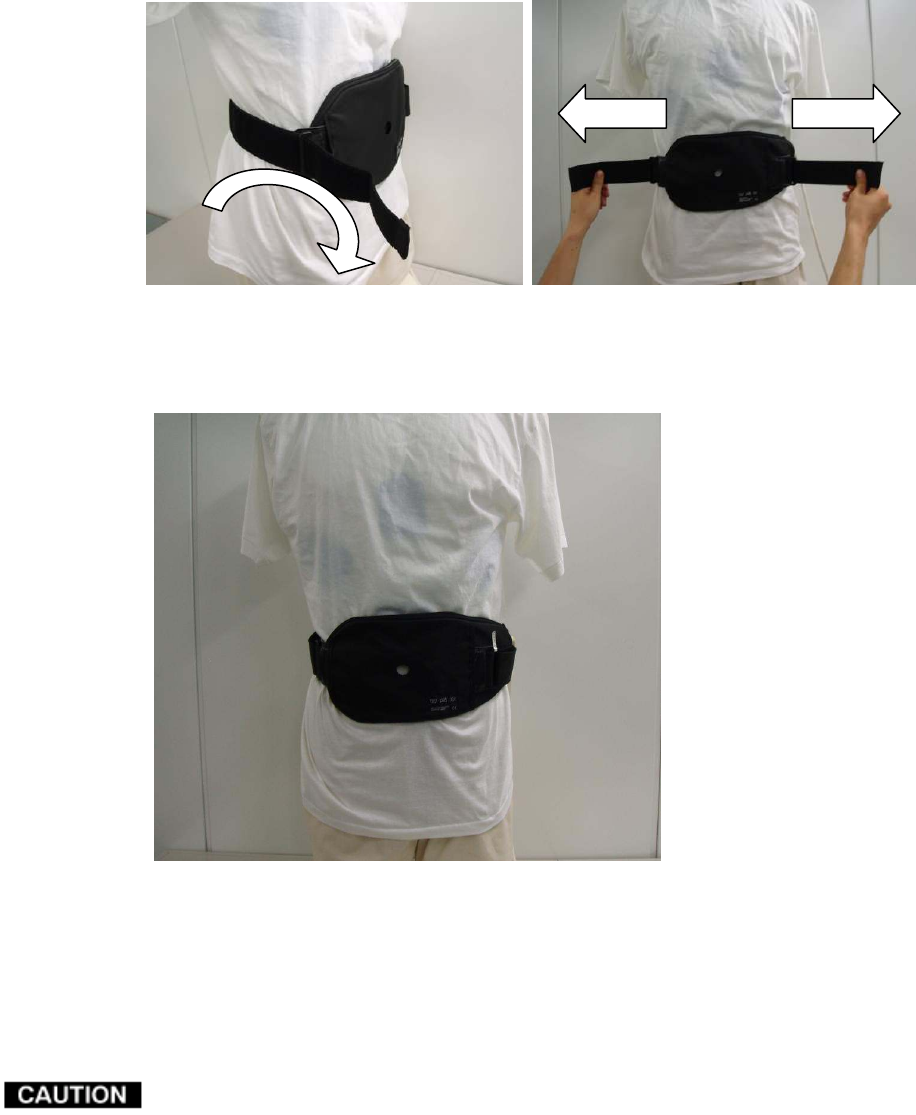
OLYMPUS CAPSULE ENDOSCOPE SYSTEM SYSTEM MANUAL
57
3. Let the other end of the belt into a belt ring. Pull out the both ends of the belt in right and
left to attach antenna harness to the patient. (Refer to figure 4.16)
Figure 4.15 Figure 4.16
4. Adjust the position of the antenna harness so that the alignment hole of the antenna
harness to the umbilical position of the patient.(Refer to figure 4.17)
Figure 4.17
5. Reattach the antenna harness in the case such as follows when the patient walks
and/or sits down.
- A patient feels unpleasantness.
- The antenna harness move or is separate from the patient’s body
・ Tighten the belt so that the antenna harness is not separate from the surface of the
patient’s body, and so that the antenna harness is believed not to move from the
attached position. Otherwise, noise may appear in the images, or the images may
not be transmitted properly.
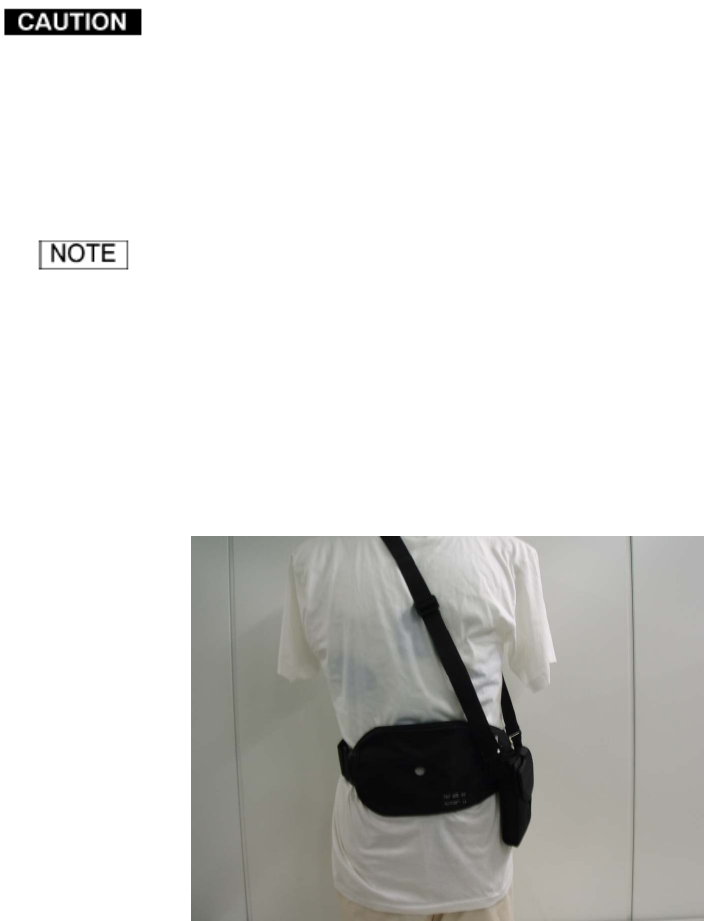
58
OLYMPUS CAPSULE ENDOSCOPE SYSTEM SYSTEM MANUAL
・Instruct the patient to be careful so that the antenna harness does not move from the
attached position and so that the antenna harness is not separated from the surface
of the patient’s body. Otherwise, noise may appear in the images, or the images may
not be transmitted properly.
・ Instruct the patient to be careful so that the antenna cable is not caught on things
such as knob of doors.
Instruct the patient to confirm that the position of the antenna harness is same as it’s
attached position after going to a restroom.
Attaching the recorder unit harness
Attach the recorder unit harness as shown in the figure 4.18.
Figure 4.18
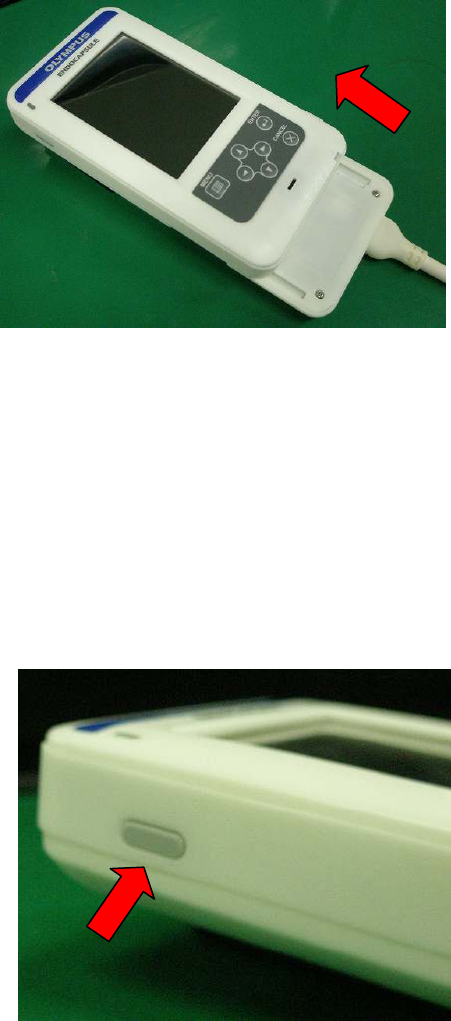
OLYMPUS CAPSULE ENDOSCOPE SYSTEM SYSTEM MANUAL
59
Connecting the recorder unit and the antenna unit
1. Connect the antenna unit to the recorder unit by inserting the connection unit into the
recorder unit until they click (Refer to Figure 4.19).
Figure 4.19
2. Hold down the recorder unit’s power switch for at least 1 second to turn ON the recorder
unit (Refer to 4.20). The starting screen is displayed as shown in Figure 4.21 on the display
panel.
3. After the starting screen is displayed, The ID view screen is displayed as shown in Figure
on the display panel. Check that battery icon is green. (Refer to Figure4.21, Figure 4.22)
Figure 4.20
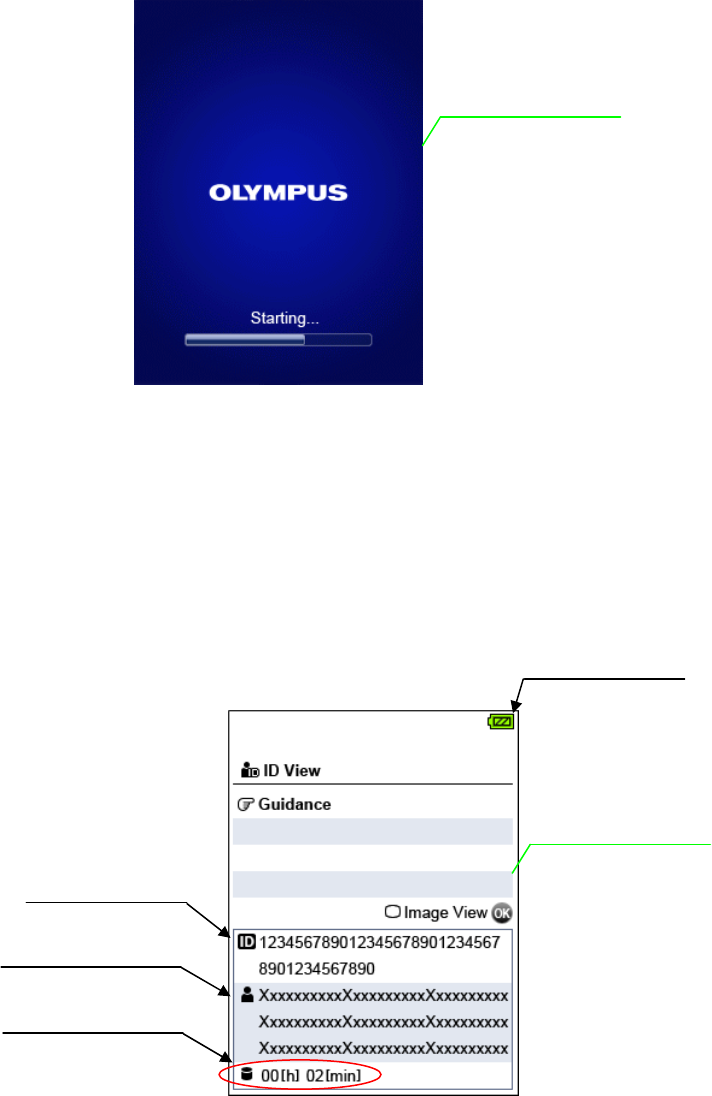
60
OLYMPUS CAPSULE ENDOSCOPE SYSTEM SYSTEM MANUAL
Figure 4.21
4. Confirm the patient’s identity with the patient ID and the patient’s name displayed on the
recorder unit (Refer to Fig 4.22).
Figure 4.22
R
ecording time
Patient Name
Patient ID
ID View screen
Battery icon
Starting screen

OLYMPUS CAPSULE ENDOSCOPE SYSTEM SYSTEM MANUAL
61
• If the Battery icon is orange, the battery may run out before 12 hour. Recharge
the battery pack, or replace with a fully-charged battery pack.
• Start the examination immediately after turning the recorder unit ON. Failure to
do so may result in premature termination of the examination due to an empty or
low battery.
• If any of error messages are appeared on the display panel, refer to
“Troubleshooting”.
• The recording time is displayed at the lower left of the display panel. Recording
time is displayed when data are remained without being downloaded.
Download such data and initialize the recorder unit if necessary.
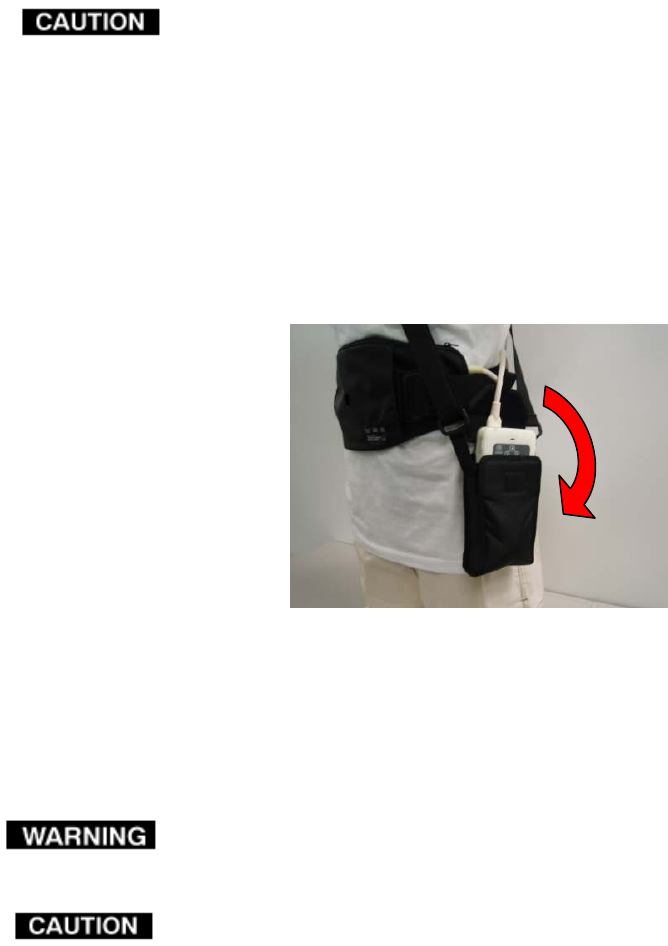
62
OLYMPUS CAPSULE ENDOSCOPE SYSTEM SYSTEM MANUAL
I
Inserting the Recorder Unit in the Recorder Unit Harness
• Attach the antenna unit and the recorder unit so that antenna cable is not caught on things
such as a knob of a door. Otherwise it may damage the antenna unit and/or the recorder
unit and may result in failure of the examination.
• Attach the antenna unit and the recorder unit so that antenna cable is not laid on or near
the antenna sheet. It may prevent the proper reception of images.
1. Insert the recorder unit into the pouch of recorder unit harness and close the pouch
cover. ( Refer to Figure 4.23) Please attach them so that an antenna cable is
between the body of the patient and the suspenders of the recorder unit.
Figure 4.23
4.3 Preparing the capsule endoscope
• Do not use capsule endoscopes that have been dropped, bitten, or been subjected to
excessive pressure. Doing so may result in an infection control risk as well as cause
injury to the patient due to damage to the capsule endoscope.
• Inspect the sterile package before you open it. If it is already opened or damaged, the
sterility of the capsule endoscope may have been compromised. Use a new capsule
endoscope instead.
• To prevent the capsule endoscope battery from deteriorating, store the capsule
endoscope under a temperature of 0 – 25°C (32 – 77°F). Do not store in a refrigerator or
a freezer, as condensation inside of the top cover may result.
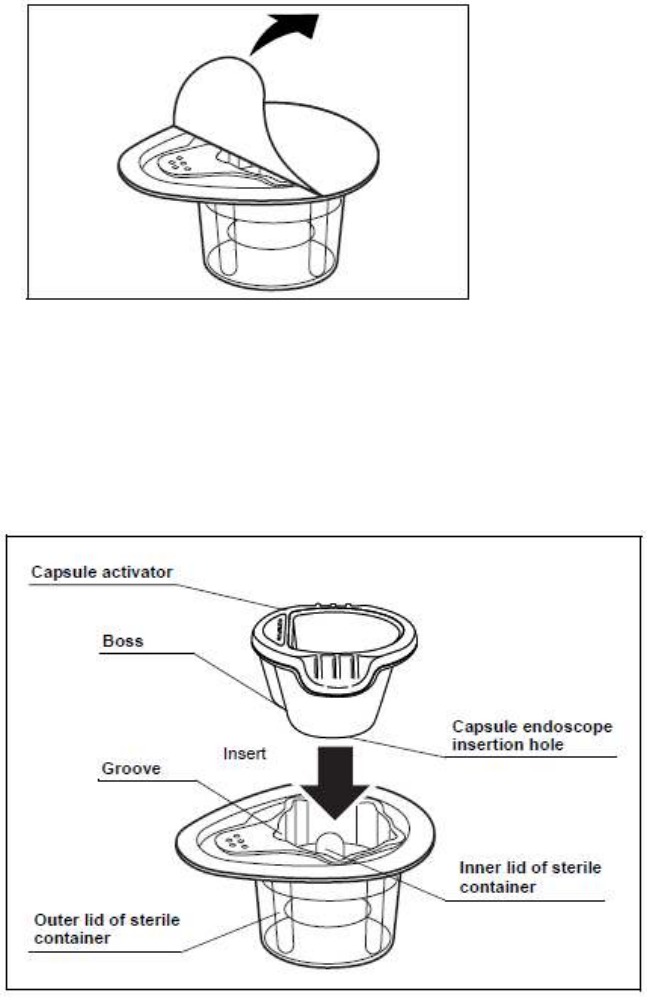
OLYMPUS CAPSULE ENDOSCOPE SYSTEM SYSTEM MANUAL
63
Turning the power ON
1.
Check the expiration date.
2.
Slowly remove the sealing paper and take care that the capsule endoscope does not
fall out of the container.
Figure 4.24
3.
Hold the sterile container, taking care not to squeeze it. Adjust the direction of the
activator’s boss to the closest groove to the handle of the inner lid of the sterile
container. Insert the capsule activator straight along with the groove. The capsule
endoscope will turn ON (see Figure 4.25). When the capsule endoscope is turned ON,
the LED illuminates.
Figure 4.25

64
OLYMPUS CAPSULE ENDOSCOPE SYSTEM SYSTEM MANUAL
• The capsule activator is not sterilized. Do not allow the
capsule endoscope to touch the activator.
• Keep the capsule endoscope away from DC magnetic fields
such as magnets. Magnets can turn the capsule endoscope
ON, resulting in the consumption of battery power.
• Do not look directly at the capsule endoscope’s LED for a
prolonged duration. You may feel dizzy due to the afterimage.
Inserting the capsule activator again will turn the capsule
endoscope OFF.
OLYMPUS CAPSULE ENDOSCOPE SYSTEM SYSTEM MANUAL
65
Confirming Operation
Confirm the operation of the capsule endoscope according to the following steps.
1. Bring the capsule endoscope in the sterile container close to the antenna sheet (the
patient’s abdomen).
2. Confirm that the receiving lamp of the recorder unit blinks green.
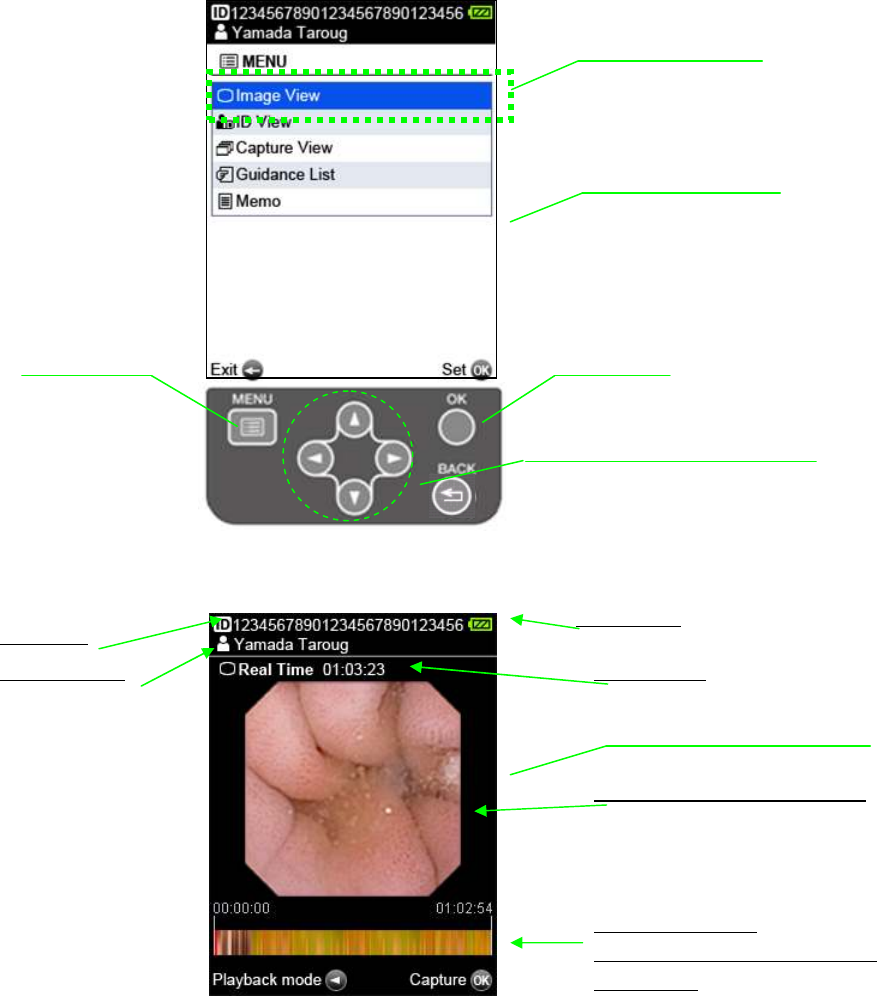
66
OLYMPUS CAPSULE ENDOSCOPE SYSTEM SYSTEM MANUAL
Confirming image
You can confirm if the image transmitted from capsule endoscope by Image View screen.
1. Push the “MENU” button to display the Menu screen.
2.Choose the “Image View” by pushing “Cursor” button, and push “OK” button.(Refer to
Figure 4.26)
The capsule endoscope image is displayed on the Image View screen. (Refer to Figure
4.27)
Fig 4.26
Fig 4.27
Patient ID
Patient NAME
Battery icon
Present time
The capsule endoscope image
Average color bar:
Display the average color of the
image data.
“Image View”
“MENU” button “OK” button
Cursor button
“
”
,
“
”
,
“
⊳
”
,
“
”
MENU screen
Image View screen
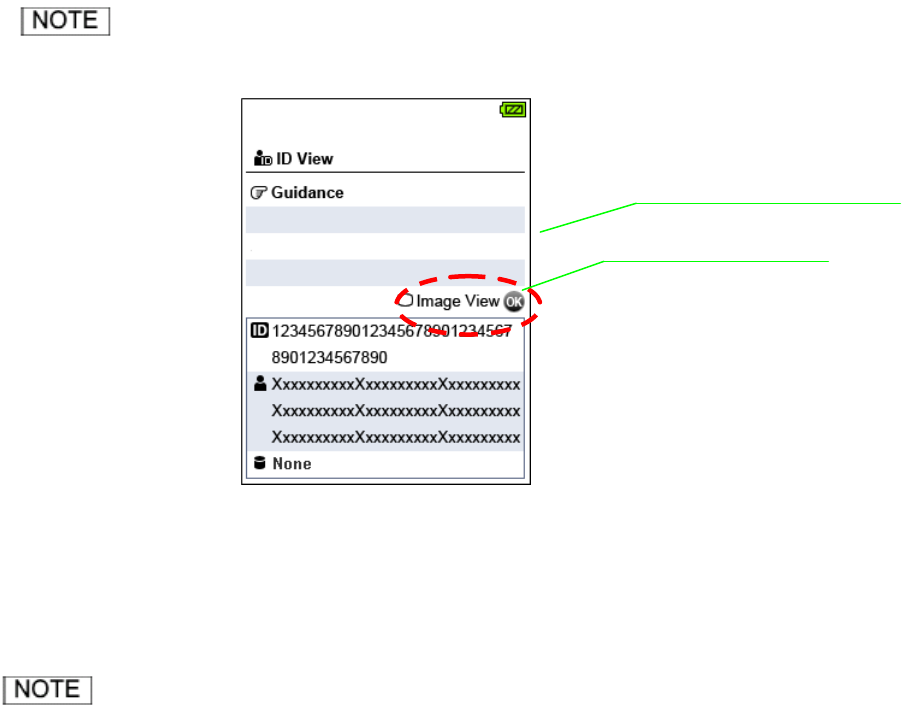
OLYMPUS CAPSULE ENDOSCOPE SYSTEM SYSTEM MANUAL
67
When the ID View screen with Image View icon (Refer to Figure 4.28) is
displayed, Image View screen can be displayed with the pushing “OK”
button.
Figure 4.28
• When approximately two minutes pass, the display panel of the
recorder unit turn off.
• When “MENU” button is pushed, the MENU screen is displayed.
• When “Back” button is pushed, the previous screen is displayed.
•
You can capture a displaying image with the pushing the “OK” button.
Refer to the “Capture of the image”.
• Do not touch the display panel with Image View screen. You may not
operate the recorder unit normally.
ID View screen
ID View icon
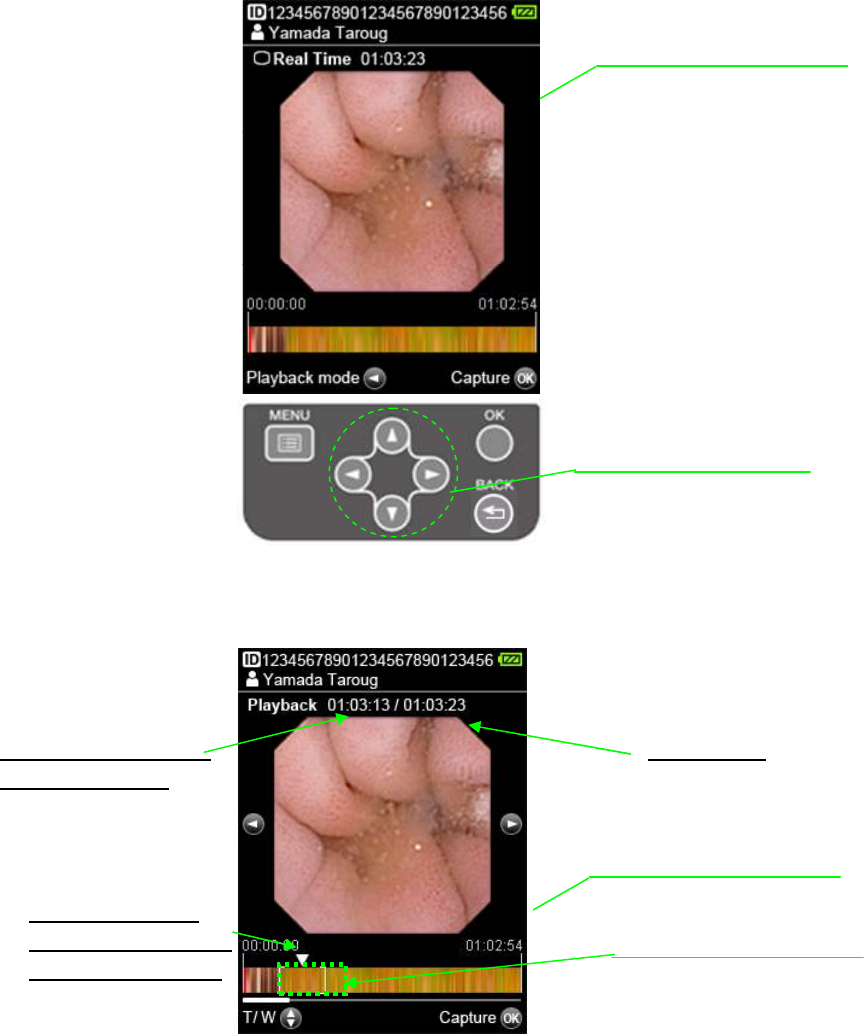
68
OLYMPUS CAPSULE ENDOSCOPE SYSTEM SYSTEM MANUAL
Confirming the recorded image
You can display recorded images on Playback mode of the Image View screen.
1. Push the “MENU” button to display the Menu screen.
Choose the “Image View” by pushing “Cursor” button, and push “OK” button.
The capsule endoscope image is displayed by Image View screen.
2. Push the ”⊳” on Image View screen shown below. (See Figure 4.29)
As shown figure 4.30, a stored image is displayed by playback screen.
Fig 4.29
3. You can confirm the image after one piece by pushing ”⊳” one piece ago by pushing ””.
Fig4.30
Cursor button
“
”, “”, “⊳” , “”
Image View screen
The position of the
image displayed nowin
the average color bar.
The time when the
image is recorded
Present time
Image View screen
(Playback mode)
Expansion area

OLYMPUS CAPSULE ENDOSCOPE SYSTEM SYSTEM MANUAL
69
• Expansion and the reduction of the average color bar are possible by pushing
“”or ””.
The average color bar can display three following conditions.
― All mode displays the average color bar of all images which are stored.
― 1hour mode displays 30 minutes before and after an image chosen.
(Displays average color bar of 1 hour.)
― 10 minutes mode displays 5 minutes before and after an image chosen.
(Displays average color bar of 10 minutes.)
• You can choose 30 minutes before and after image by pushing the “⊳” or“”
in all mode.
• You can choose 5 minutes before and after image by pushing in the“⊳” or“”
in 1 hour mode.
• You can choose 5 minutes before and after image by pushing in the“⊳” or“”
in 10 minutes mode.
•You can rewind or fast forward when keep pushing in the“⊳” or“” in 10
minutes mode.
• “[]” shows the spreading range in average color bar.
• When approximately two minutes pass, the display panel of the recorder
unit turn off.
• When “MENU” button is pushed, the MENU screen is displayed.
•
When “Back” button is pushed, the previous screen is displayed.
•
You can capture a displaying image with the pushing the “OK” button.
Refer to the “Capture of the image”.
• Do not touch the display panel with Image View screen. You may not operate
the recorder unit normally.
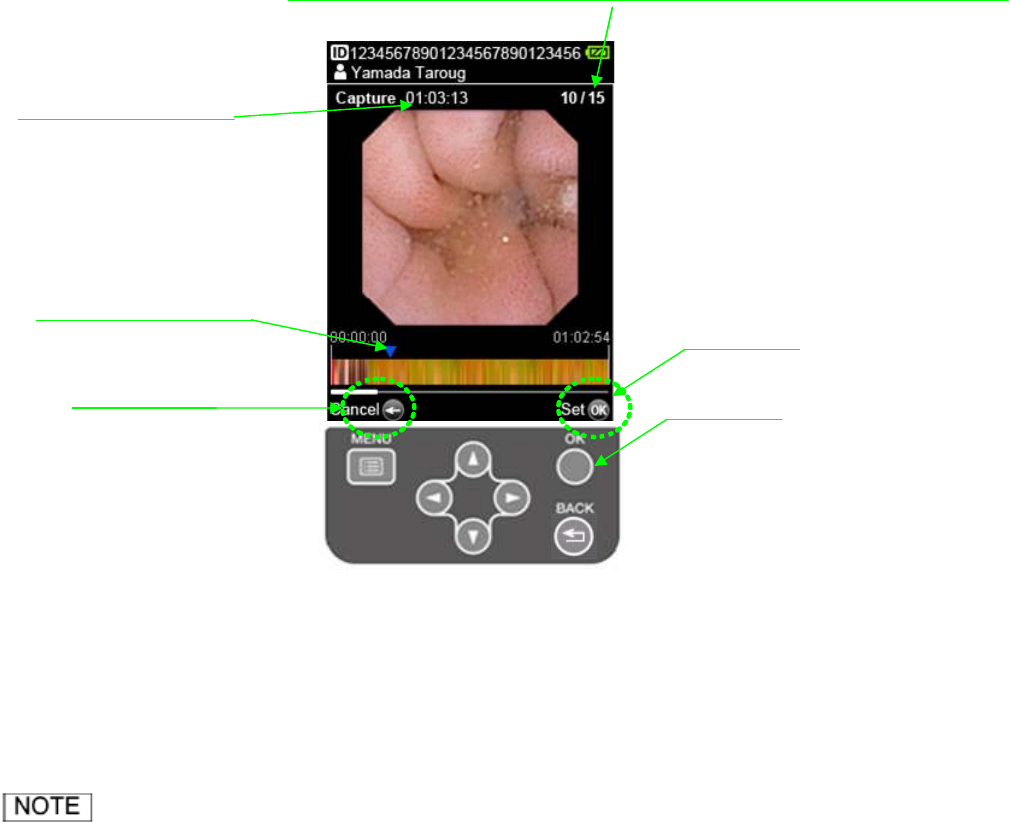
70
OLYMPUS CAPSULE ENDOSCOPE SYSTEM SYSTEM MANUAL
Capture of the image
During Image View screen is displayed, you can capture the image shown on the screen.
1. Push “OK” button when the image to be captured is displayed.
Such screen as in the Figure 4.31 is displayed. Set icon and Cancel icon are displayed in
the screen.
Figure 4.31
2. Push “OK” button to capture images. When you do not capture it, push “BACK”
button.
After operation, the recorder unit displays Image View screen.
• The display panel of the recorder unit turns off approximately two
minutes after the last operation.
・When “MENU” button is pushed, the MENU screen is displayed.
・
When “Back” button is pushed, the previous screen is displayed.
・Max 15 images are captured.
Selection image time
number of images already captured / max number of images to be captured
A position of the
captured image on
average color bar
“OK” button
Set icon
Cance
l icon
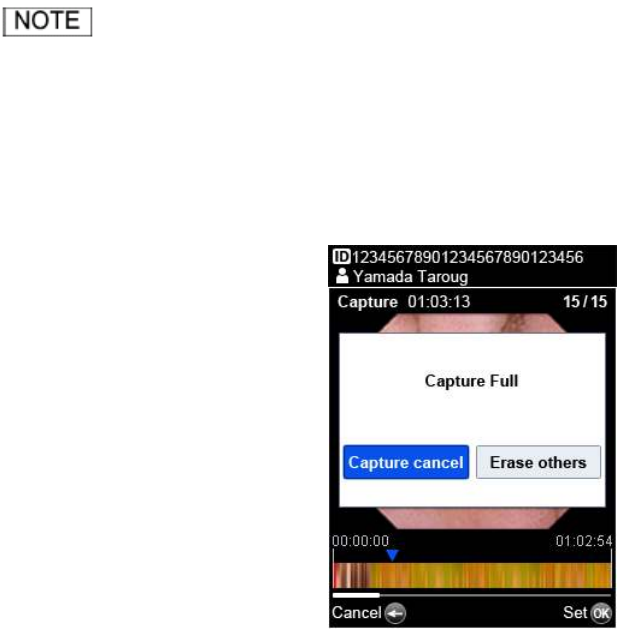
OLYMPUS CAPSULE ENDOSCOPE SYSTEM SYSTEM MANUAL
71
・When number of the capture image exceeds 15, Figure 4.32 is displayed.
Choose “Capture cancel” to stop capturing image or “Erase others” to capture
more image by ”⊳”,”” and “OK” button.
・
When you choose “Erase others”, Capture list is displayed. Please refer to
cancellation method “capture for the later operation.”
Figure 4.32
• Do not touch the display panel with Image View screen. You may not operate
the recorder unit normally.
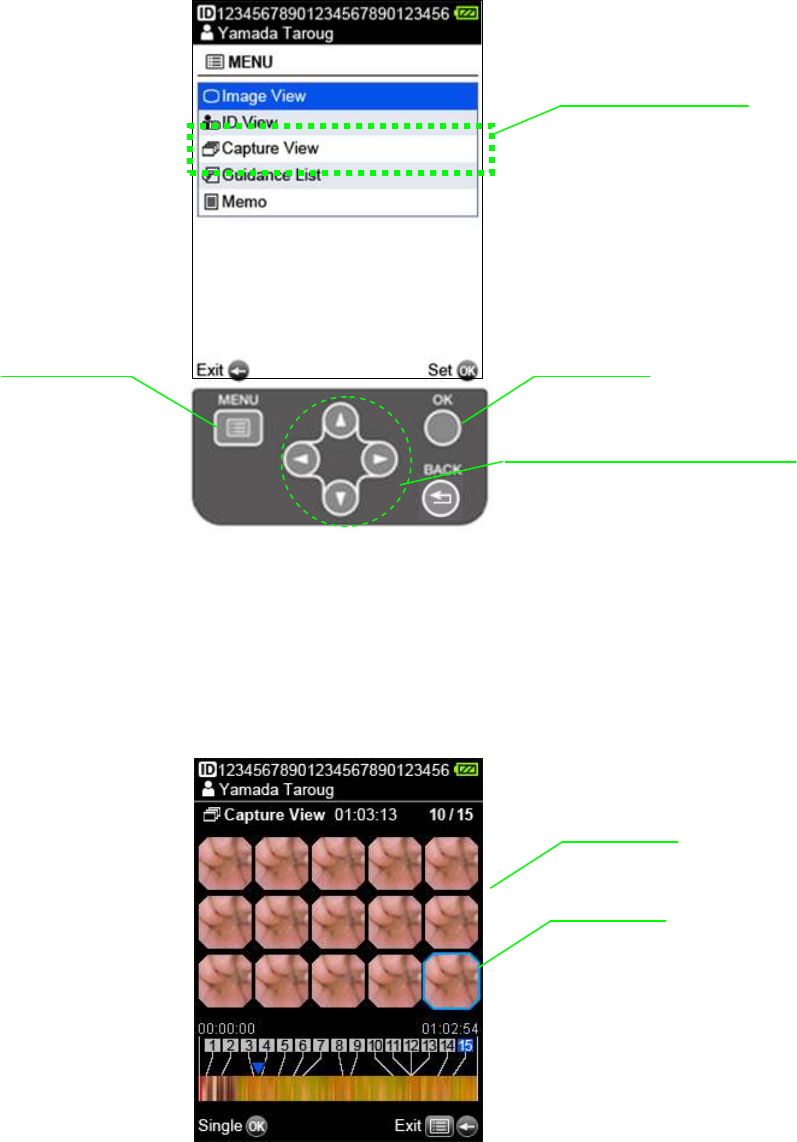
72
OLYMPUS CAPSULE ENDOSCOPE SYSTEM SYSTEM MANUAL
Confirming capture image
You can confirm the image which is captured by following operation from Capture list.
1. Push “MENU” button to display Menu screen.
2. Choose “Capture View” and push “OK” button on MENU screen.
Figure 4.33
3. The images which are captured are displayed. The chosen image is surrounded in a
blue line.(Refer to Figure 4.34)
Choose an image using Cursor button.
Figure 4.34
“Capture View”
“MENU” button “OK” button
Cursor button
“
”
,
“
”
,
“
⊳
”
,
“
”
Capture List
Selection image
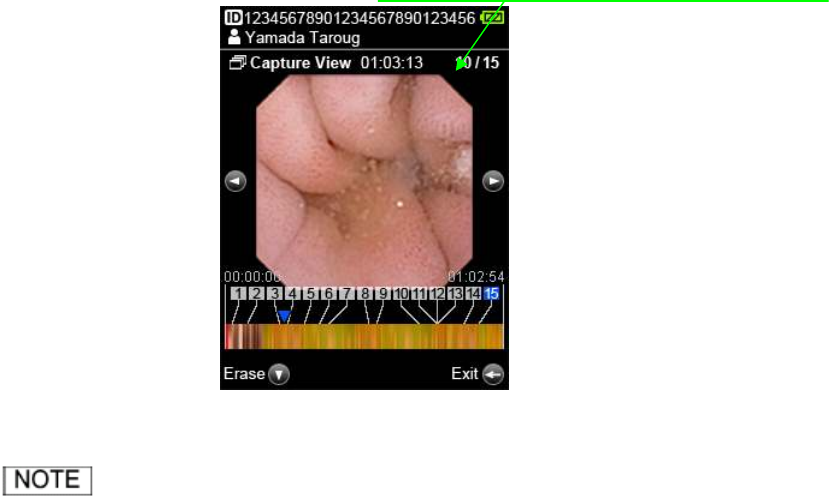
OLYMPUS CAPSULE ENDOSCOPE SYSTEM SYSTEM MANUAL
73
4. The image which you choose is displayed when push “OK” button. (Refer to
Figure4.35)
You can display previous and following images by pushing a “⊳”, ””.
Figure 4.35
・The display panel of the recorder unit turn off approximately two
minutes after the last operation.
・When “MENU” button is pushed, the MENU screen is displayed.
・
When “Back” button is pushed, the previous screen is displayed.
・ Image capture is cancelled by pushing with screen ”” on the screen
of the Figure 4.35. Please refer to “Cancellation of the capture”.
・ You can view the image which is captured by the recorder unit on
Workstation.
number of the capture image/ capture possibility number of sheets
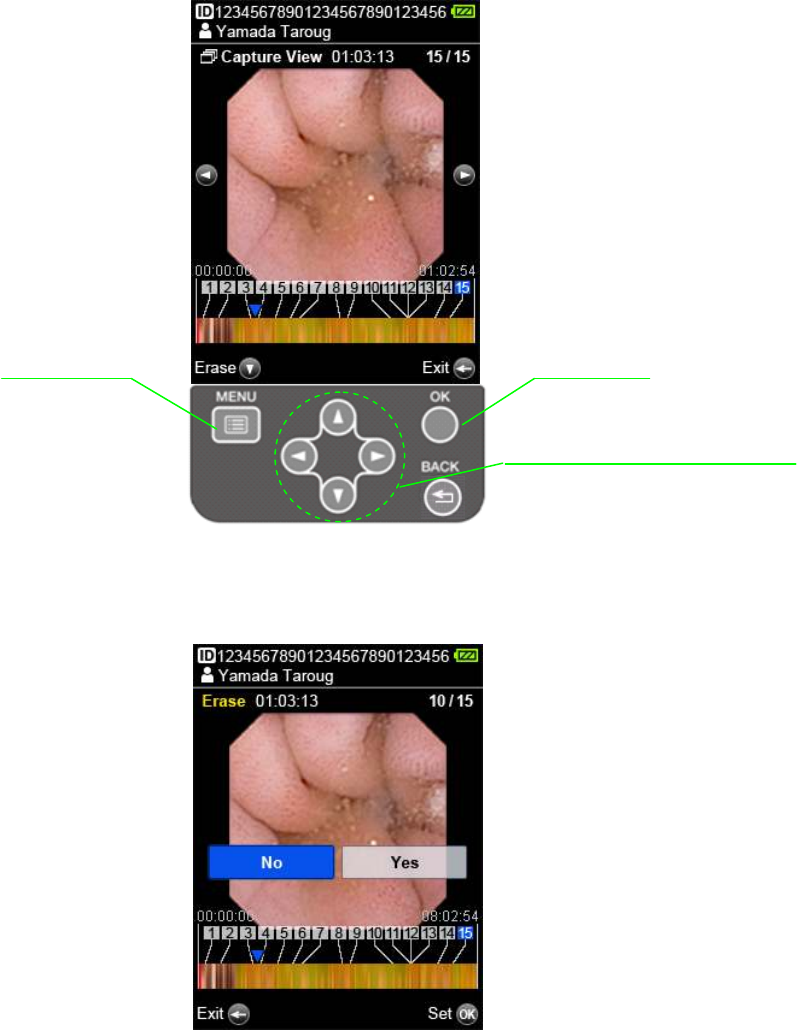
74
OLYMPUS CAPSULE ENDOSCOPE SYSTEM SYSTEM MANUAL
Cancellation of the captured image
By the following operation, cancellation of the capture is possible.
1. Choose an image to erase from Capture list and push "OK" button.
2. Push ”” when the captured image which you choose is displayed on the screen.
Fig 4.36
3. Choose "Yes" and push "OK" button on the following screen. (Refer to Figure 4.37)
Figure 4.37
“MENU” button “OK” button
Cursor button
“
”, “”, “⊳” , “”

OLYMPUS CAPSULE ENDOSCOPE SYSTEM SYSTEM MANUAL
75
・The display panel of the recorder unit turn off approximately two
minutes after the last operation.
・When “MENU” button is pushed, the MENU screen is displayed.
・
When “Back” button is pushed, the previous screen is displayed.
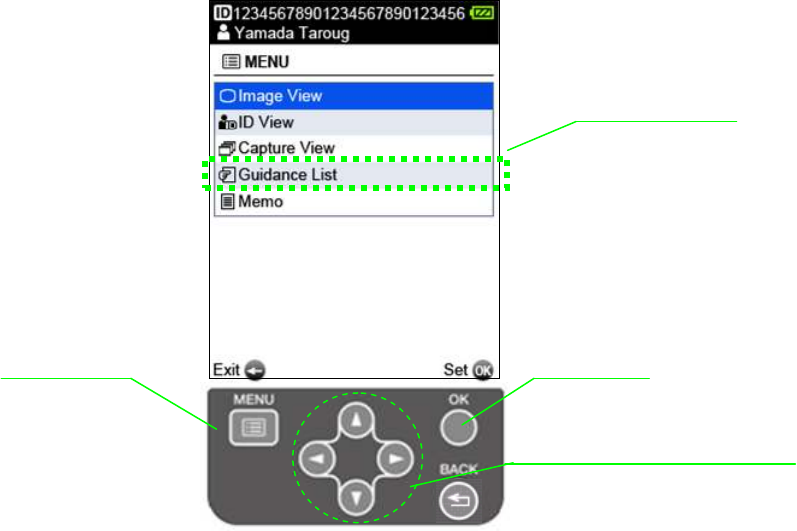
76
OLYMPUS CAPSULE ENDOSCOPE SYSTEM SYSTEM MANUAL
Confirming the guidance
The recorder unit gives guidance to a patient during the examination by registering
patient and examination data in Workstation.
By the following operation, guidance to a patient is displayed.
1. Push “MENU” button to display MENU screen.
2. Choose the “Guidance List” by the Cursor button, and push “OK” button. (Refer to Figure
4.38)
Figure 4.38
“Guidance List”
“MENU” button “OK” button
Cursor button
“
”
,
“
”
,
“
⊳
”
,
“
”
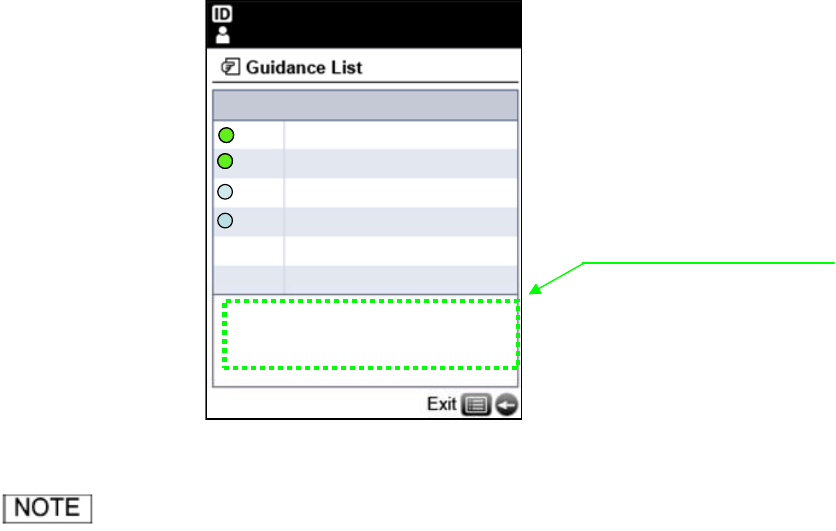
OLYMPUS CAPSULE ENDOSCOPE SYSTEM SYSTEM MANUAL
77
3. Guidance List is displayed. (Refer to Figure 4.39)
Please call a nurse.
You can take a light meal.
Please come back to the procedure
room.
09:00
10:00
12:00
16:00 Please Come back to the h
Please come back to the p
Please call a nurse.
You can take a light meal.
Please come back to the procedure
room.
09:00
10:00
12:00
16:00 Please Come back to the h
Please come back to the p
Please call a nurse.
You can take a light meal.
Please come back to the procedure
room.
09:0009:00
10:0010:00
12:00
16:00 Please Come back to the h
Please come back to the p
Figure 4.39
・If the guidance has already been given, the icon shown beside the time
green from white.
・The latest guidance is displayed in the lower part of the screen. (Refer
to Figure 4.39)
・When “MENU” button is pushed, the MENU screen is displayed.
・When “Back” button is pushed, the previous screen is displayed.
・The display panel of the recorder unit turn off approximately two
minutes after the last operation.
The latest guidance
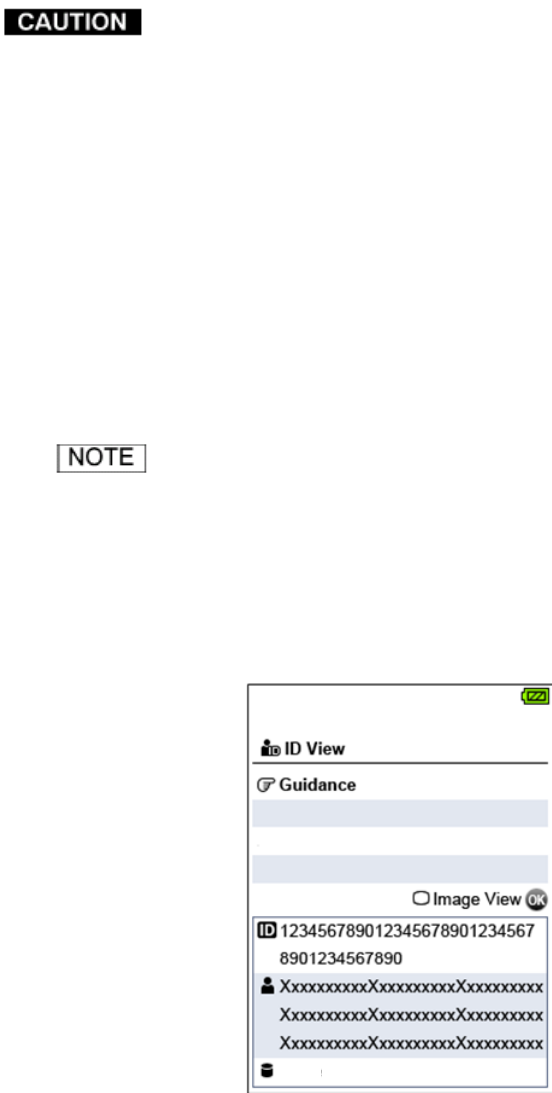
78
OLYMPUS CAPSULE ENDOSCOPE SYSTEM SYSTEM MANUAL
Handling the recorder unit when guidance is given
・Instuct the patient not to operate the recorder unit other than guidance
occurs and to stop beep and vibration.
・Instruct a flow of the examination to the patient to patient cope even if a
patient does not notice guidance.
1. Instruct a patient how to stop beep and vibration of guidance by pushing “OK” button
when guidance is given.
2. ID View screen is displayed when guidance is given. Instruct patient to confirm the
guidance after stopping beep and vibration.
・The beep and vibration of the guidance stop automatically 30 seconds later.
・The latest guidance information is displayed on the ID View screen. (Refer
to figure 4.40)
01[h] 00[min]
Please come back to the procedure
room.
01[h] 00[min]01[h] 00[min]
Please come back to the procedure
room.
Figure 4.40
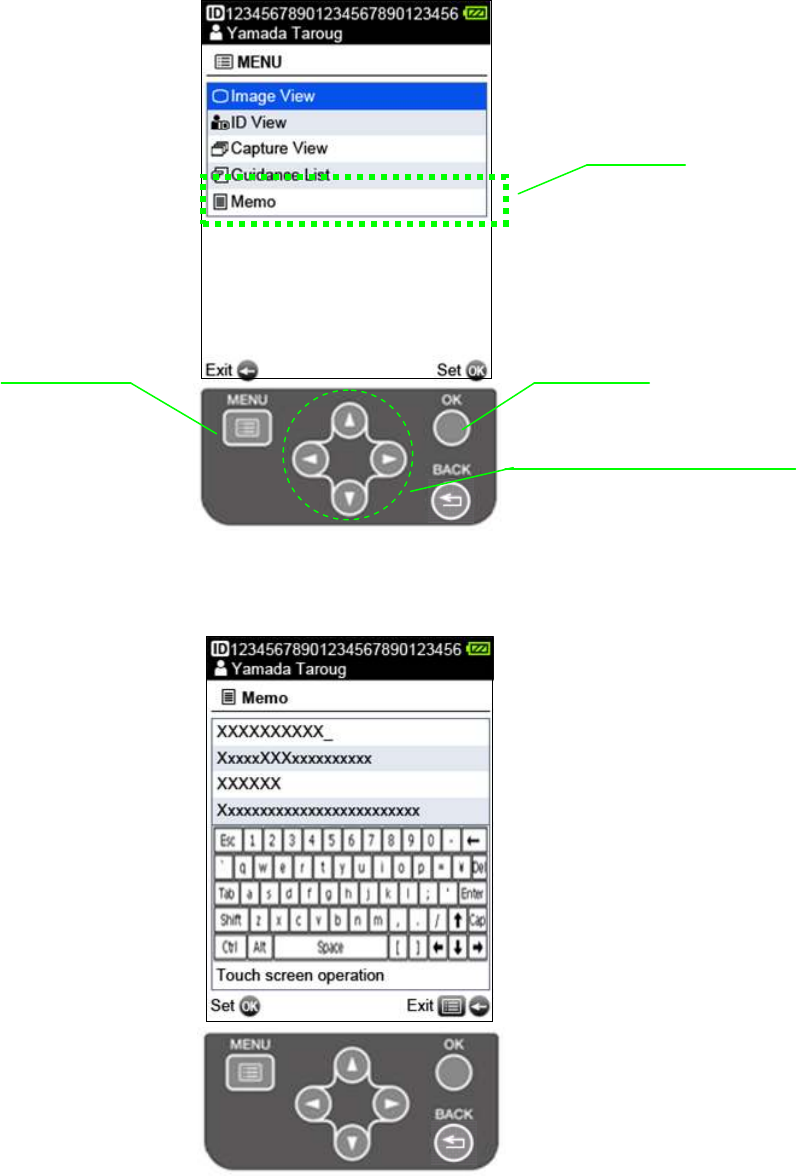
OLYMPUS CAPSULE ENDOSCOPE SYSTEM SYSTEM MANUAL
79
Confirmation of the memo
You can confirm the memo which is inputted in the recorder unit.
1. Push the “MENU” button.
2. Choose “Memo” by the Cursor button and push “OK” button. (Refer to Figure 4.41)
Figure 4.41
3. Such screen as figure 4.42 is displayed so that you can read the memo.
Figure 4.42
“MEMO”
“MENU” button “OK” button
Cursor button
“
”
,
“
”
,
“
⊳
”
,
“
”

80
OLYMPUS CAPSULE ENDOSCOPE SYSTEM SYSTEM MANUAL
・The display panel of the recorder unit turn off approximately two
minutes after the last operation.
・When “MENU” button is pushed, the MENU screen is displayed.
・
When “Back” button is pushed, the previous screen is displayed.
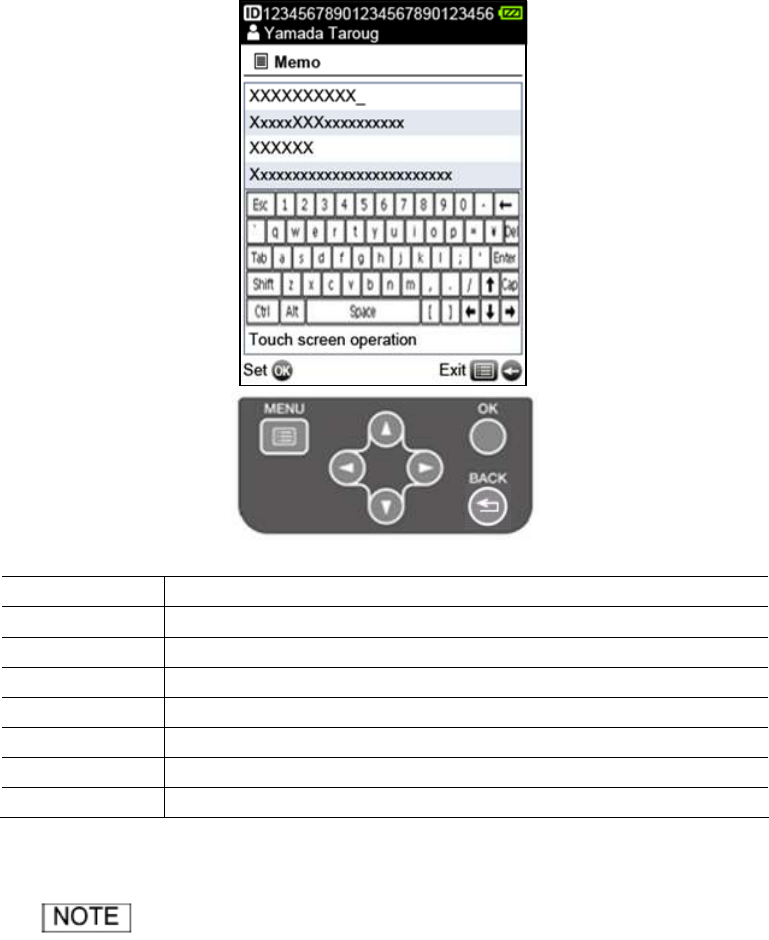
OLYMPUS CAPSULE ENDOSCOPE SYSTEM SYSTEM MANUAL
81
Editing of the memo
You can edit the memo into a recorder unit.
1. Choose the inputting position on the Memo screen by Cursor button.
2. Input a letter by touching it with a keyboard displayed on the screen.
Figure 4.43
Button Function
Press to move cursor up in input.
Press to move cursor down in input.
⊳ Press to move cursor left in input.
Press to move cursor right in input.
OK Save and Exit to Menu screen.
BACK Exit to Menu screen, Memo not saved.
MENU Exit to Menu screen, Memo not saved.
・When “MENU” button is pushed, the MENU screen is displayed.
・You can confirm the memo which is inputted with the recorder unit only. You
can not confirm it in Workstation.

82
OLYMPUS CAPSULE ENDOSCOPE SYSTEM SYSTEM MANUAL
4.4 Starting the examination
Even when the guidance function is used, explain the patient how the
examination is performed, so that the examination can proceed if the patient
fails to be aware of the guidance.
Ingesting capsule endoscope
・The capsule endoscope should only be ingested with water.
Use of other liquids may interfere with the examination.
・Avoid touching the top cover (LED side) of the capsule
endoscope. Do not wipe with gauze or other cloths.
1. Prepare a glass of water
2. Remove the inner case, and hand it to the patient.
3. Confirm that the capsule endoscope’s LED is blinking.
4. Instruct the patient to take the capsule endoscope out of the inner case without touching
the top cover.
5. Instruct the patient to carefully ingest the capsule endoscope with a sip of water.
Confirming Passage
1. If necessary, you can confirm on the Image view screen that the capsule endoscope has
passed through the esophagus and entered the stomach. To display the Image View
screen, follow the instruction of “Confirming image.”
2. If necessary, you can confirm on the Image view screen that the capsule endoscope has
passed through the stomach and entered the duodenum by using the recorder unit If it
takes too long for the capsule endoscope to pass to the duodenum, the battery may run out
before the capsule goes through the entire small intestine.
The passage of the capsule endoscope can be confirmed on the Image View
screen. To display the Image View screen, follow the instruction of “Confirming
image.”

OLYMPUS CAPSULE ENDOSCOPE SYSTEM SYSTEM MANUAL
83
4.5 During the examination
Familiarize the patient with the following warnings and cautions.
Instruct the patient to stay away from equipment that
generates strong electromagnetic fields (such as MRI
equipment), between ingestion and excretion of the capsule
endoscope. Otherwise, injury within the body cavity may
occur. If the excretion of the capsule endoscope has not
been confirmed within 2 weeks from the time of ingestion,
attempt to locate the capsule endoscope within the patient’s
body by X-ray examination.
Instruct the patient to consult their physician immediately if
symptoms such as abdominal pain, discomfort, or nausea
are experienced after ingesting the capsule endoscope. If
treatment of such symptoms is delayed, patient injury may
result.
• Patients with allergies may experience reddening or irritation
of the skin caused by the adhesive on the antenna unit
covers.
• Instruct the patient not to turn the recorder unit’s power OFF,
to push any buttons on the recorder unit, disconnect the
antenna unit, or remove an antenna harness during the examination.
Failure to follow the instructions may interfere with the examination.
• During the capsule endoscope exam instruct the patient to
stay away from generators of strong electromagnetic fields
(such as MRI equipment, amateur (ham) radio, etc.)
otherwise image recording may not occur due to radio
interference.
• Please advise the patients not to use radio transmitting
devices such as keyless entry devices (frequency range of
possible interference: 306 - 322 MHz) or stay in an area
where other persons may use them frequently, in order to
reduce the possibility of dropped video frames caused by the
use of these devices.

84
OLYMPUS CAPSULE ENDOSCOPE SYSTEM SYSTEM MANUAL
• Since the capsule endoscope is a radio-transmitting device, it
could interfere/ or experience interference with other
radio-transmitting devices (e.g., telemetry, keyless entry
devices).
• On rare occasions, interference may result in the need to
repeat the capsule endoscope procedure. In this case, the
physician should advise the patient to stay within the
premises of the medical facility during the examination to
prevent this problem from reoccurring.
• The capsule endoscope contains a radio transmitter;
therefore, the patient cannot fly in an airplane until the
examination is over.
• Do not make a diagnosis using images displayed on the Image View screen.
• Instruct the patient not to operate the recorder unit other than guidance
occurs and to stop beep and vibration.
• Instruct the patient to be careful so that the antenna cable is not caught on a
knob and the lever of the door.
• Instruct a flow of the examination to the patient to patient cope even if a
patient does not notice guidance.
• Instruct the patient to contact the physician or medical personnel, when the
patient dropped the recorder unit during the examination. After having received
the recorder unit, physician or medical personnel push the power button to
restart the recorder unit, and confirm the error message is not displayed.
If error message is not displayed, please continue the examination.
• Please attach the antenna unit to the body firmly, and set the alignment hole of
the antenna harness to the umbilical position. Otherwise, noise may appear in
the images, or the images may not be transmitted properly.

OLYMPUS CAPSULE ENDOSCOPE SYSTEM SYSTEM MANUAL
85
4.6 Ending the examination
Removing equipment
1. About 8 hours after the start of the examination, check that the recorder unit’s
indicator lamp has stopped blinking, and end the examination.
If the indicator lamp is blinking, confirm the image view screen and determine
whether to continue or stop the examination.
2. Take the recorder unit out of the pouch of the recorder unit harness.
In order to prevent damage to the antenna unit and/or
the recorder unit, be sure to hold the connection unit when
disconnecting the antenna unit. Do not disconnect the
antenna unit while holding only the antenna cable.
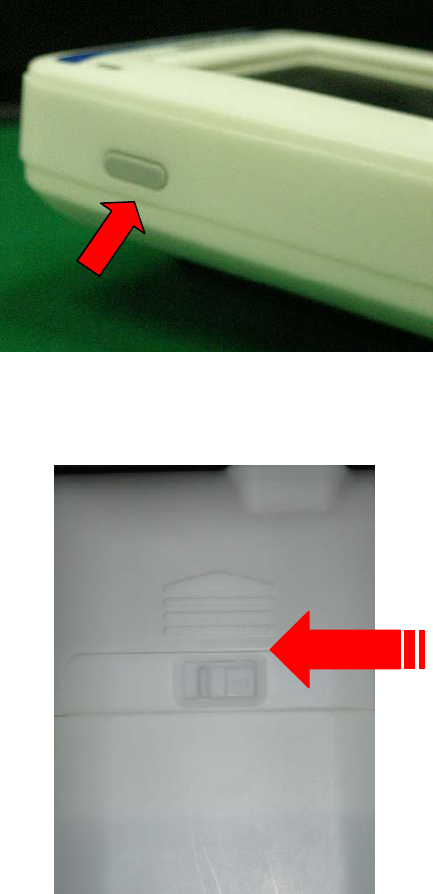
86
OLYMPUS CAPSULE ENDOSCOPE SYSTEM SYSTEM MANUAL
3.
Hold down the recorder unit’s power switch for 2 seconds or more to turn
OFF the recorder unit (see Figure4.44), then disconnect the antenna unit.
Slide the antenna unit eject button on the backside of the recorder
unit, and disconnect the connection unit by sliding it in the direction of the
arrow (Refer to Figure4.45).
Figure 4.44
Figure 4.45
4.
Remove the recorder unit harness from the patient.
5.
Remove the antenna unit from the patient.

OLYMPUS CAPSULE ENDOSCOPE SYSTEM SYSTEM MANUAL
87
Downloading image data
Download the image data from the recorder unit to the workstation according to
the following procedure:
• While downloading, do not remove the recorder unit from the recorder unit
cradle or turn OFF the workstation. Doing so may result in loss of image data.
• While downloading, do not unplug the power cable. Doing so may result in loss
of image data.
• While downloading, do not turn OFF the recorder unit. Doing
so will interrupt the download, and require you to start the
download again from the beginning.
• While downloading, do not remove the recorder unit from the recorder cradle or
remove the USB cable and/or AC adapter. Doing so may result in loss of image
data. If the recorder unit or cradle are disconnected from the workstation, ensure
that the USB cable and AC adapter is connected to the workstation and
reconnect the recorder unit to the workstation through the recorder unit cradle.
Restart the workstation before downloading again.
1.
Check that the recorder unit cradle is connected to the workstation using the USB cable.
2.Turn the workstation ON and log in, as described in “WORKSTATION MANUAL”.
3.
Insert the recorder unit into the recorder unit cradle. The recorder unit will be turned ON
automatically.
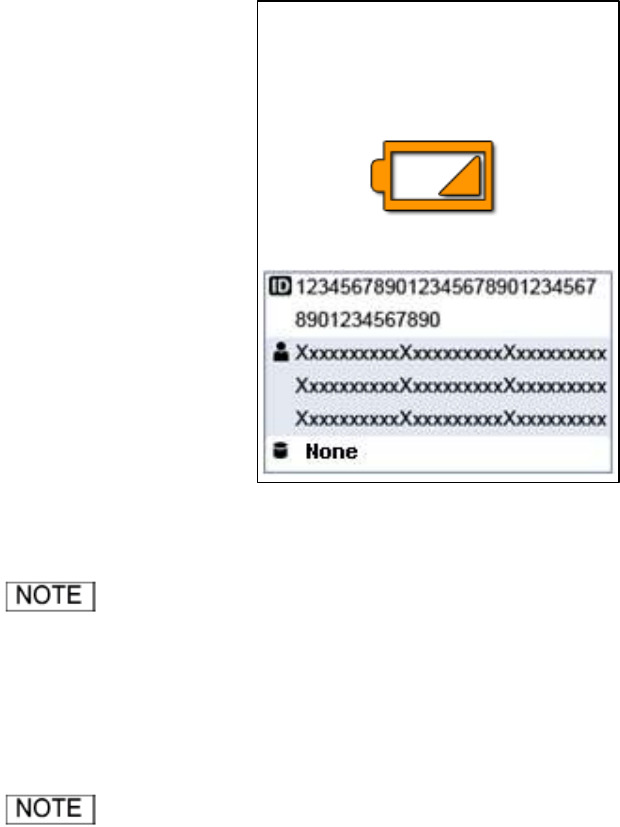
88
OLYMPUS CAPSULE ENDOSCOPE SYSTEM SYSTEM MANUAL
4. The patient’s ID and name are displayed on the recorder unit’s display panel.
Figure 4.46
If an error is detected on the recorder unit, the indicator lamp will blink yellow.
To troubleshoot, refer to Chapter 6, “Troubleshooting”.
5.
The workstation is used to download image data. For specific information on
downloading image data, refer to the “WORKSTATION MANUAL”.
• While downloading the image data, the indicator lamp on the recorder unit turns
from green to yellow and blinks once every second. The recorder unit will be
turned OFF when the download is complete.
• While downloading the image data, the icon in Figure 4.47 is displayed on the
recorder unit’s display panel.
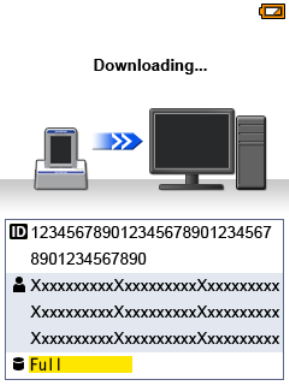
OLYMPUS CAPSULE ENDOSCOPE SYSTEM SYSTEM MANUAL
89
Figure 4.47

90
OLYMPUS CAPSULE ENDOSCOPE SYSTEM SYSTEM MANUAL
Confirming excretion of the capsule endoscope
Familiarize the patient with the following danger.
Instruct the patient to stay away from equipment that
generates strong electromagnetic fields (such as MRI
equipment), between ingestion and excretion of the capsule
endoscope. Otherwise, injury within the body cavity may
occur. If the excretion of the capsule endoscope has not
been confirmed within 2 weeks after ingestion, attempt to
locate the capsule endoscope within the patient’s body by
X-ray examination.
1. The capsule endoscope will be excreted with the patient’s feces.
2
.
Contact the patient to ensure that the patient observes the capsule
endoscope in his/her feces.
Cleaning and storing the equipment
For instructions on cleaning and storing the equipment, refer to Chapter 4,
“Care, Storage and Disposal”.

OLYMPUS CAPSULE ENDOSCOPE SYSTEM SYSTEM MANUAL
91
Chapter 5 Care, Storage and Disposal
5.1 Care
After using the system, immediately perform the following cleaning procedure.
• After wiping with a piece of moistened gauze, dry this system
thoroughly before using it again. If it is used while still wet,
there is the risk of an electric shock.
• During cleaning, wear appropriate personal protective
equipment, such as eye wear, face mask, moisture-resistant
clothing and chemical-resistant gloves that fit properly and
are long enough so that the operator’s skin is not exposed.
Blood, mucous and other potentially infectious material
adhering to this system could pose an infection control risk.
• Do not soak the system components in water, or sterilize
them using autoclave or gas. Doing so will damage the
system.
• Do not wipe the external surfaces with hard or abrasive
wiping material. Doing so will scratch the surface.
• Do not wipe the connector of the recorder unit cradle with wet gauze.
A terminal becomes short and defective, and the charging the
recorder unit and downloading the data may not be possible.
1.
Remove dust, dirt, and other stains on the surface of the antenna unit
using a piece of gauze moistened with a neutral detergent, then wipe the
surfaces using a piece of gauze moistened with70% ethyl or isopropyl alcohol.
2. Remove dust, dirt, and other stains on the surface of the following
equipment using a piece of gauze moistened with a neutral detergent, then
wipe the surfaces using a piece of gauze moistened with 70% ethyl or
isopropyl alcohol. After doing so, dry them thoroughly.
• Recorder unit • Recorder unit cradle
• USB cable • Antenna harness
• Recorder unit harness • Capsule activator
Do not soak the equipment in any liquid.
It may damage the equipment.

92
OLYMPUS CAPSULE ENDOSCOPE SYSTEM SYSTEM MANUAL
・Do not iron or dry clean and do not use a bleach for the recorder unit harness
and antenna harness. Doing so will damage the surface.
Note that machine-washing may cause the recorder unit
harness to shrink slightly.
3
.
If the recorder unit harness becomes wet, be sure to dry it completely.
5.2 Storage
After cleaning the equipment according to the procedure given in Section 4.1,
“Care”, be sure to dry it off thoroughly. When the equipment is dry, place it into its
designated positions in the carrying cases for storage.
Store the carrying cases in a clean and dry location.
For details on storage environment, refer to “Transportation, storage, and
operation environment” on page 99 in the Appendix.
• To prevent the capsule endoscope battery from deteriorating,
store the capsule endoscope within the temperature range of
0 – 25°C (32 – 77°F). Do not store the capsule endoscope in
a refrigerator or a freezer.
・Avoid long term use or storage at temperatures exceeding 40°C (104°F). Battery
pack performance may deteriorate rapidly under these conditions.
• Keep water and any other liquid away from this system and
components. It may cause damage to the system and
components.
• Do not store the system in a location exposed to direct
sunlight, UV rays, X-rays, radio activity, or strong
electromagnetic radiation (e.g. near microwave therapy
equipment, shortwave therapy equipment, MRI equipment,
radios, or mobile phones). Doing so may damage the
system.
• Do not store the system in a location where it may be
subjected to impacts or excessive vibrations. Doing so may
damage the system.
• Do not store the capsule endoscope in a location where it
may be accessed and/or accidentally swallowed by children.
OLYMPUS CAPSULE ENDOSCOPE SYSTEM SYSTEM MANUAL
93
5.3 Disposal
When disposing of any item, follow all applicable national and local laws and
guidelines.
The capsule endoscope is excreted naturally through the patient’s feces.

94
OLYMPUS CAPSULE ENDOSCOPE SYSTEM SYSTEM MANUAL
Chapter 6 Troubleshooting
If, during the inspections described in Chapter3, “Installation and connection” and
Chapter4 “Operation, the system or any of its components appears to have problems,refer
to Section 6.1, “Troubleshooting” to correct the problem.If the problem persists, stop using
the system, and refer to Section 6.2,“Returning the system for repair” to correct the
situation. If the problem cannot be resolved by these countermeasures, contact Olympus.
Never use the system if any abnormality is observed.
Damage to the system or irregularities with the system not
only cause equipment malfunction, but may also cause injury
to the patient’s body cavity.
6.1 Troubleshooting
The following table lists the possible causes of and countermeasures for
problems that may occur due to equipment setting errors or to the deterioration
of replaceable parts. For more information, refer to “Recorder unit error
messages”.
Problems or failures other than those listed in the following table require repair.
Since repairs performed by persons who are not qualified by Olympus could
cause further damage to the equipment and result in operator and/or user injury,
be sure to contact Olympus for repair (refer to Section 6.2).
Irregularity Possible cause Solution
The power is not turned ON.
Use the capsule activator to turn
the power ON.
Capsule
endoscope’s LED
fails to illuminate. The capsule endoscope is
broken.
Use a new capsule endoscope.
The battery pack is missing.
Insert a charged battery pack. Recorder unit’s
power fails to come
ON.
The battery pack is low. Recharge the battery pack.
Recorder unit’s
power lamp fails to
illuminate.
The recorder unit is broken.
Try turning on the recorder unit
power again. If the problem
persists, contact Olympus.

OLYMPUS CAPSULE ENDOSCOPE SYSTEM SYSTEM MANUAL
95
Irregularity Possible cause Solution
The recorder unit is broken.
Contact Olympus.
The capsule endoscope is
broken.
Use a new capsule endoscope.
The antenna cable is
broken.
Contact Olympus.
The antenna unit is not
connected to the recorder
unit.
Connect the antenna unit to
the recorder unit properly.
Images from the
capsule
endoscope are not
displayed by the
Image View screen.
The antenna unit is too
far from the capsule
endoscope.
Reduce the distance between the
antenna and the
capsule endoscope.
The recorder unit
fails to turn OFF.
The power switch is not held
down long enough.
Hold down the power switch for
2 seconds or more.
Display layout is
out of place.
The PC’s DPI setting is not
set to 96DPI or 120DPI.
Right-click on the desktop and
select [Properties].
Select [Settings].
Click on the [Advanced] button.
Set [DPI setting] to either [96DPI]
or [120DPI].
You can not operate the
recorder unit by pushing any
button.
Troubles occur in software
of the recorder unit.
Remove the battery pack from the
recorder unit, and attach it again.
Then turn ON the recorder unit by
pushing the power button.
USB cable or AC adapter is
not connected normally.
Connect USB cable and AC
adapter once again.
WS does not recognize the
recorder unit
The USB cable or AC
adapter is broken.
Contact Olympus
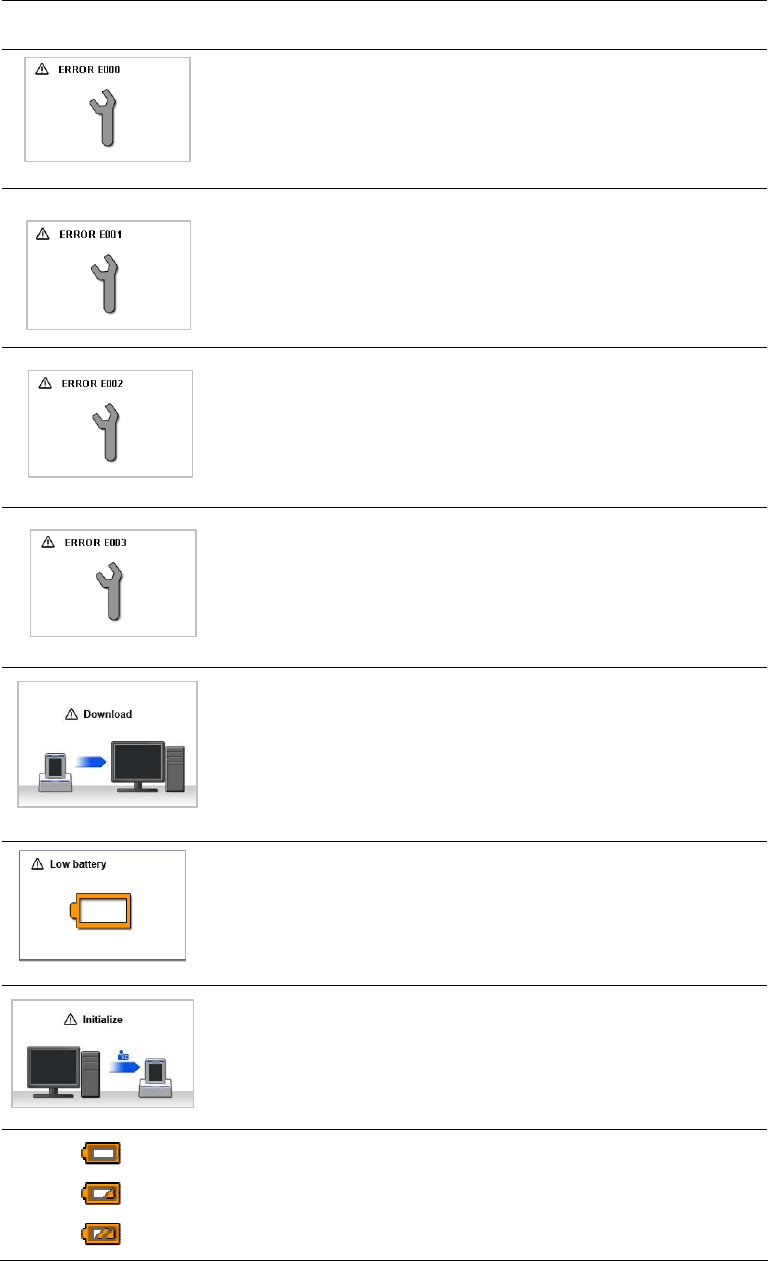
96
OLYMPUS CAPSULE ENDOSCOPE SYSTEM SYSTEM MANUAL
Recorder unit error messages
Error code on recorder
Unit’s display panel
Possible cause Solution
System error 1. Restart the system.
2. If the error persists, contact
Olympus.
Internal memory
error
Contact Olympus.
RTC error
1. Connect the recorder unit to
the workstation, and perform
initialization.
2. If error persists after
initialization, contact Olympus.
Communication error with
the battery pack
1. Replace the battery pack again.
2. Replace with a new battery pack.
Internal memory full Connect the recorder unit to the
workstation, and download the
data from the recorder unit.
Uncharged battery
pack
Recharge the battery pack, or
replace it with a charged battery
pack.
Patient Information
not registered
Connect the recorder unit to the
workstation, and perform
initialization.
Low battery pack Recharge the battery pack.
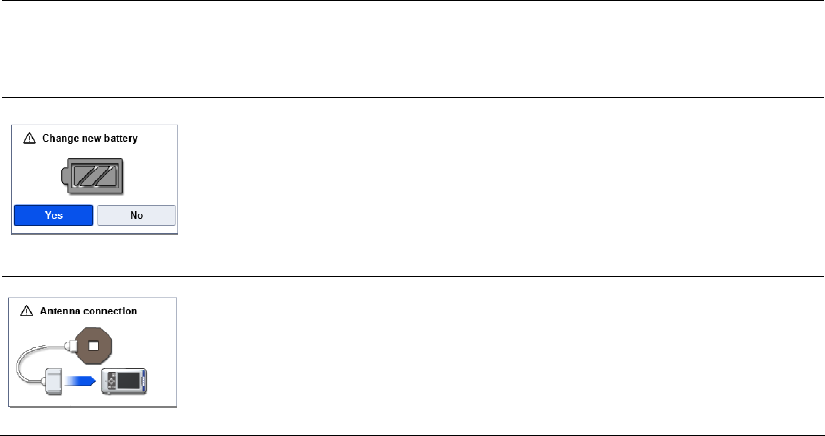
OLYMPUS CAPSULE ENDOSCOPE SYSTEM SYSTEM MANUAL
97
Error code on
recorder
Unit’s display
panel
Possible cause Solution
Time to replace
battery pack∗1
Order a new battery pack from Olympus, and replace
it after the new battery pack arrives.
The recorder unit may not be able to operate for 12
hours
Antenna unit
disconnected
Connect the antenna unit to
the recorder unit.
∗1 The expiration of a battery pack is approximately 1 year from the date of
purchase When the battery pack approaches its end-of-life, the recorder unit will prompt
for replacement. Order a new battery pack and replace.
The battery pack is configured to provide more than 12 continuous
hours of power. Recorder unit does not function with an expired battery
pack.

98
OLYMPUS CAPSULE ENDOSCOPE SYSTEM SYSTEM MANUAL
6.2 Returning the system for repair
Olympus is not liable for any injury or damage occurring as a
result of repairs attempted by non-Olympus personnel.
Before sending the system for repair, contact Olympus. With the system, include
a description of malfunction or damage and the name and telephone number of
the individual at your location who is most familiar with the problem.
Refer to Labels Section in Chapter 1 to easily locate the
model name and serial number when sending equipment to
Olympus for repair.
To purchase accessories and consumables, contact
Olympus.

OLYMPUS CAPSULE ENDOSCOPE SYSTEM SYSTEM MANUAL
99
Appendix
Transportation, storage, and operation environment
Capsule endoscope
Ambient temperature
0 – 25°C (32 – 77°F)∗1
Relative humidity 30 – 85%∗2
Transportation
and storage
environment Barometric pressure
700 – 1060 hPa
(10.2 – 15.4 psia)
Ambient temperature
10 – 40°C (50 – 104°F)
Relative humidity N/A
Operation
environment
Barometric pressure
700 – 1060 hPa
(10.2 – 15.4 psia)
∗1 Storage outside the storage environment range may cause condensation
and/or deterioration of the battery.
∗2 No condensation (inside the capsule endoscope)
Antenna unit
Ambient temperature
–20 to +70°C (–4 to +158°F)
Relative humidity 10 – 95%∗1
Transportation
and storage
environment
Barometric pressure
700 – 1060 hPa
(10.2 – 15.4 psia)
Ambient temperature
0 – 50°C (32 – 122°F)
Relative humidity 30 – 90%∗1
Operation
environment
Barometric pressure
700 – 1060 hPa
(10.2 – 15.4 psia)
∗1 No condensation

100
OLYMPUS CAPSULE ENDOSCOPE SYSTEM SYSTEM MANUAL
Recorder unit
Ambient temperature
–20 to +70°C (–4 to +158°F)
Relative humidity 10 – 95%∗1
Transportation
and storage
environment
Barometric pressure
700 – 1060 hPa
(10.2 – 15.4 psia)
Ambient temperature
0 – 50°C (32 – 122°F)
Relative humidity 30 – 90%∗1
Operation
environment
Barometric pressure
700 – 1060 hPa
(10.2 – 15.4 psia)
∗1 No condensation
Recorder unit cradle
Ambient temperature
–20 to +70°C (–4 to +158°F)
Relative humidity 10 – 95%∗1
Transportation
and storage
environment Barometric pressure
700 – 1060 hPa
(10.2 – 15.4 psia)
Ambient temperature
10 – 40°C (50 – 104°F)
Relative humidity 30 – 85%∗1
Operation
environment
Barometric pressure
700 – 1060 hPa
(10.2 – 15.4 psia)
∗1 No condensation

OLYMPUS CAPSULE ENDOSCOPE SYSTEM SYSTEM MANUAL
101
Battery pack
Ambient temperature
0 – 50°C
(32 – 122°F)
Avoid prolonged storage at
temperatures exceeding 40°C
(104°F).
Relative humidity 10 – 95%∗1
Transportation
and storage
environment
Barometric pressure
700 – 1060 hPa
(10.2 – 15.4 psia)
Ambient temperature
0 – 50°C (32 – 122°F)
Recharging:
0 – 40°C (32 – 104°F)
Discharging:
0 to +50°C (32 to +122°F)
Relative humidity 30 – 90%∗1
Operation
environment
Barometric pressure
700 – 1060 hPa
(10.2 – 15.4 psia)
∗1 No condensation

102
OLYMPUS CAPSULE ENDOSCOPE SYSTEM SYSTEM MANUAL
Recorder unit harness
Ambient temperature
–20 to +70°C (–4 to +158°F)
Relative humidity 10 – 95%
Transportation
and storage
environment Barometric pressure
700 – 1060 hPa
(10.2 – 15.4 psia)
Ambient temperature
0 – 50°C (32 – 122°F)
Relative humidity 30 – 90%
Operation
environment
Barometric pressure
700 – 1060 hPa
(10.2 – 15.4 psia)
∗1 No condensation
Antenna harness
Ambient temperature
–20 to +70°C (–4 to +158°F)
Relative humidity 10 – 95%
Transportation
and storage
environment Barometric pressure
700 – 1060 hPa
(10.2 – 15.4 psia)
Ambient temperature
0 – 50°C (32 – 122°F)
Relative humidity 30 – 90%
Operation
environment
Barometric pressure
700 – 1060 hPa
(10.2 – 15.4 psia)
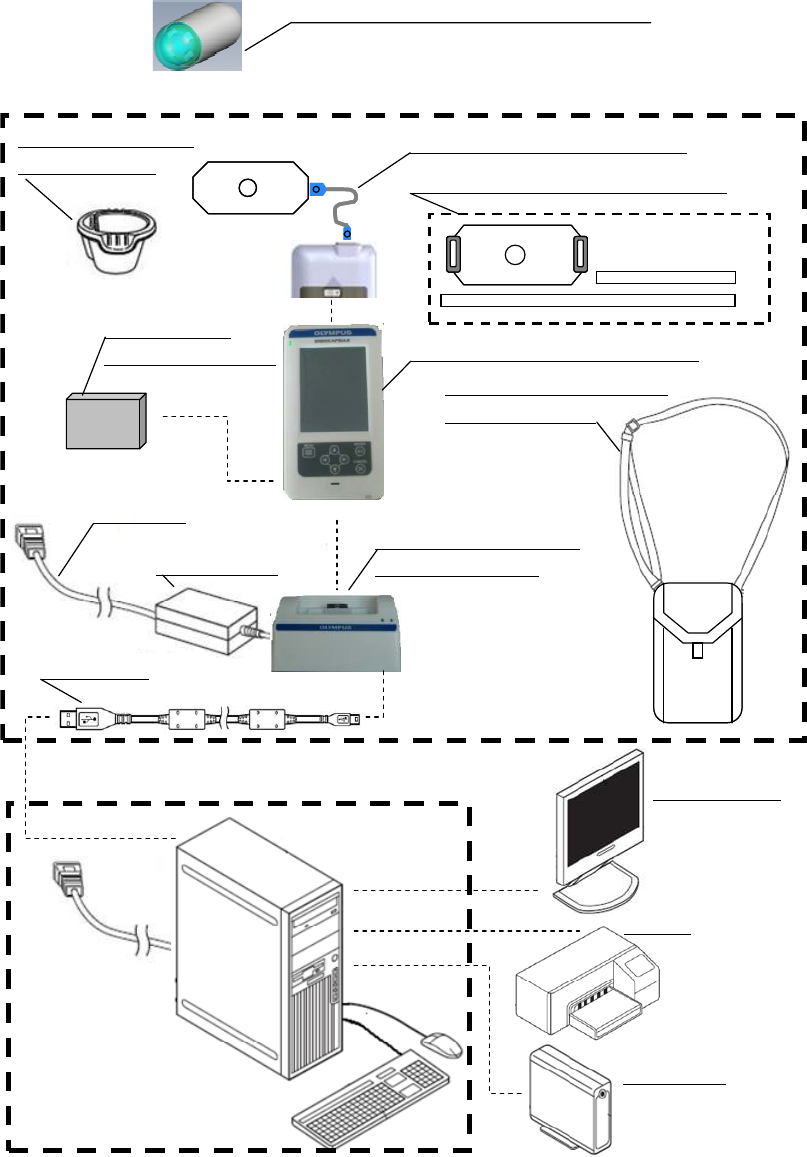
OLYMPUS CAPSULE ENDOSCOPE SYSTEM SYSTEM MANUAL
103
Specifications
System chart
Capsule endoscope ( EC-Y0005)
Antenna unit (X432262-21)
Recorder unit (X432262-11)
Antenna harness (X432252-51)
Recorder unit harness
(X432251-40)
Battery pack
(X432262-11-12)
AC cable
AC adapter
Recorder unit cradle
(X432262-31)
USB cable
Capsule activator
(MAJ-1478)
Workstation (MAJ-Y0134) LCD monitor
Printer
USB HDD
Capsule endoscope system set MAJ-Y0136 (MAJ-Y0136)

104
OLYMPUS CAPSULE ENDOSCOPE SYSTEM SYSTEM MANUAL
The system (components within the bold dotted line) is IEC 60601-1 certified in a
configuration that includes the capsule endoscope, antenna unit, and recorder
unit. The recorder unit cradle, and USB cable, are IEC 60950-1 certified.
• In order to provide the intended functionality, the system
emits RF energy while in operation. This may affect electrical
devices in the vicinity. The patient should keep a distance
from such devices.
• Before the examination, the capsule endoscope is turned on
before it is ingested. This could interfere with other nearby
electrical equipment. To prevent problems, keep the capsule
endoscope away from equipment that is susceptible to RF
interference prior to ingestion.
• This system conducts weak radio communication. Images
may be lost or distorted when operating in an environment
affected by electromagnetic transmissions (such as that of
portable RF (Radio Frequency) communication devices).
Avoid use in such environments.
FCC (for recorder unit , antenna unit, and
Recorder unit cradle)
This equipment has been tested and found to comply with the limits for a
Class B digital device, pursuant to part 15 of the FCC Rules. These limits
are designed to provide reasonable protection against harmful
interference in a residential installation. This equipment generates, uses
and can radiate radio frequency energy and, if not installed and used in
accordance with the instructions, may cause harmful interference to radio
communications. However, there is no guarantee that interference will not
occur in a particular installation. If this equipment does cause harmful
interference to radio or television reception, which can be determined by
turning the equipment off and on, the user is encouraged to try to correct
the interference by one or more of the following measures:
-Reorient or relocate the receiving antenna.
-Increase the separation between the equipment and receiver.
-Connect the equipment into an outlet on a circuit different from that to
which the receiver is connected.
-Consult the dealer or an experienced radio/TV technician for help.

OLYMPUS CAPSULE ENDOSCOPE SYSTEM SYSTEM MANUAL
105
Capsule endoscope
Product name Capsule endoscope
(EC-Y0005)
Field of view (maximum) 160°
Optics
Depth of field 0 – 20 mm
Sampling rate
2 fps
Power supply Power source Internal battery
Battery life 12 hours
Size Dimensions ø 11 (diameter) × 26 (length) mm
Type of protection
against electric shock
Internal power supply
Degree of protection
against electric shock
TYPE BF
Classification
as
medical
electrical
equipment Degree of protection
against explosion
Use under combustible atmosphere
prohibited.
Protection
against fluid
ingress
IEC 60529 IPX-8
EMC Applied standard;
IEC 60601-1-2:2001
This instrument complies with the
standards listed in the left column.
CISPR 11 of emission:
Group 1, Class A
Year of
manufacturer
1712345
The year of manufacture is indicated
by the second digit of the serial
number.
The year of manufacture indicates the serial number of EC-Y0005.
FCC ID :S8QEC-S10 This device comlies with part 15 of
the FCC Rules. Operation is subject
to the following two conditions:
(1)This device may not cause
harmful interference, and (2) this
device must accept any interference
received, including interference that
may cause undesired operation.
IC :4763B-ECS10 This device complies with Industry Canada
licence-exempt RSS standard(s).
Operation is subject to the following
two conditions: (1) this device may
not cause interference, and (2) this
device must accept any
interference , including interference
that may cause undesired operation
of the device.
106
OLYMPUS CAPSULE ENDOSCOPE SYSTEM SYSTEM MANUAL

OLYMPUS CAPSULE ENDOSCOPE SYSTEM SYSTEM MANUAL
107
Recorder unit
Product name Recorder unit (X432262-11)
Power source Battery pack (X432262-11-12)
Voltage 3.7 V
Power supply
Current 500 mA
Battery life 12 hours or longer
Weight 282 g Size
Dimensions 83 (W) × 151 (H) × 32 (D) mm
Type of protection
against electric shock
Internal power supply Classification as
medical electrical
equipment Degree of protection
against explosion
Use under combustible atmosphere
prohibited.
Year of
manufacture
1712345 The year of manufacture is indicated
by the second digit of the serial
number.
EMC Applied standard;
IEC 60601-1-2:2001
This instrument complies with the
standards listed in the left column.
CISPR 11 of emission:
Group 1, Class A

108
OLYMPUS CAPSULE ENDOSCOPE SYSTEM SYSTEM MANUAL
Recorder unit cradle
Product name Recorder unit cradle (X432262-31)
Voltage DC 5V Power supply
Current 3 A
Weight Main body: 345 g (AC Adapter: 175 g) Size
Dimensions 133 (W) × 79 (H) × 84 (D) mm
Type of protection
against electric shock
Class Ⅰ Classification
as
medical
electrical
equipment
Degree of protection
against explosion
Use under combustible atmosphere
prohibited.
Year of
manufacture
1712345 The year of manufacture is indicated
by the second digit of the serial
number.
EMC Applied standard;
IEC 60950-1:2005
This instrument complies with the
standards listed in the left column.
CISPR 22 of emission:
Group 1, Class A

OLYMPUS CAPSULE ENDOSCOPE SYSTEM SYSTEM MANUAL
109
Battery pack
Product name Battery pack (X432262-11-12)
Type Lithium-Ion storage cell
Capacity 2860 mAh
Voltage 3.7 V
Recharging
time
Approx. 2 hours
Weight 70 g Size
Dimensions 70.4 (W) × 10.2 (H) × 55.2 (D) mm

110
OLYMPUS CAPSULE ENDOSCOPE SYSTEM SYSTEM MANUAL
Antenna unit
Product name Antenna unit (X432262-21)
Weight 140 g
Dimensions 83 (W) × 50 (H) × 13 (D) mm
Size
The number of
antennas
8
Degree of protection
against electric shock
TYPE BF Classification as
medical electrical
equipment Degree of protection
against explosion
Use under combustible atmosphere
prohibited.
EMC Applied standards;
IEC 60601-1-2: 2001
This instrument complies with the
standards listed in the left column.
CISPR 11 of emission:
Group 1, Class A

OLYMPUS CAPSULE ENDOSCOPE SYSTEM SYSTEM MANUAL
111
Recorder unit harness
Product name Recorder unit harness
(X432251-40)
Weight 70 g Size
Dimensions 100 (W) × 160 (H) × 37 (D) mm
Antenna harness
Product name Antenna harness (X432252-51)
Weight 180 g Size
Dimensions pouch 350(W)×160(H)mm
Long belt 90(W)×50(H)mm
Short belt 60(W)×50(H)mm

112
OLYMPUS CAPSULE ENDOSCOPE SYSTEM SYSTEM MANUAL
EMC information
〇 Magnetic emission compliance information and
recommended electromagnetic environments
The system (components within the bold dotted line of “System chart” on
page 103) is designed for use under the following electromagnetic environment.
Emission standard Compliance Guidance
RF emissions
CISPR 11
Group 1 This instrument uses RF (Radio Frequency) energy only for its
internal function. Therefore, its RF emissions are very low and are not
likely to cause any interference in nearby electronic equipment.
Radiated emissions
CISPR 11
Main terminal
conducted emissions
CISPR 11
Class A This product is suitable for use in all buildings besides the residence.
Harmonic emissions
IEC 61000-3-2
Voltage
fluctuations/flicker
emissions
IEC 61000-3-3
Not applicable The system is not powered by a commercial power source.
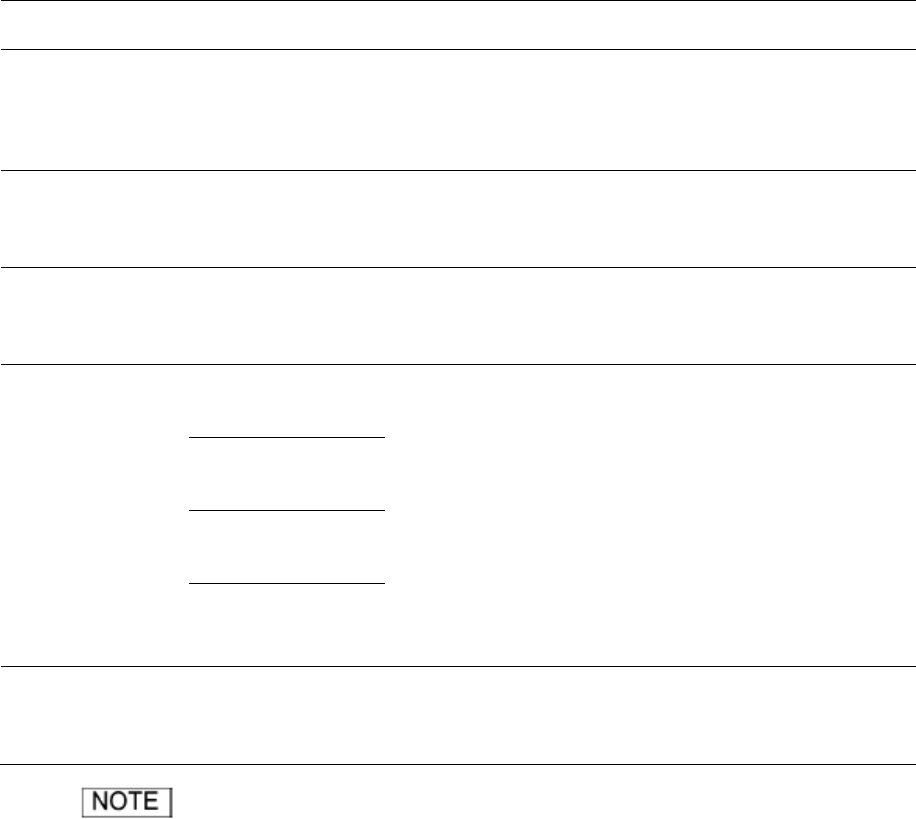
OLYMPUS CAPSULE ENDOSCOPE SYSTEM SYSTEM MANUAL
113
〇 Electromagnetic immunity compliance information and
recommended electromagnetic environments
The system (components within the bold dotted solid line of “System chart” on
page 103) is designed for use under the following electromagnetic environment.
Immunity test
IEC 60601-1-2
test level
Compliance
level
Guidance
Electrostatic
discharge (ESD)
IEC 61000-4-2
Contact:
±2, ±4, ±6 kV
Air:
±2, ±4, ±8 kV
Same as left Floors should be made of wood, concrete, or
ceramic tile that hardly produces static. If
floors are covered with synthetic material that
tends to produce static, the relative humidity
should be at least 30%.
Electrical fast
transient/burst
IEC 61000-4-4
±2 kV
for power supply lines
±1 kV
for input/output lines
Not applicable The system does not have a cable for this
signal.
Surge
IEC 61000-4-5
Differential mode:
±0.5, ±1 kV
Common mode:
±0.5, ±1, ±2 kV
Not applicable The system is not powered by a commercial
power source.
< 5% UT
(> 95% dip in UT)
for 0.5 cycle
40% UT
(60% dip in UT)
for 5 cycle
70% UT
(30% dip in UT)
for 25 cycle
Voltage dips, short
interruptions and
voltage variations
on power supply
input lines
IEC 61000-4-11
< 5% UT
(> 95% dip in UT)
for 5 seconds
Not applicable The system is not powered by a commercial
power source.
Power frequency
(50/60 Hz)
magnetic field
IEC 61000-4-8
3 A/m Same as left It is recommended to use this instrument by
maintaining enough distance from any
equipment that operates with high current.
U
T
is the AC mains power supply prior to application of the
test level.
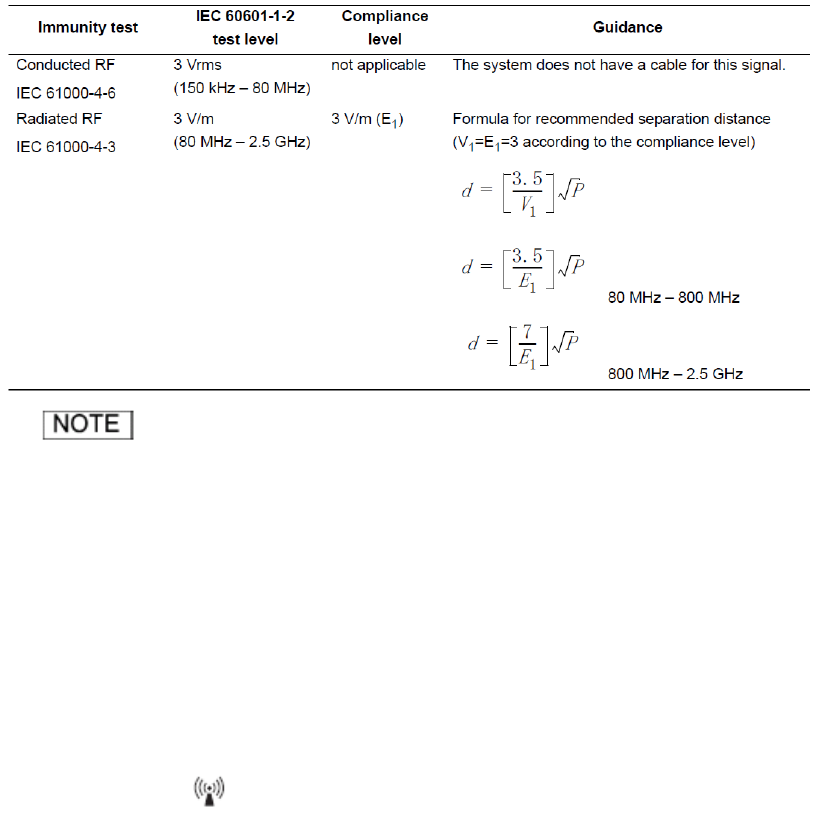
114
OLYMPUS CAPSULE ENDOSCOPE SYSTEM SYSTEM MANUAL
〇 Cautions and recommended electromagnetic environment
regarding portable and mobile RF communications
equipment such as cellular phones
• Where “P” is the maximum output power rating of the
transmitter in watts (W) according to the transmitter
manufacturer and “d” is the recommended separation
distance in meters (m).
• This instrument complies with the requirements of
IEC 60601-1-2: 2001. However, under electromagnetic
environment that exceeds its noise level, electromagnetic
interference may occur on this instrument.
• Electromagnetic interference may occur on this instrument
near a high-frequency electrosurgical equipment and/or other
equipment marked with the following symbol:

OLYMPUS CAPSULE ENDOSCOPE SYSTEM SYSTEM MANUAL
115
○ Recommended separation distance between portable and
mobile RF communications equipment and this instrument
Separation distance according to frequency of transmitter (m)
(calculated as V1=3 and E1=3)
Rated maximum output
power of transmitter P (W)
150 kHz – 80 MHz
80 MHz – 800 MHz
800 MHz – 2.5 GHz
0.01 0.12 0.12 0.23
0.1 0.38 0.38 0.73
1 1.2 1.2 2.3
10 3.8 3.8 7.3
100 12 12 23
The guidance may not apply in some situations.
Electromagnetic propagation is affected by absorption and
reflection from structures, objects and people.
Portable and mobile RF communications equipment such as
cellular phones should be used no closer to any part of this
instrument, including cables than the recommended
separation distance calculated from the equation applicable
to the frequency of the transmitter.
FCC WARNING(for the USA)
Change or modifications not expressly approved by the party responsible for
Compliance could void the user’s authority to operate the equipment.
The shielded interface cable recommended in this manual must be used with
this equipment in order to comply with the limits for a digital device pursuant to
Subpart B of Part 15 of FCC Rules.
1.2√
P
d =
1.2√
P
d =
P
2.3√
d =
Declation of Conformity
Declation of ConformityDeclation of Conformity
Declation of Conformity
Trade Name: OLYMPUS MEDICAL SYSTEMS
Model: X432262-11, X432262-21, X432262-31
Responsible Party: OLYMPUS AMERICA INC.
Address: 3500 Corporate Parkway, P.O. Box 610 Center Valley.
PA 18034-0610, U.S.A
Telephone Number: (484)896-5000
116
OLYMPUS CAPSULE ENDOSCOPE SYSTEM SYSTEM MANUAL
FCC notice
This device complies with part 15 of the FCC Rules. Operation is subject to the
following two conditions: (1) This device may not cause harmful interference, and (2)
this device must accept any interference received, including interference that may
cause undesired operation.
IC notice
This device complies with Industry Canada licence-exempt RSS standard(s).
Operation is subject to the following two conditions: (1) this device may not
cause interference, and (2) this device must accept any interference, including
interference that may cause undesired operation of the device.
Le présent appareil est conforme aux CNR d'Industrie Canada applicables aux
appareils radio exempts de licence. L'exploitation est autorisée aux deux
conditions suivantes : (1) l'appareil ne doit pas produire de brouillage, et (2)
l'utilisateur de
To reduce potential radio interference to other users, the antenna type and its
gain should be so chosen that the equivalent isotropically radiated power
(e.i.r.p.) is not more than that permitted for successful communication.
Afin de réduire le risque d'interférence aux autres utilisateurs, il faut choisir le
type d'antenne et son gain de façon à ce que la puissance isotrope rayonnée
équivalente (p.i.r.e.) ne soit pas supérieure au niveau requis pour l'obtention
d'une communication satisfaisante.
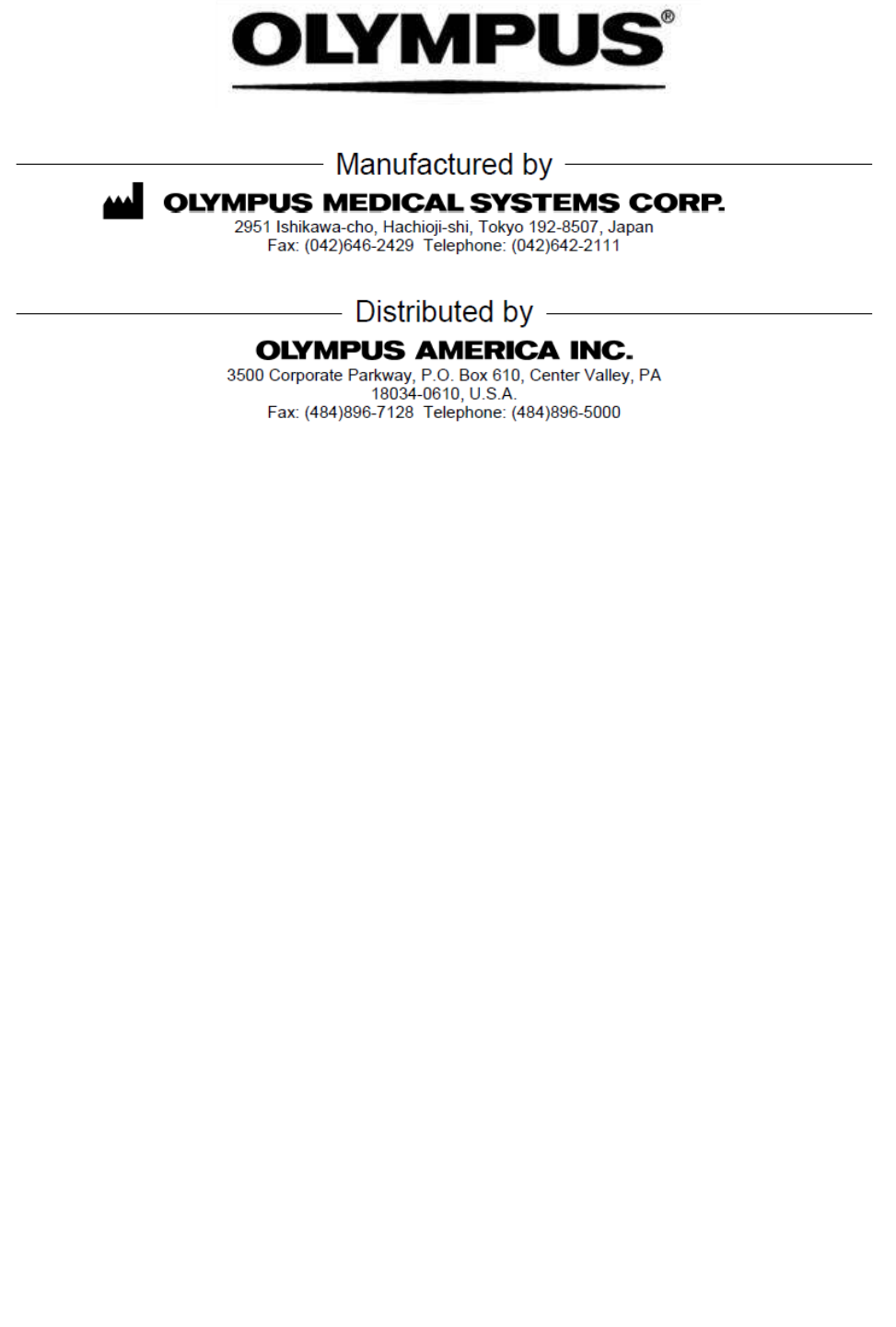
OLYMPUS CAPSULE ENDOSCOPE SYSTEM SYSTEM MANUAL
117
X432262#01